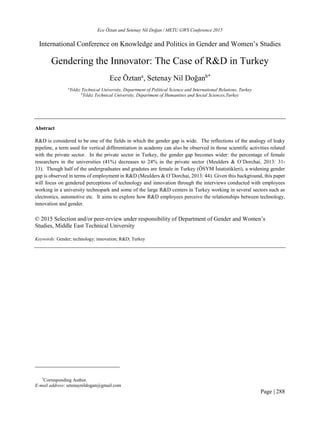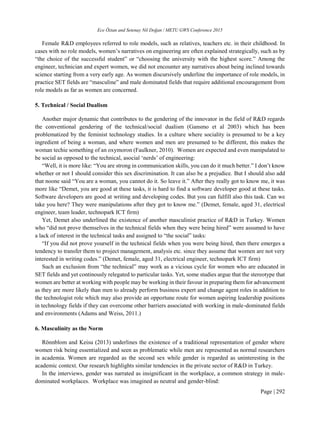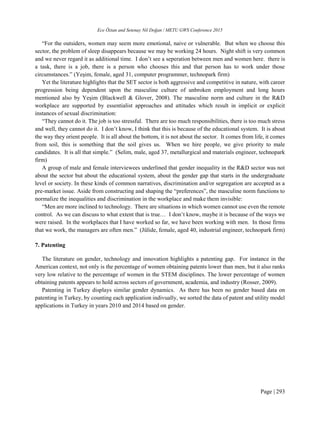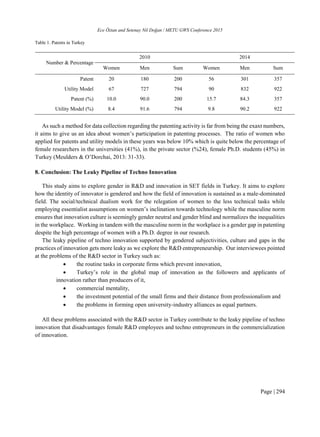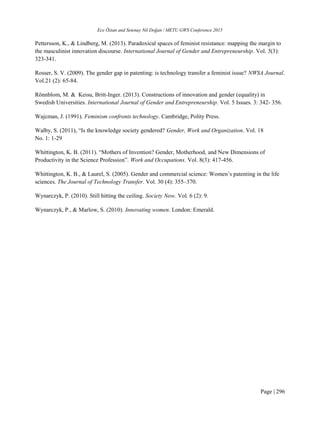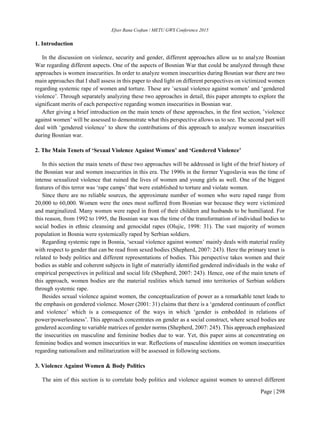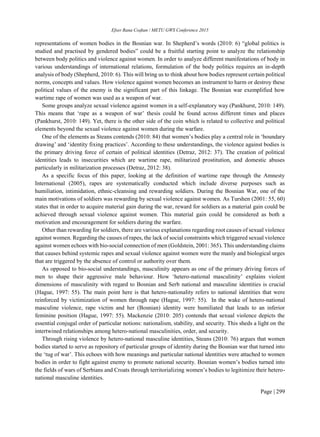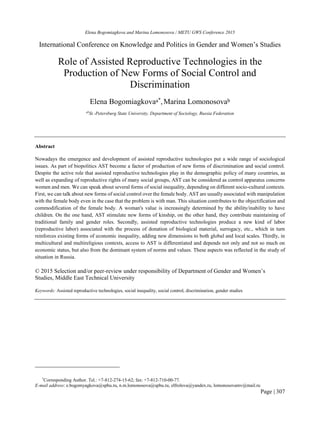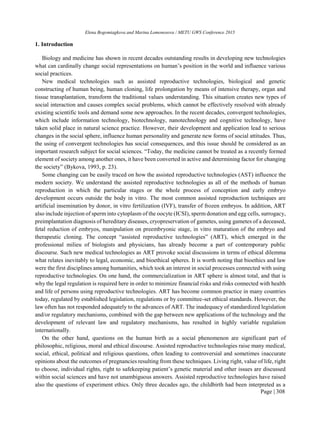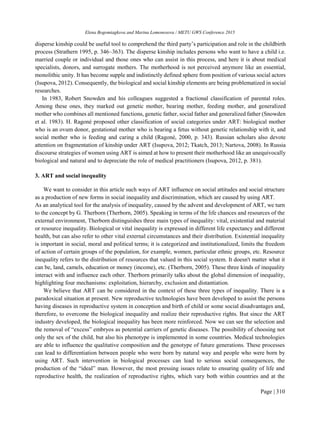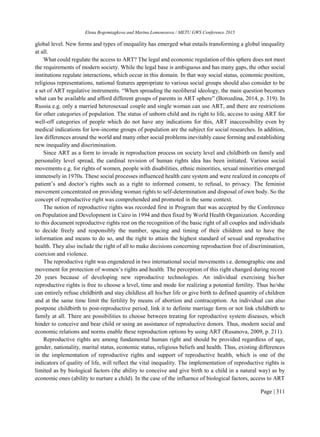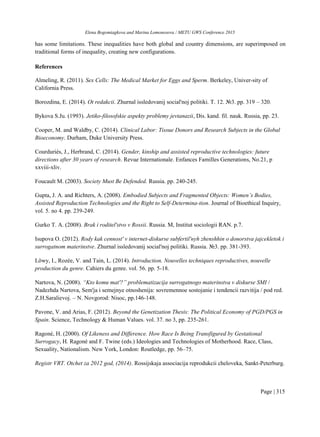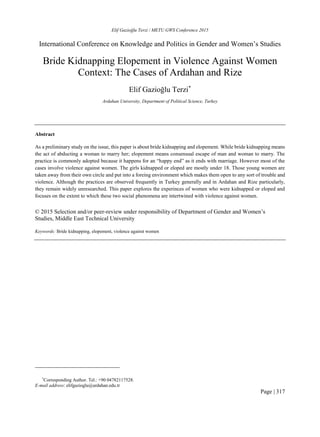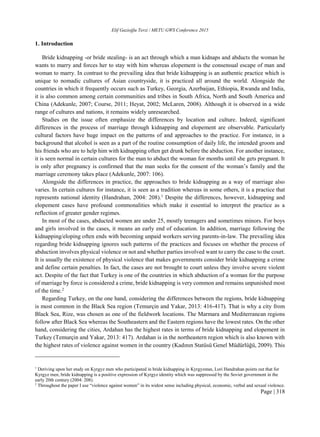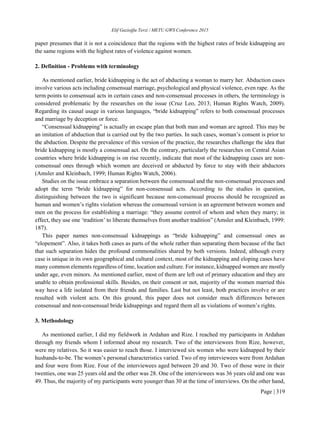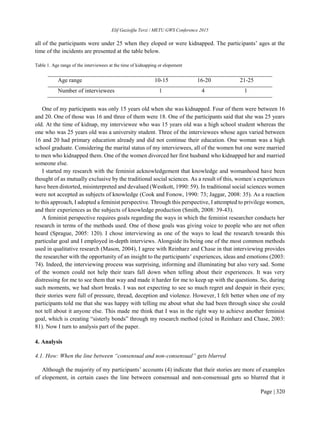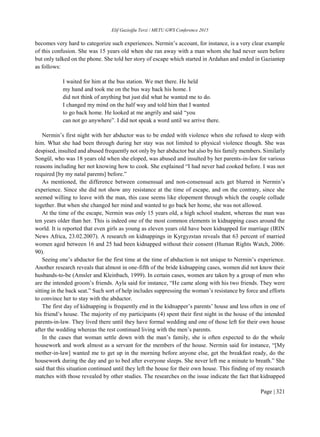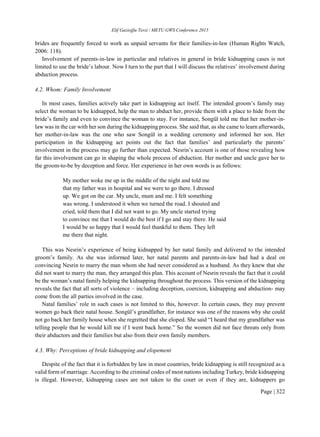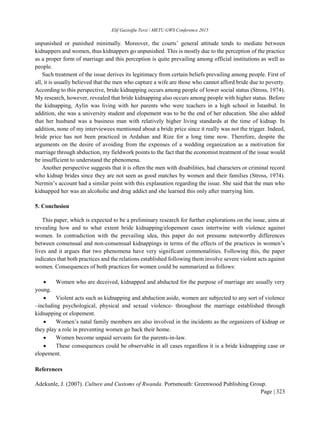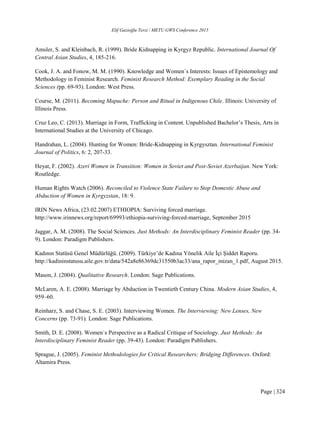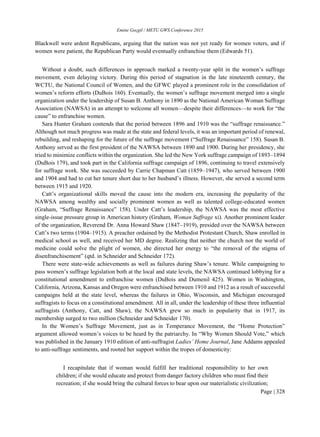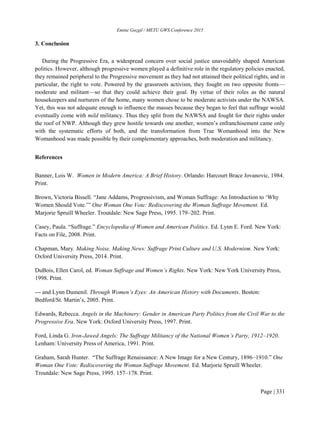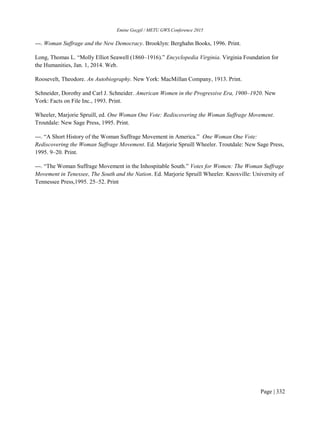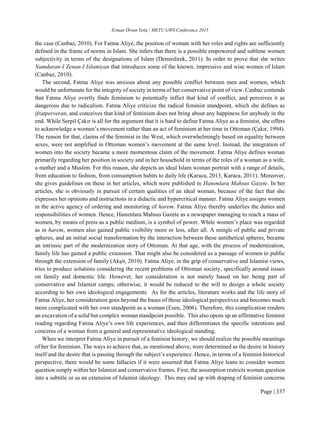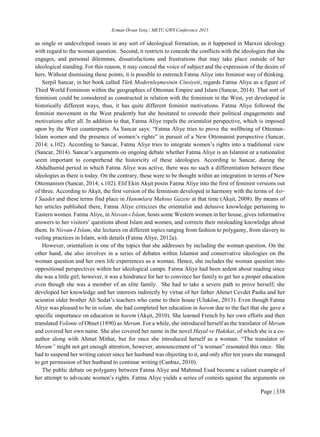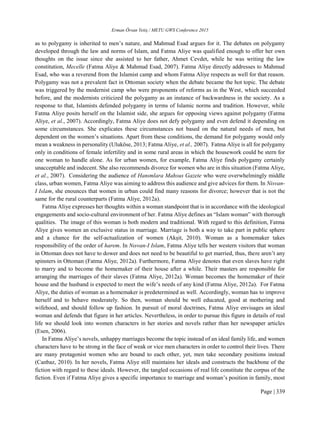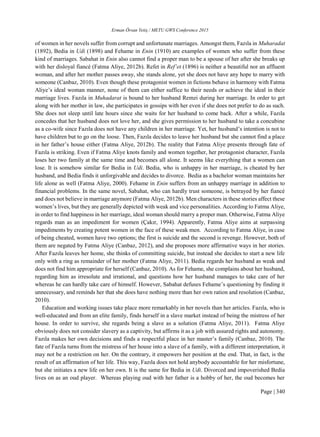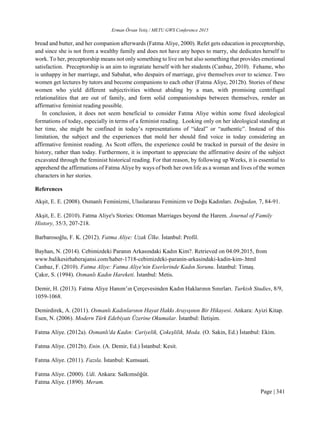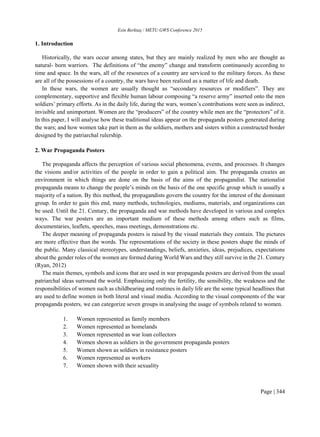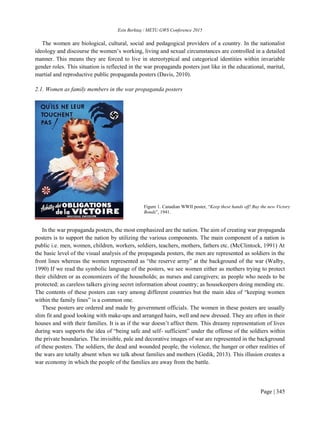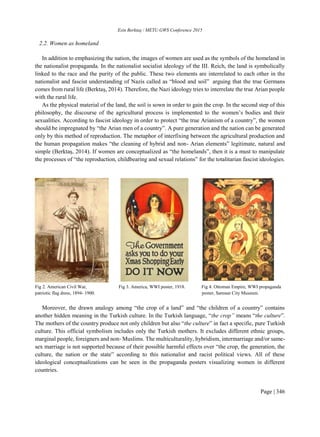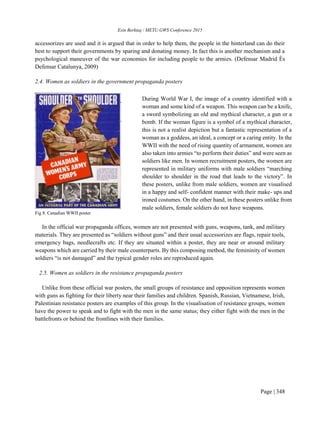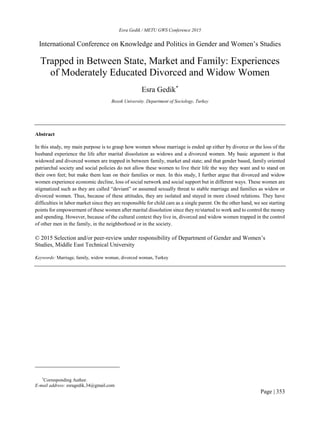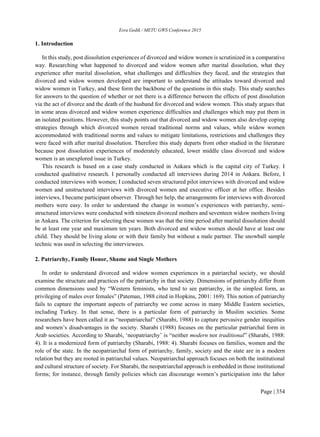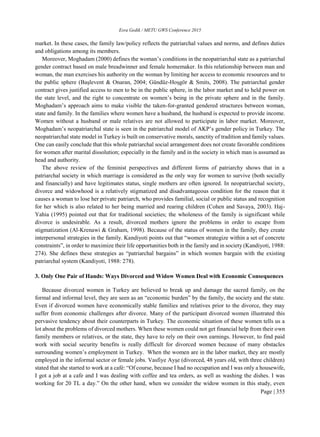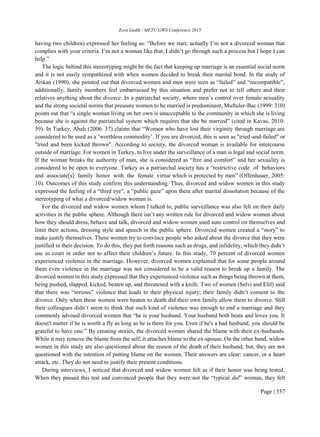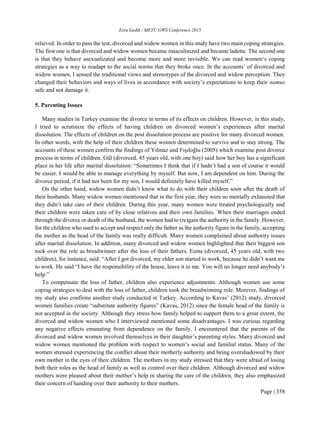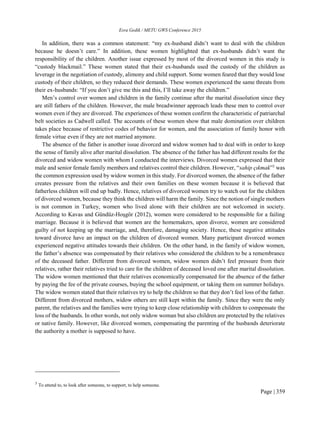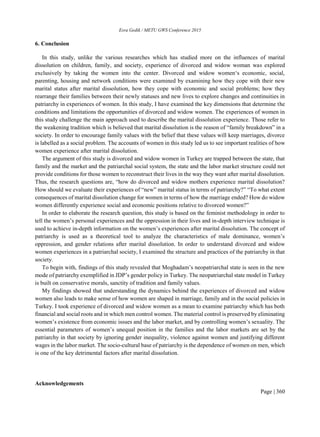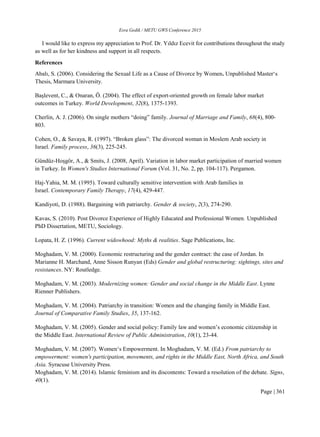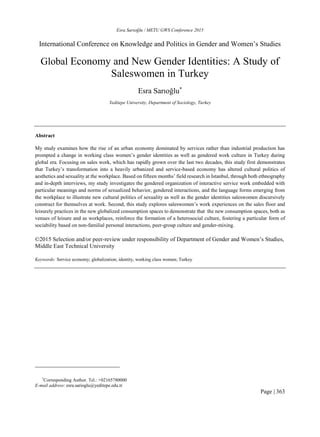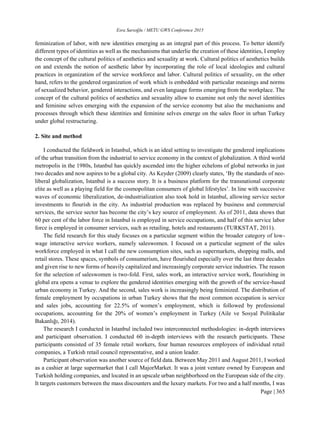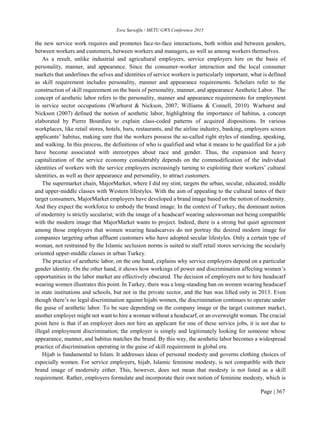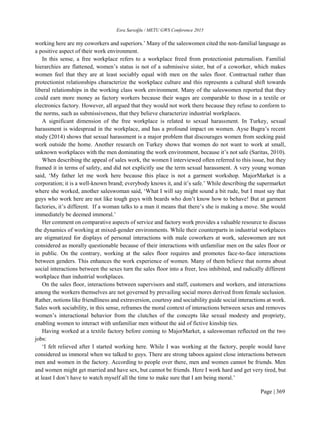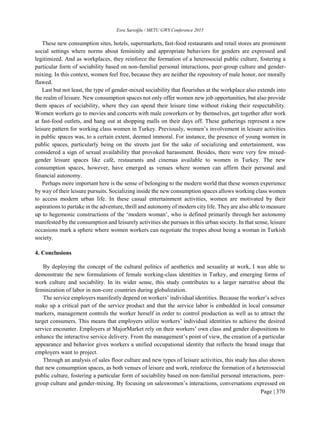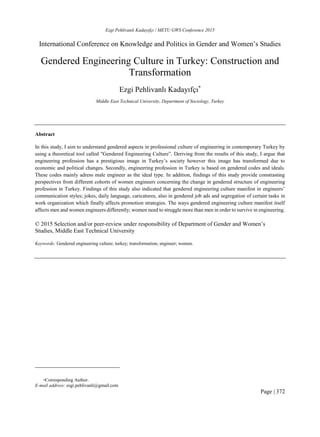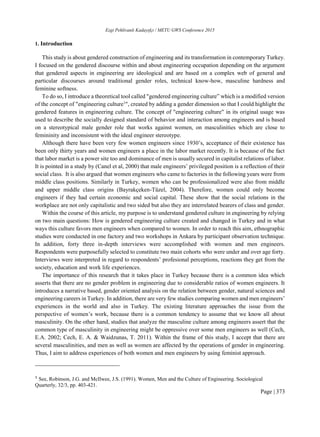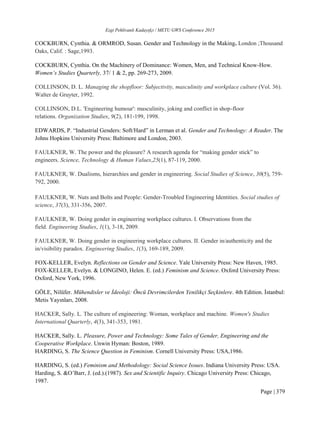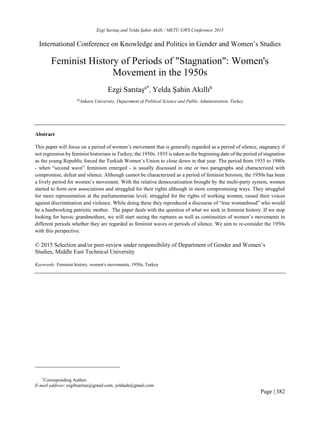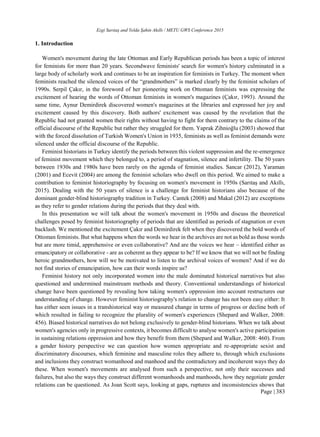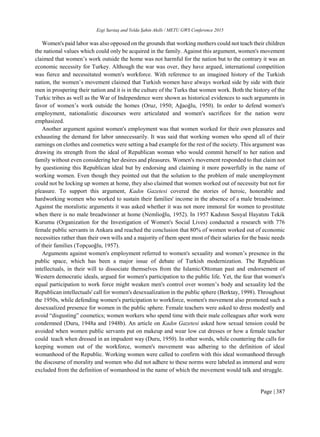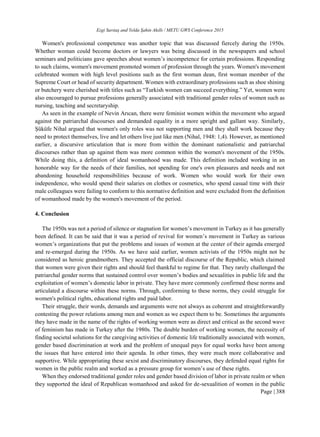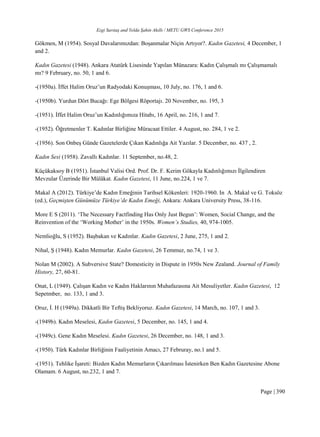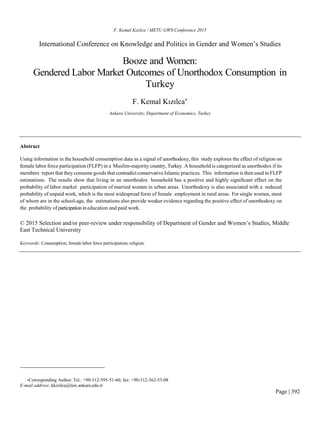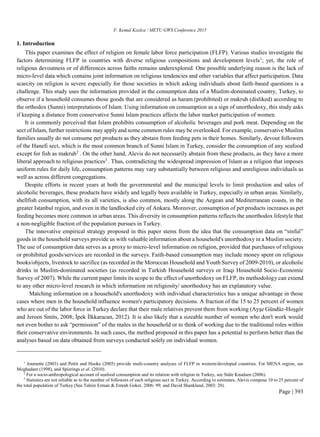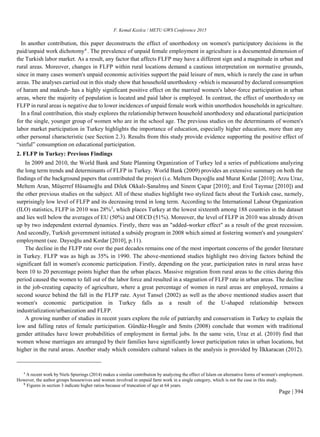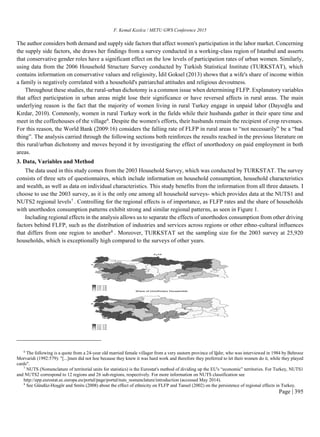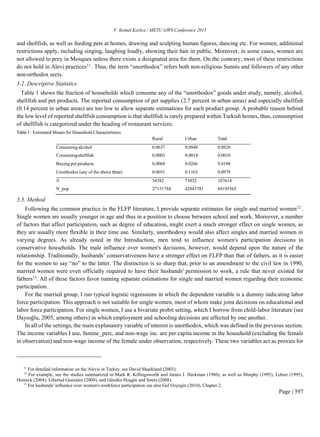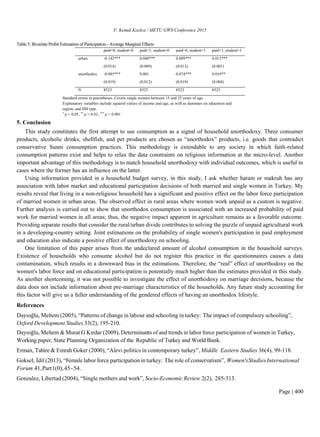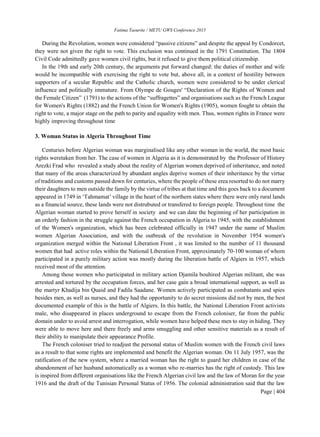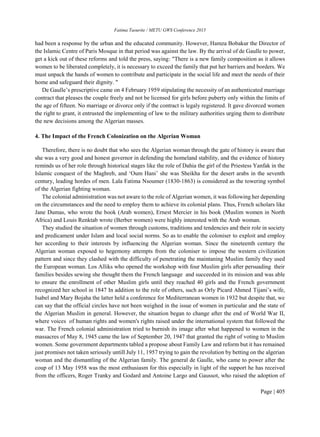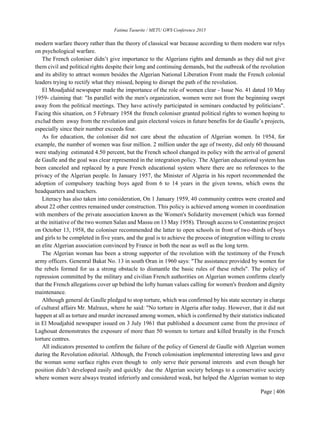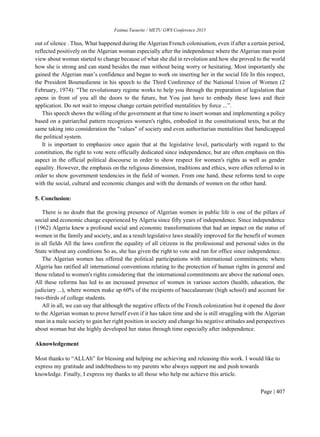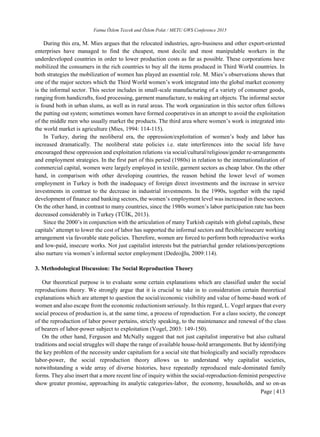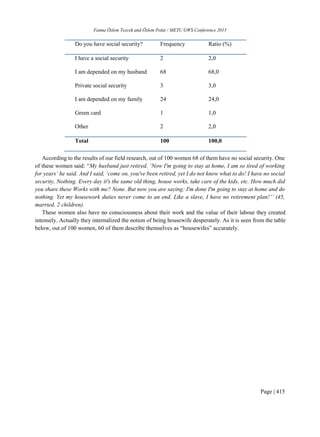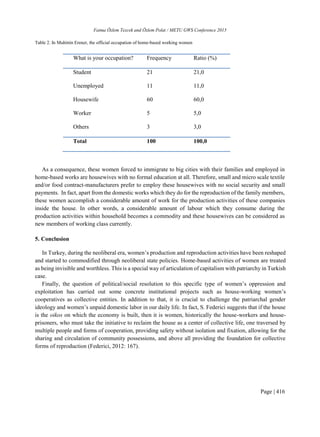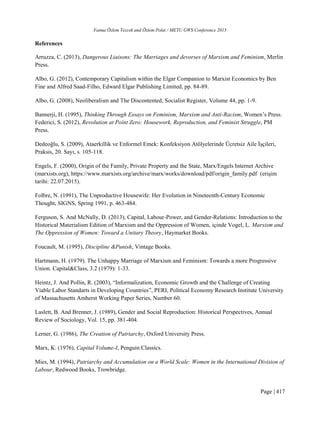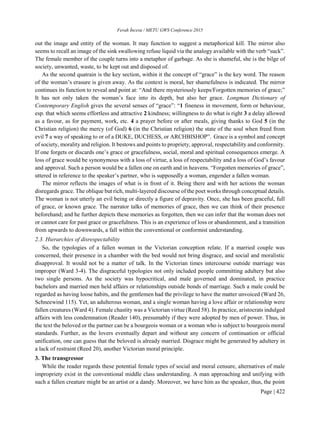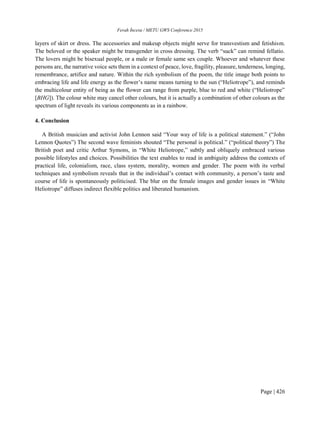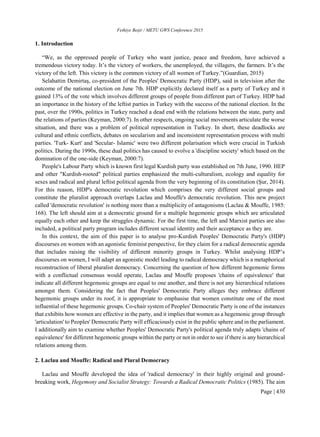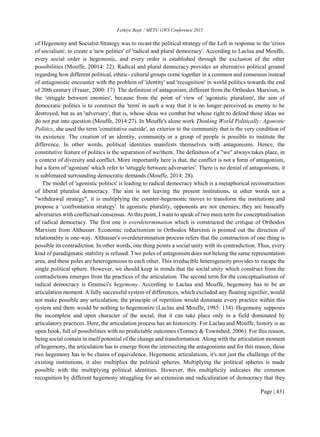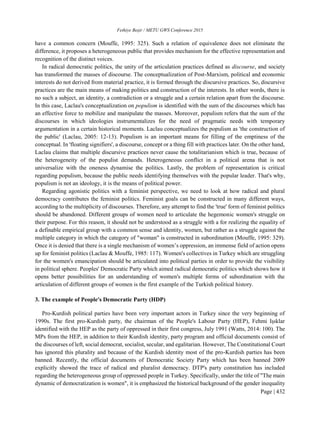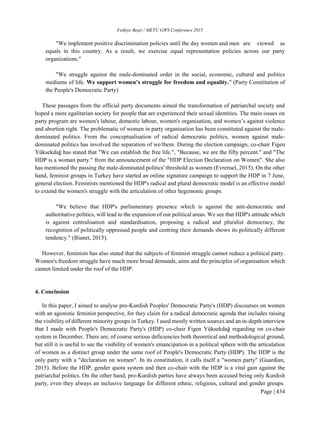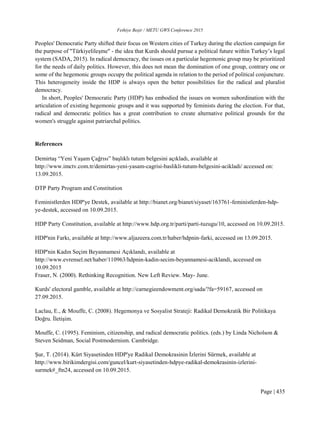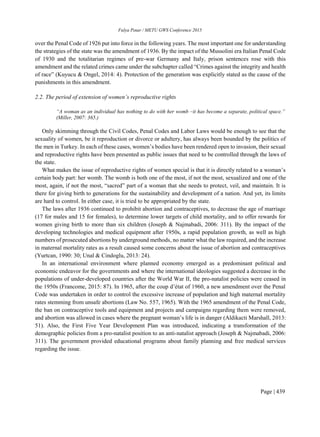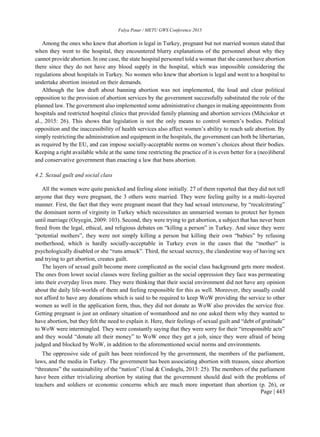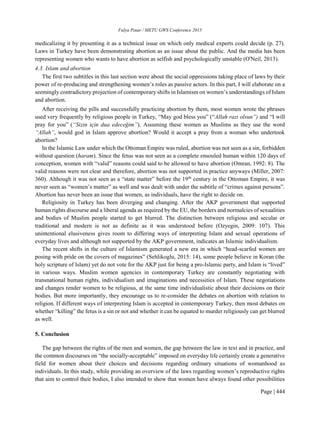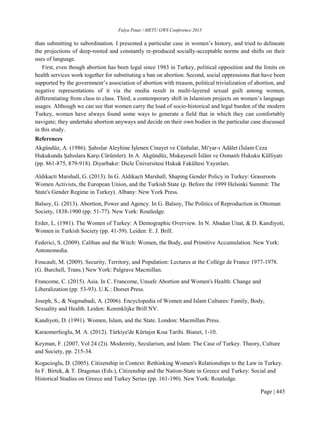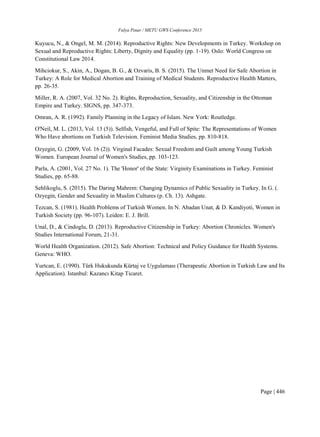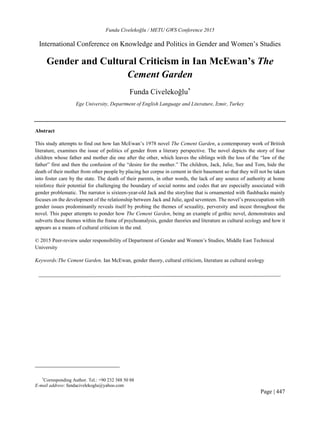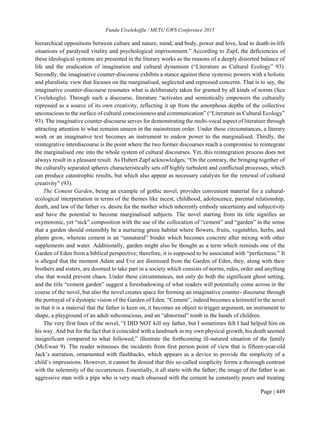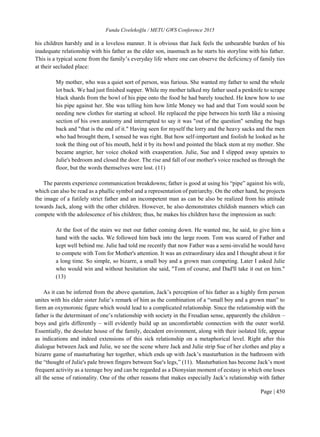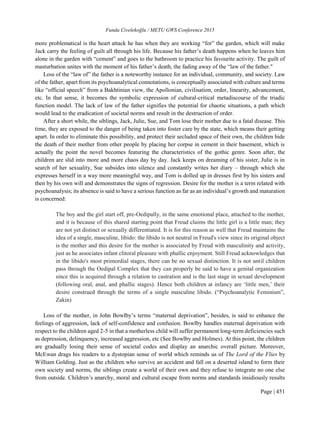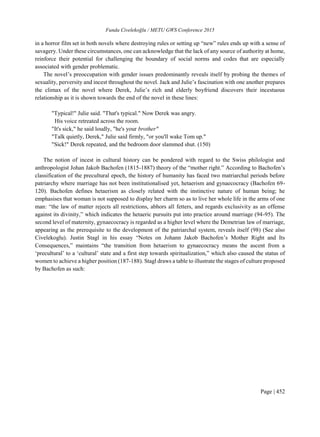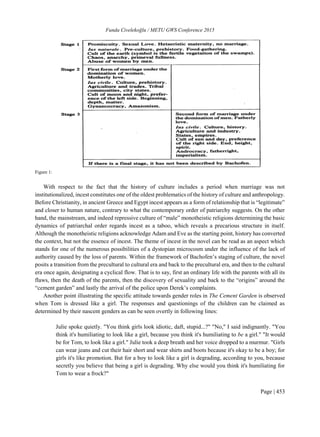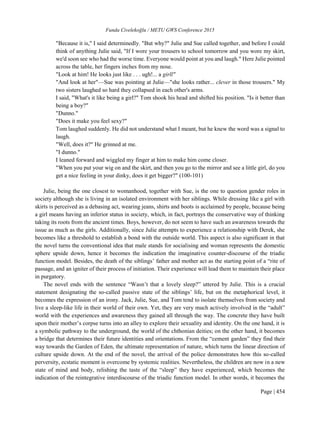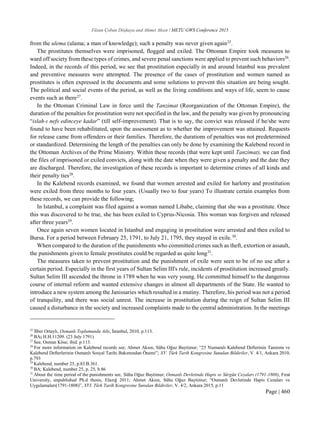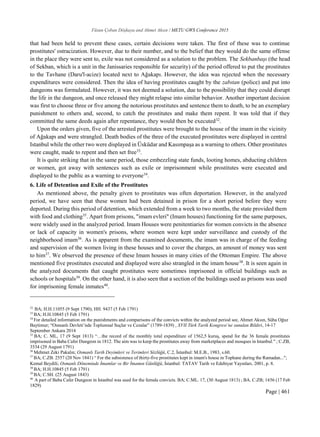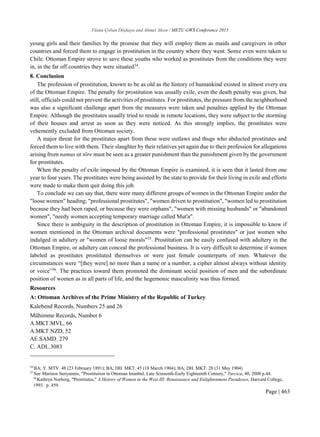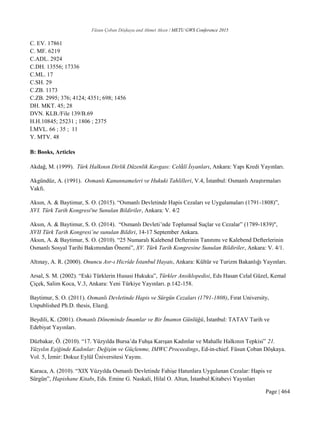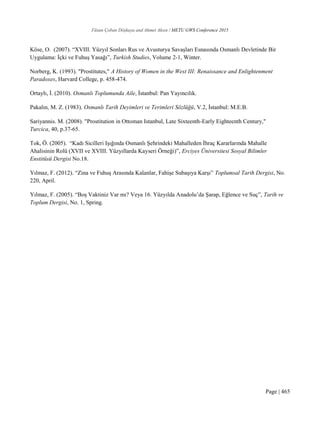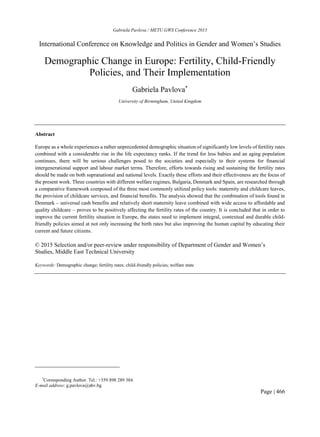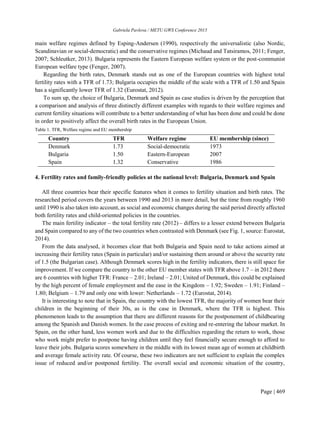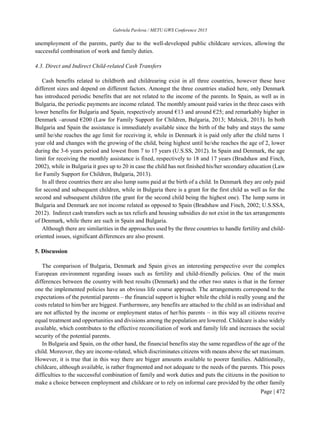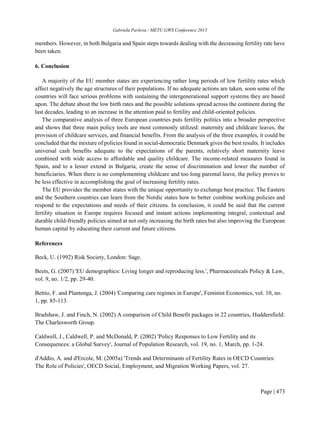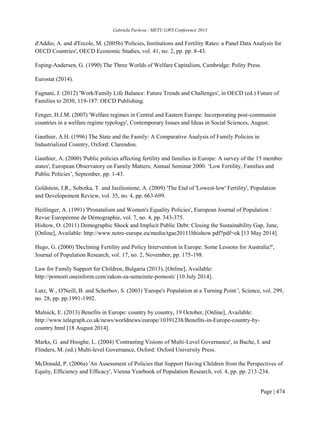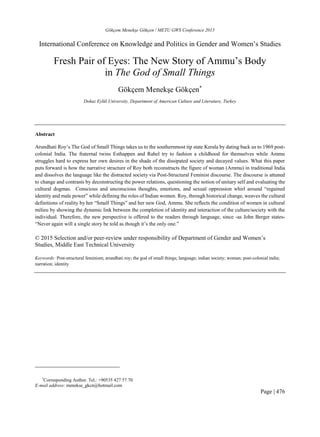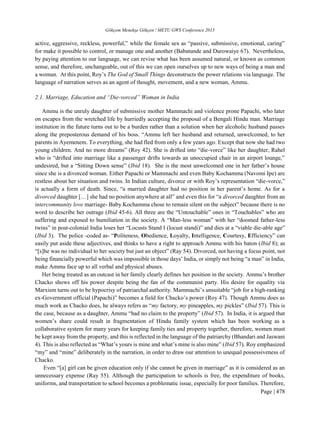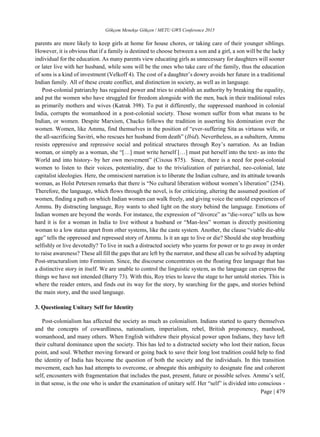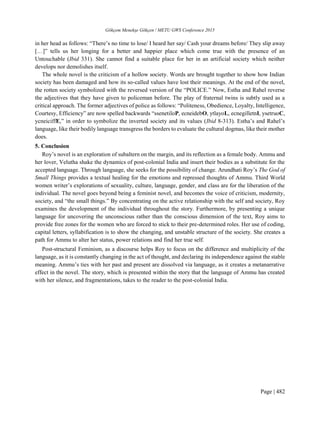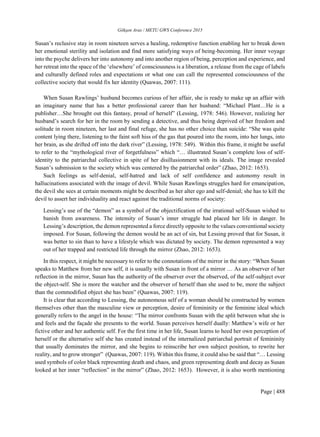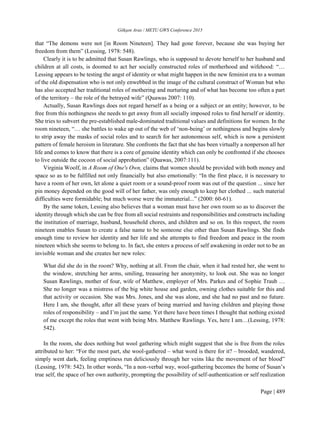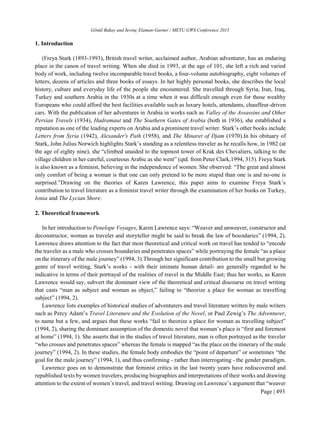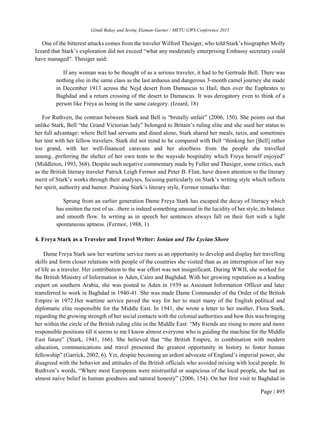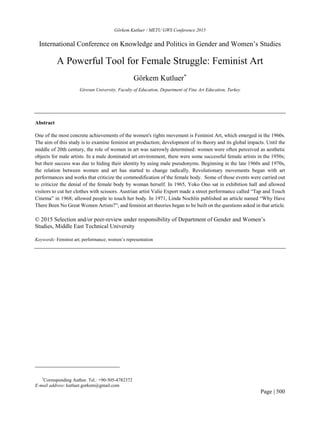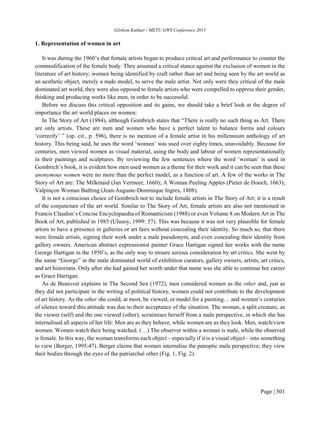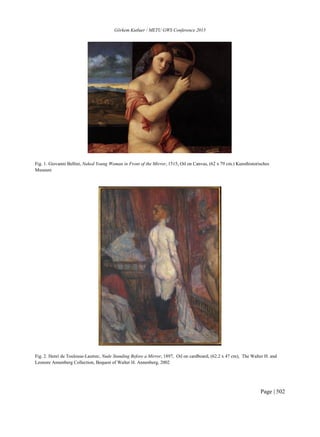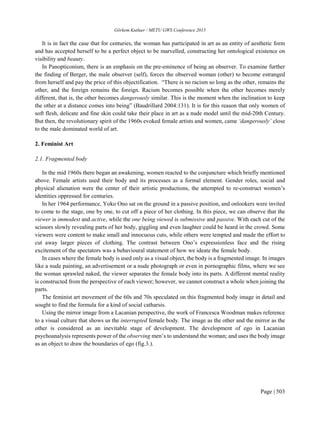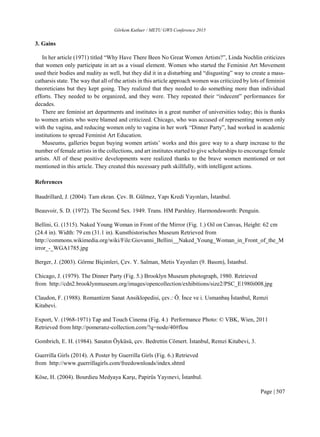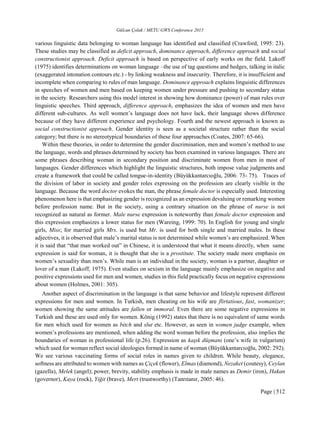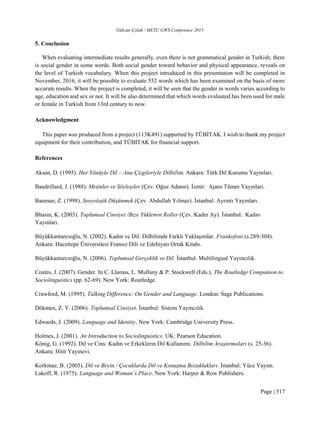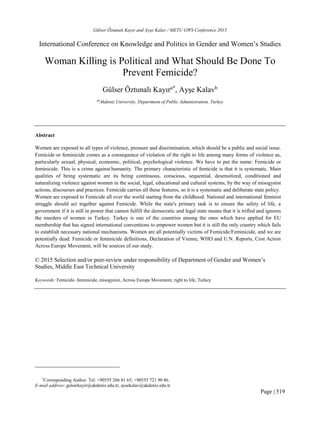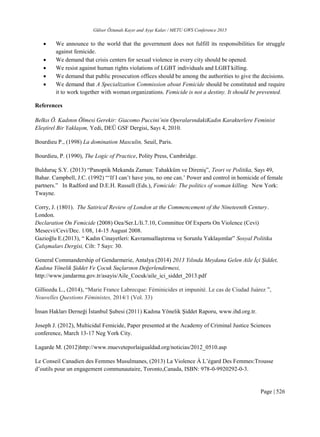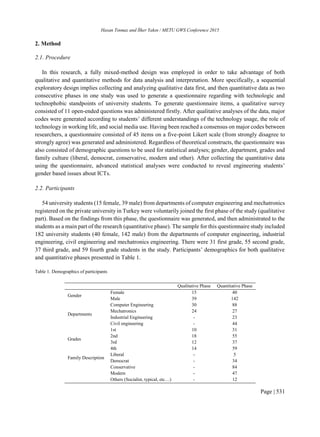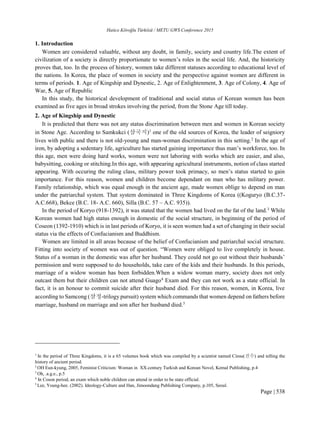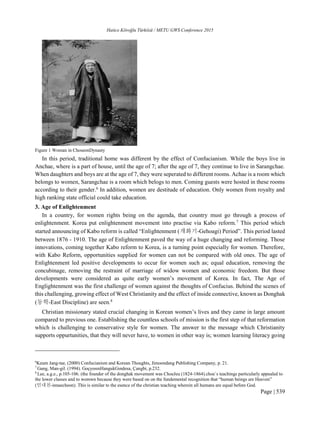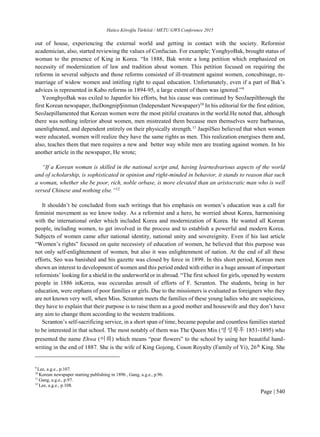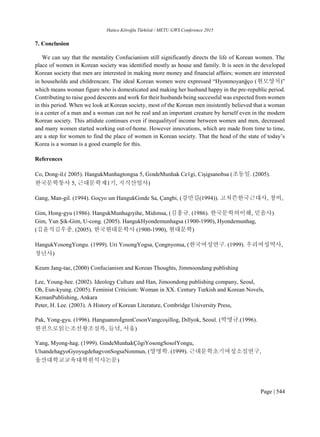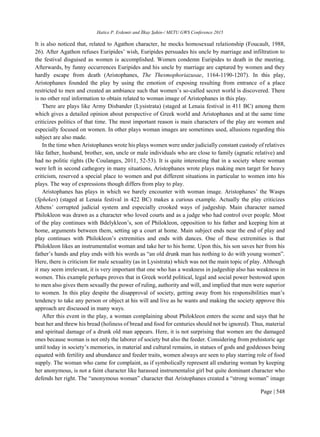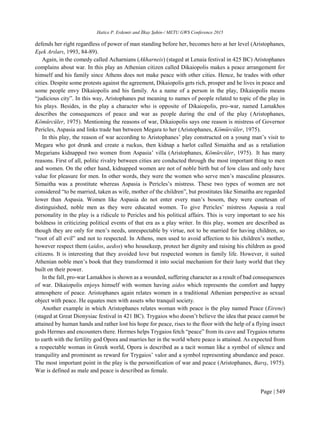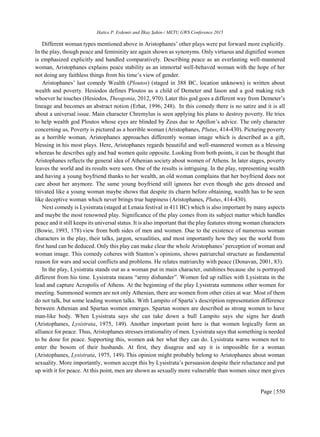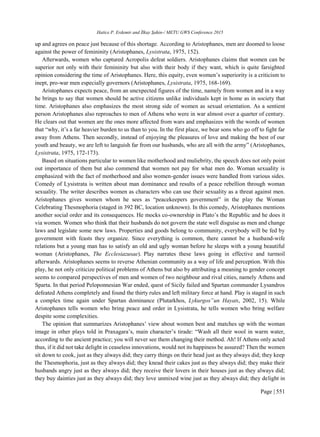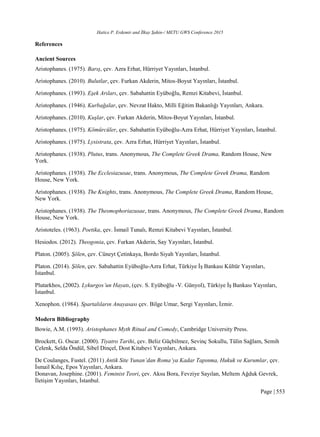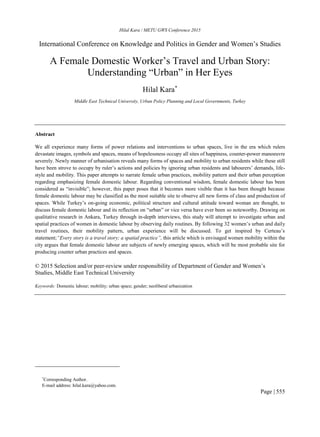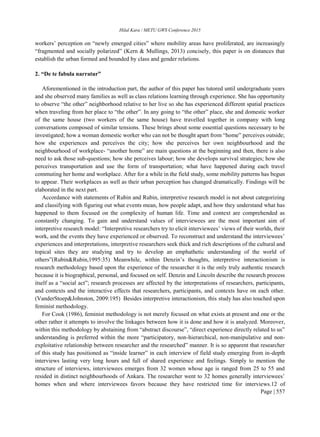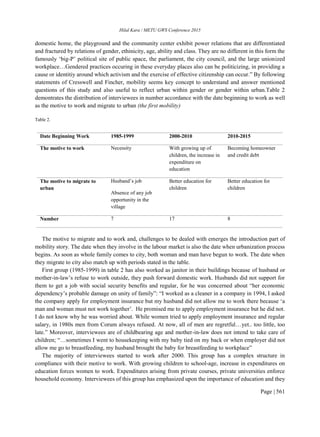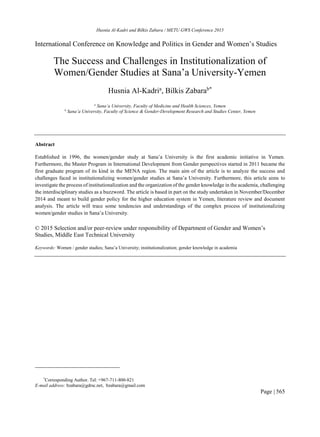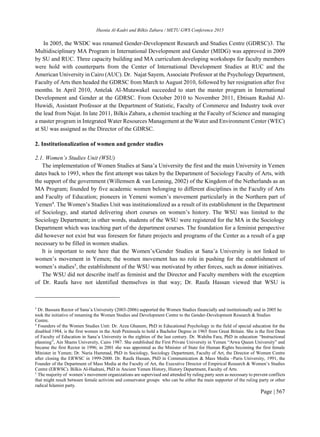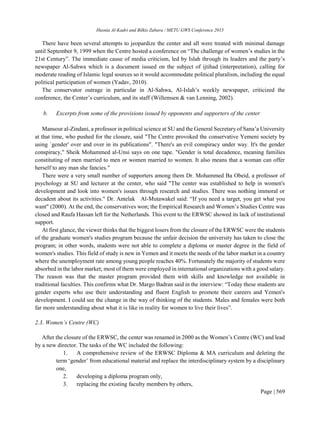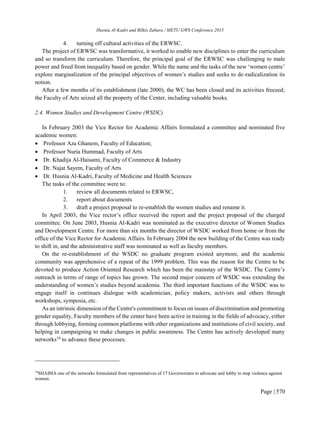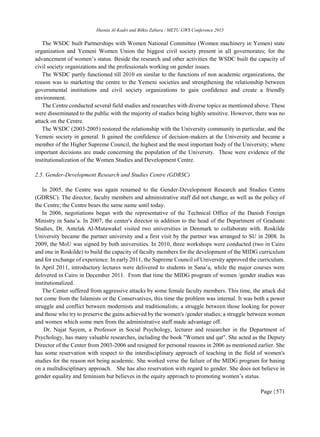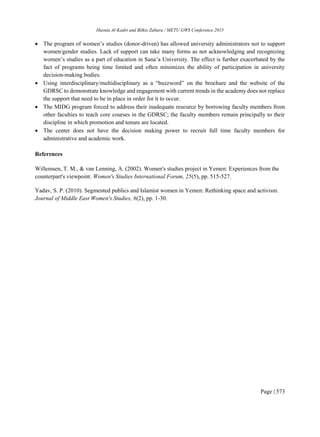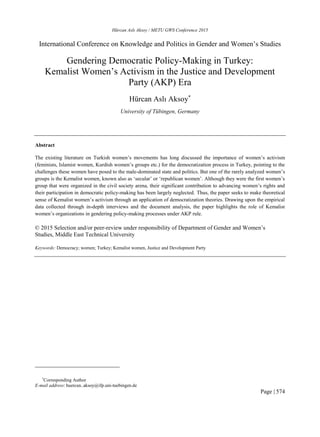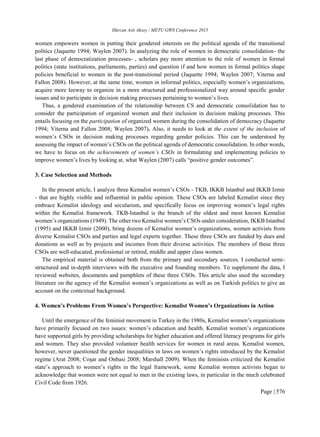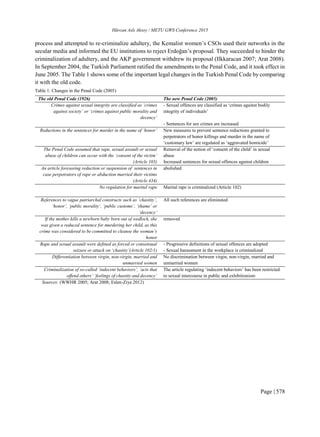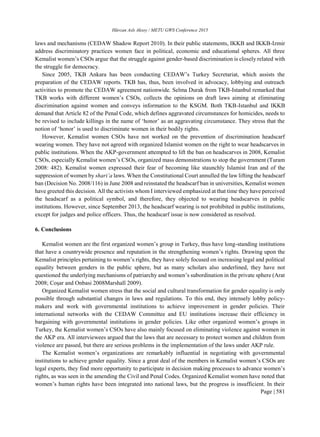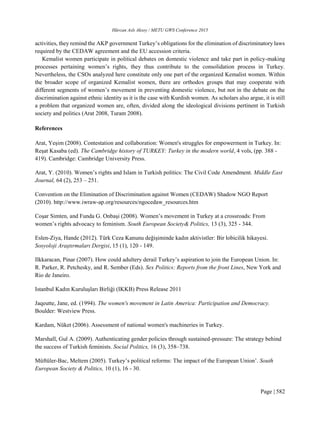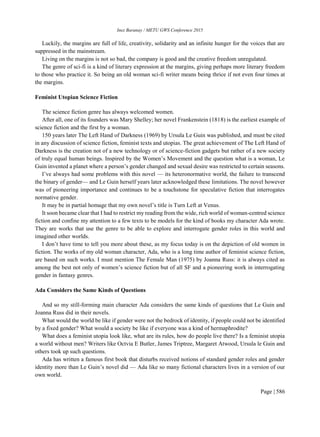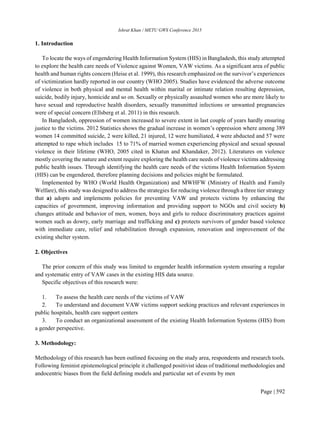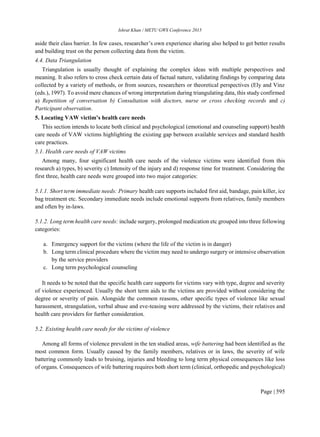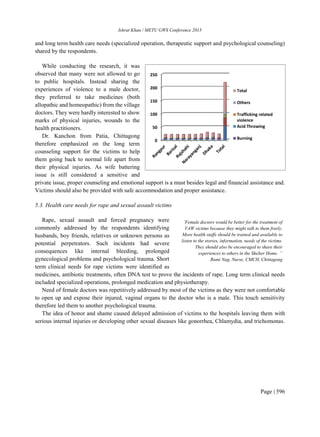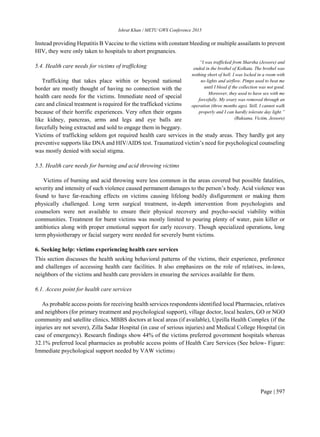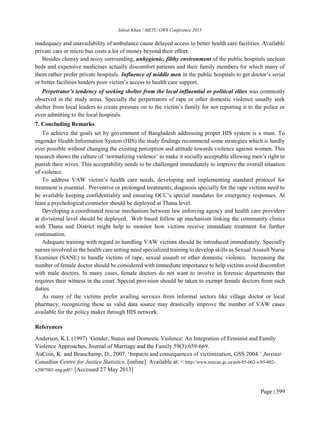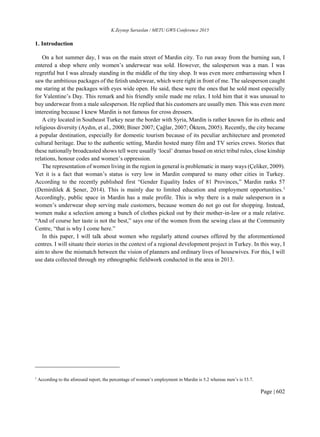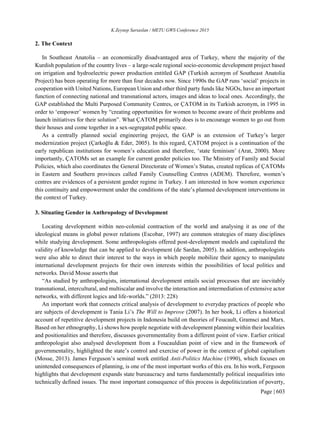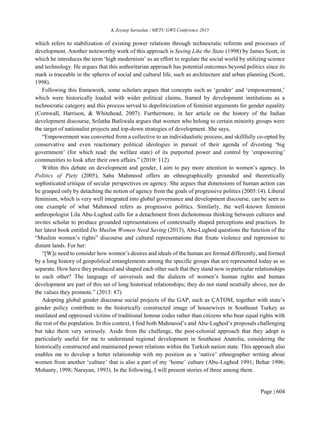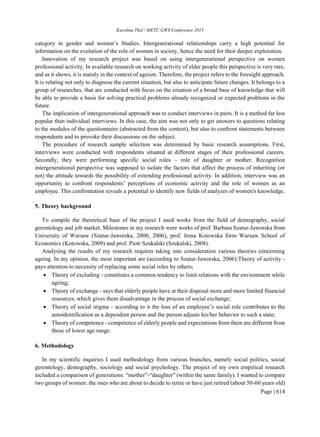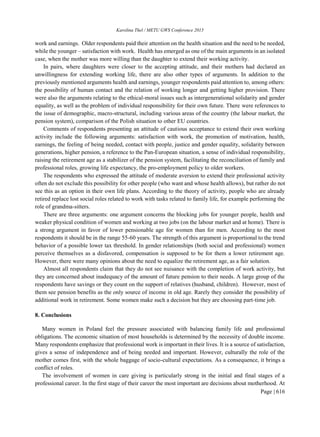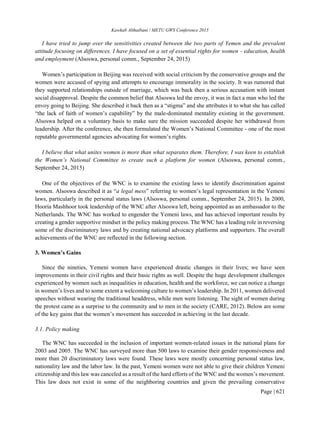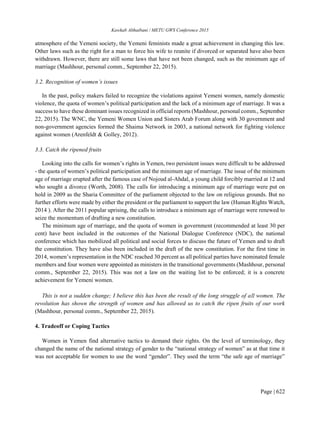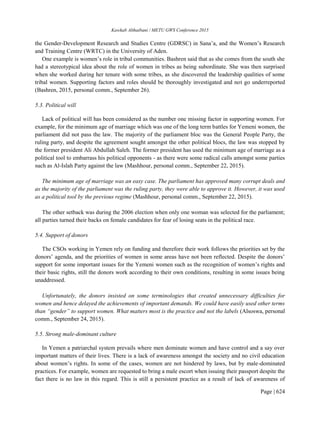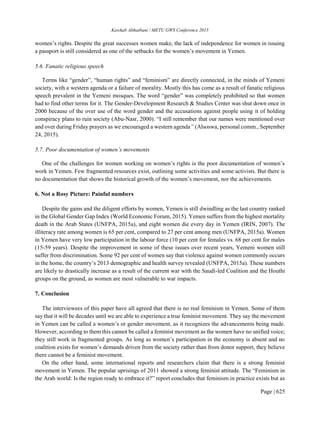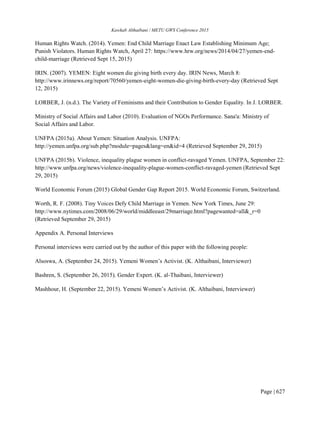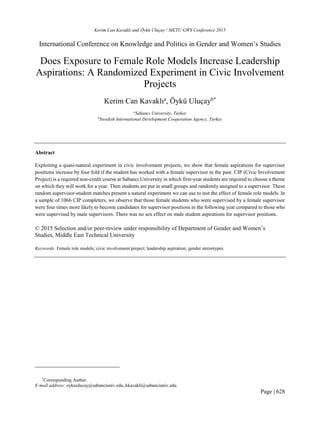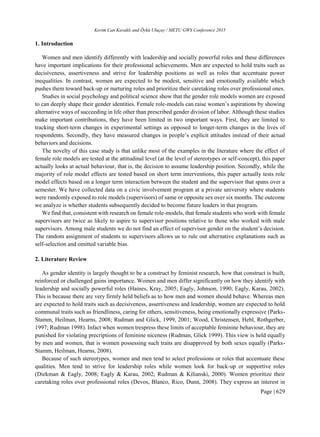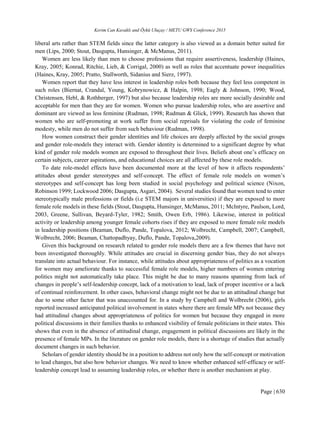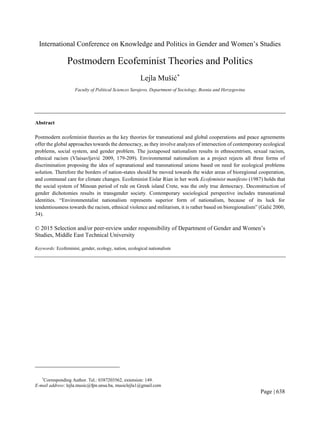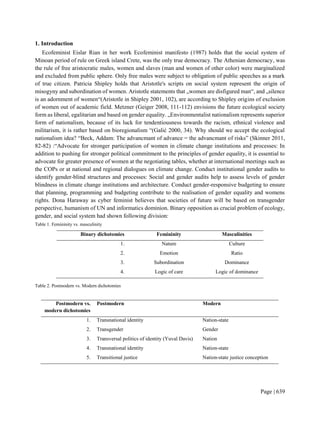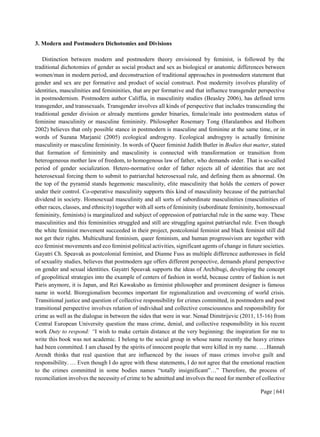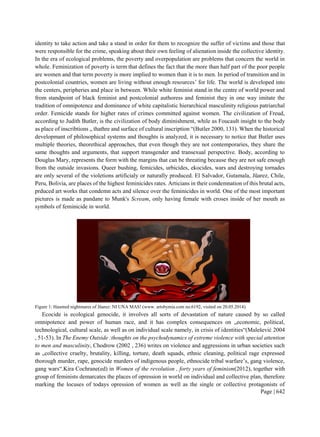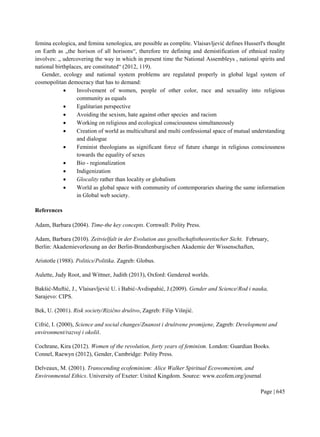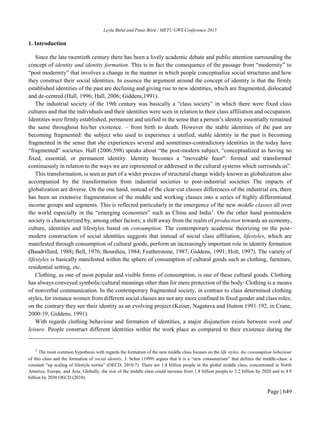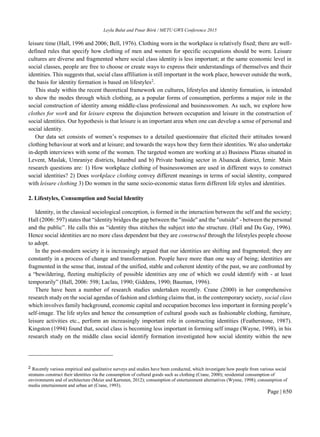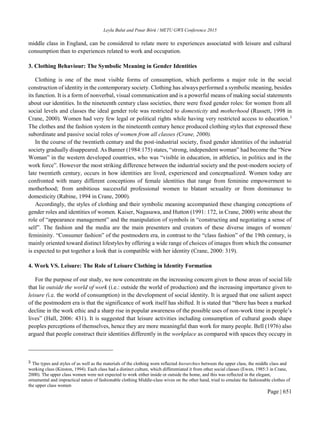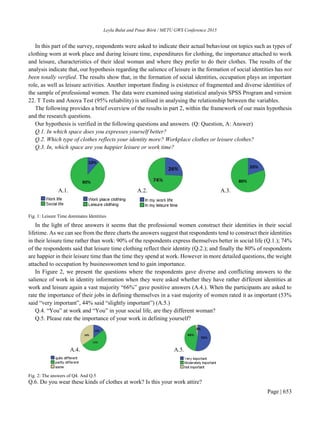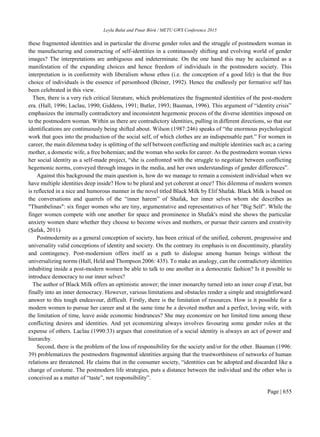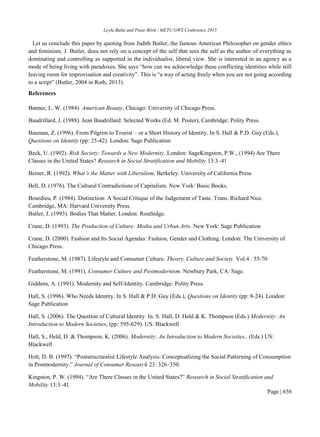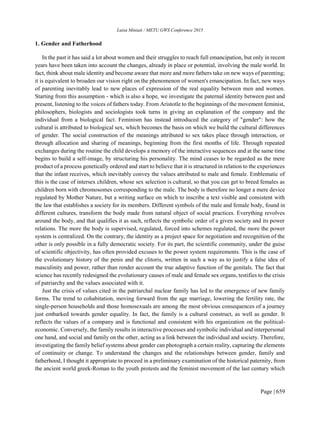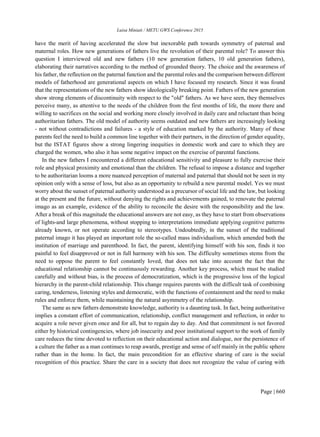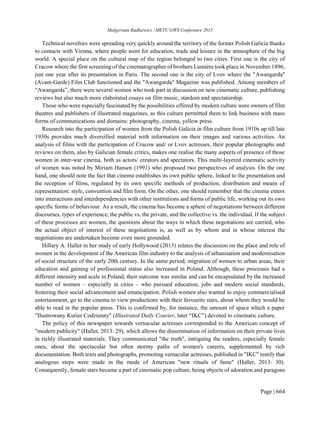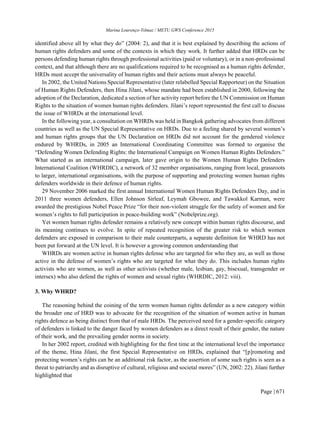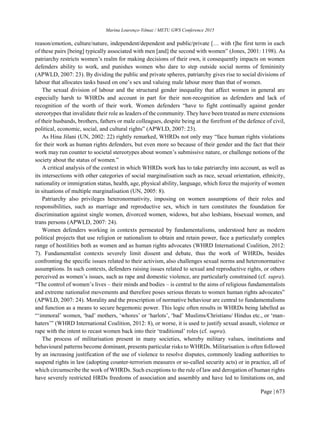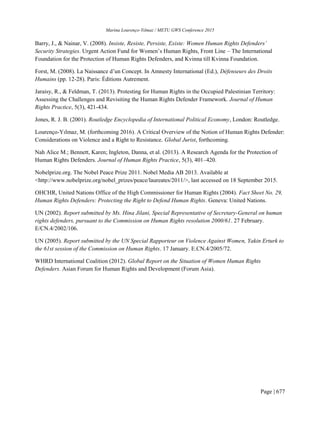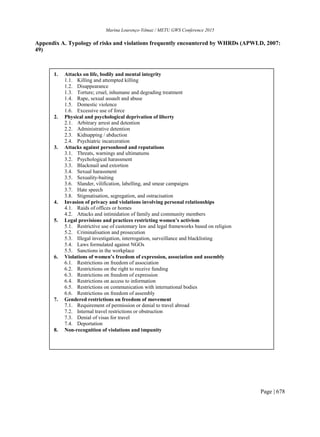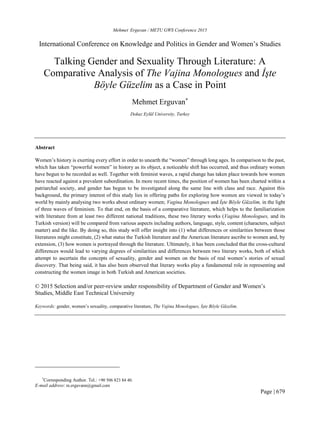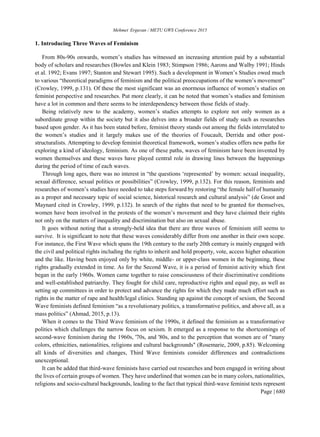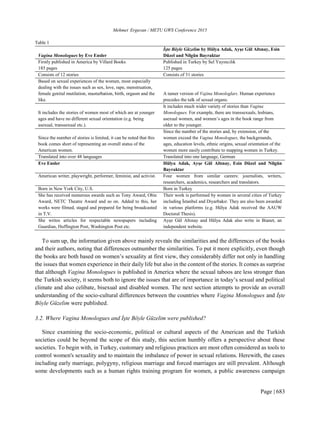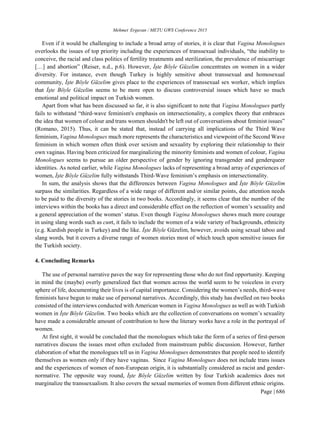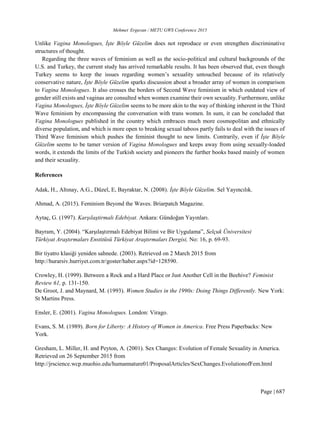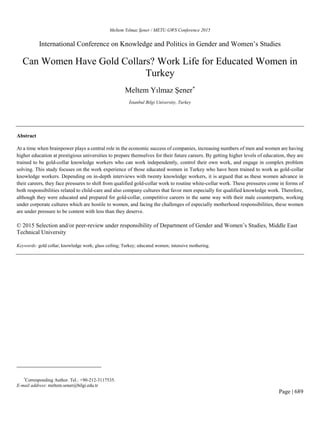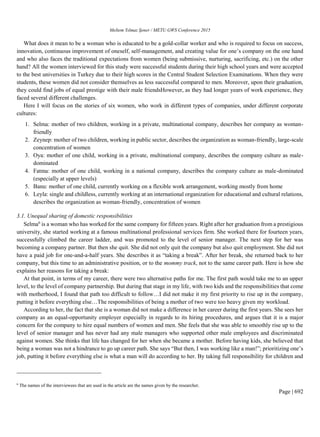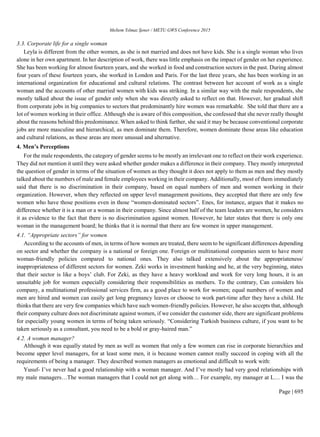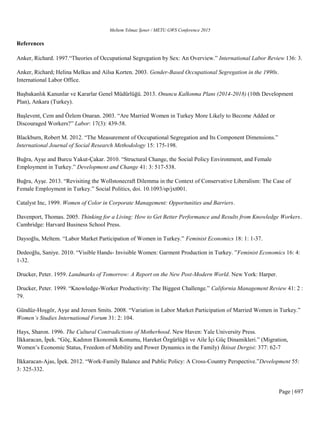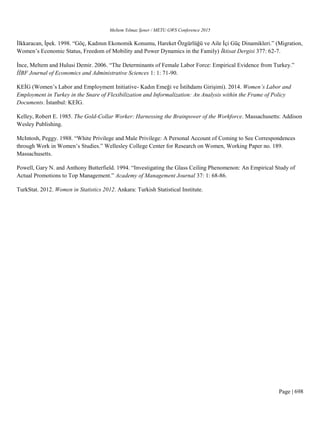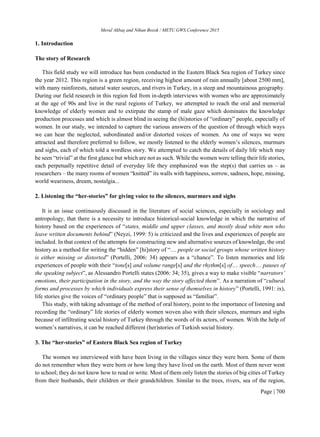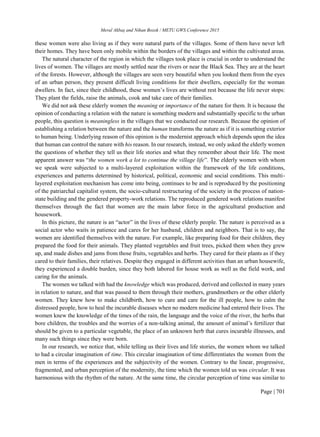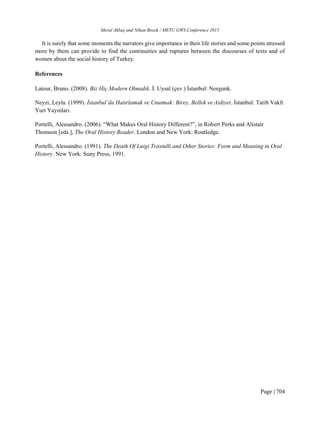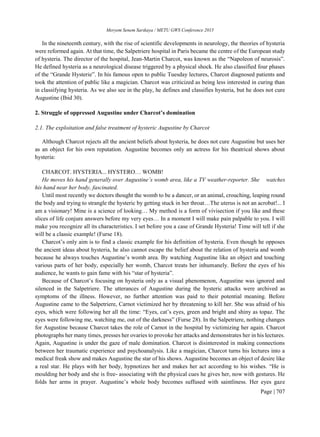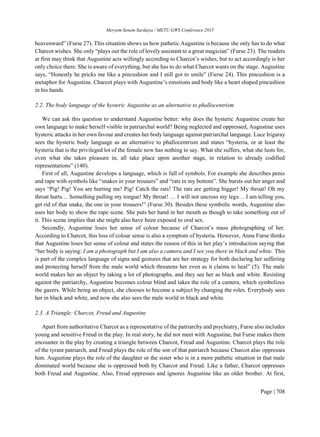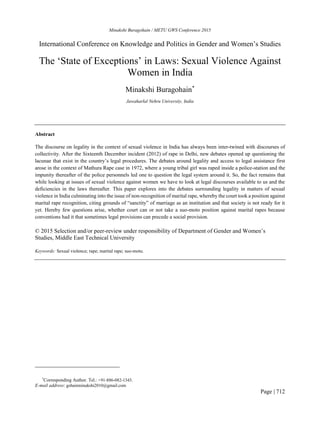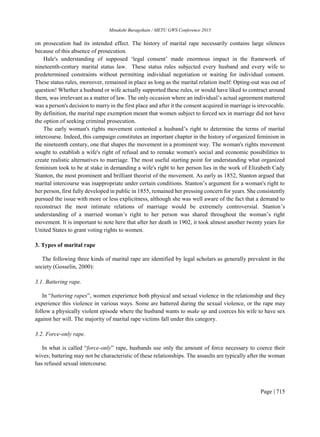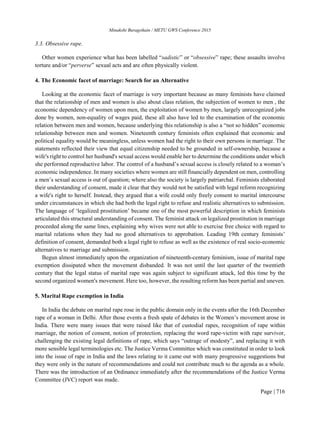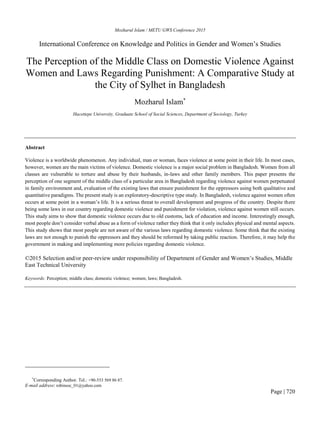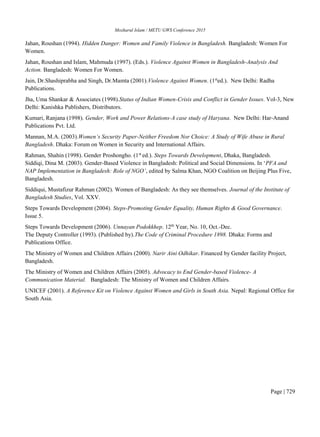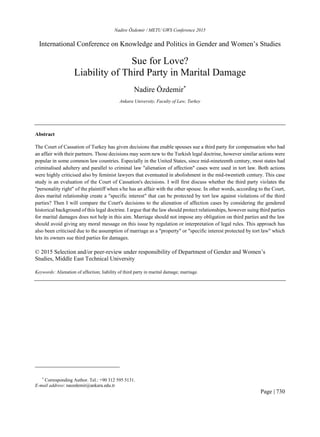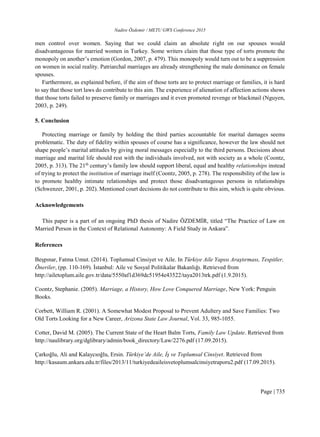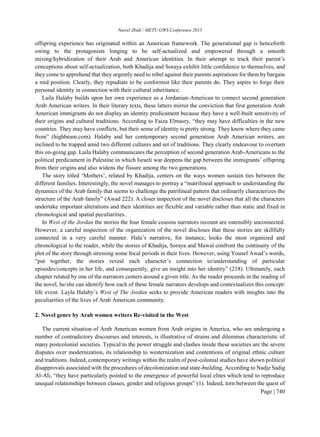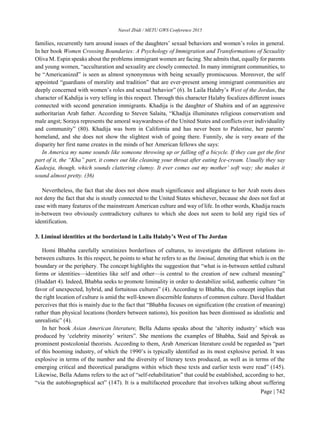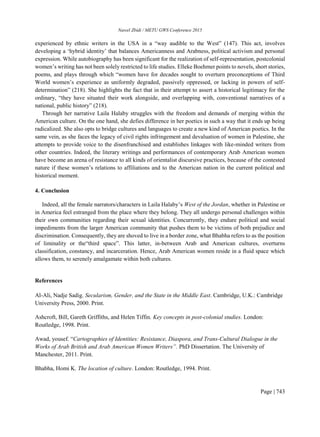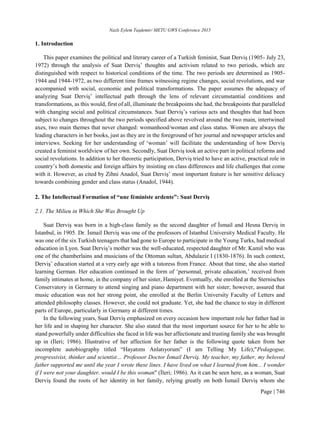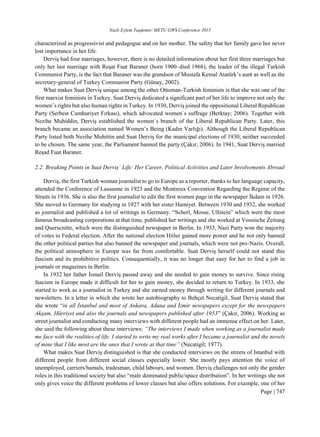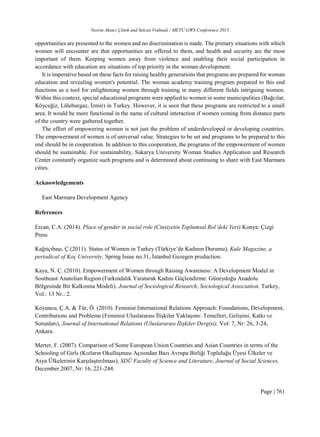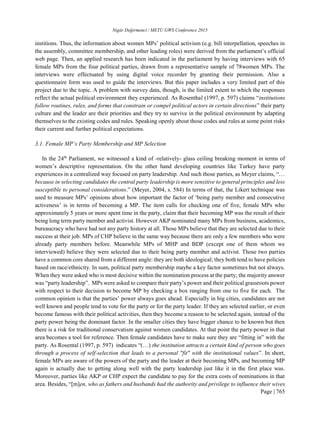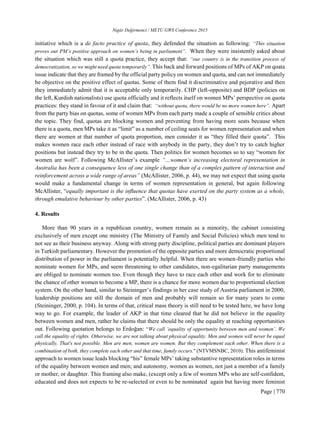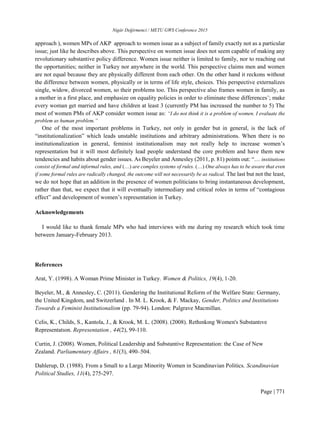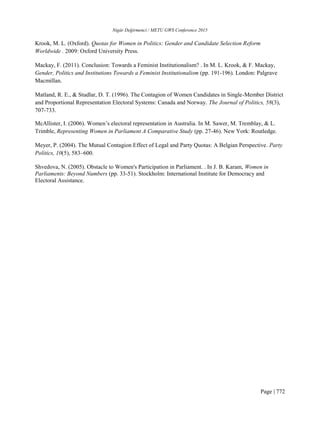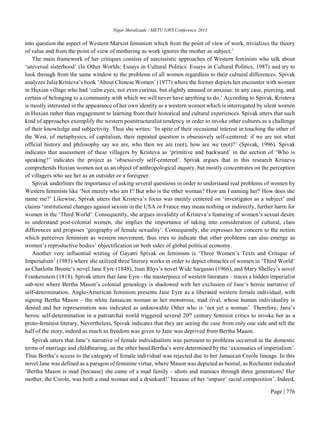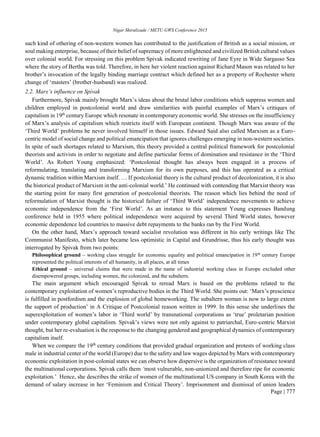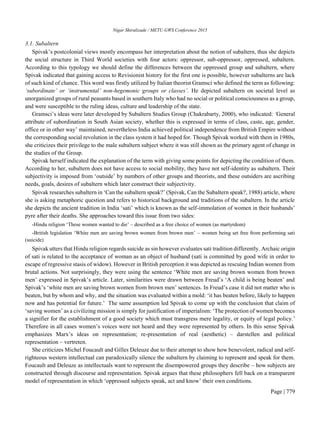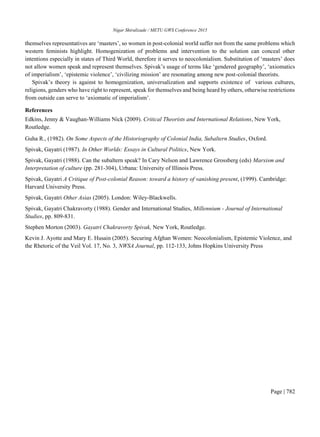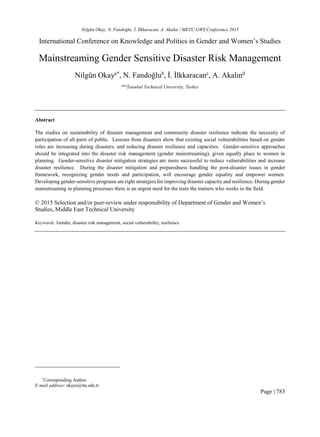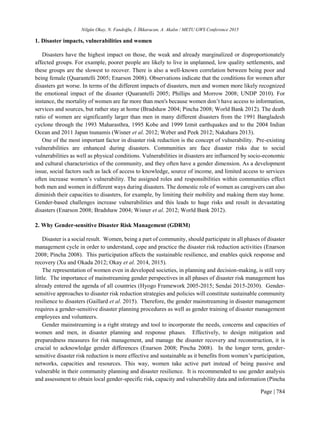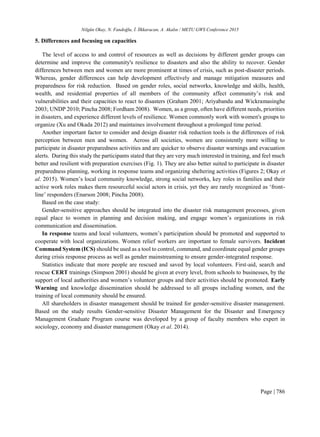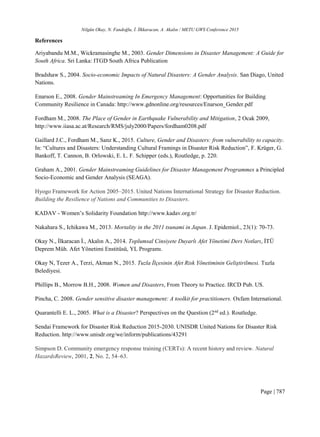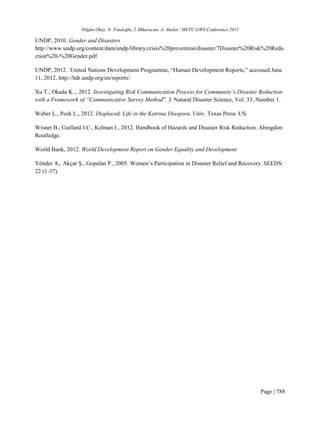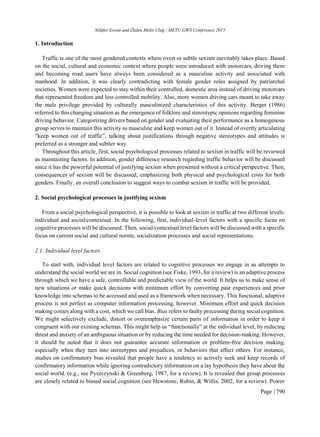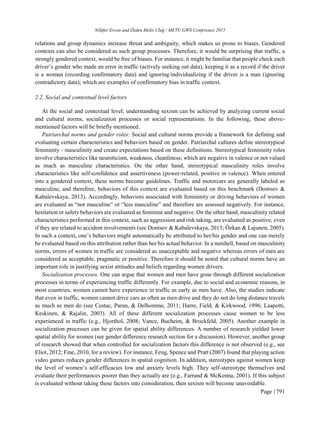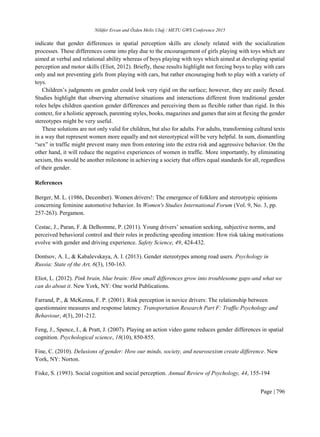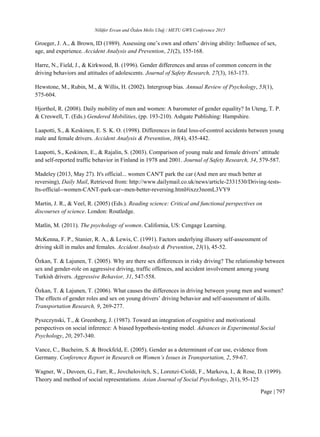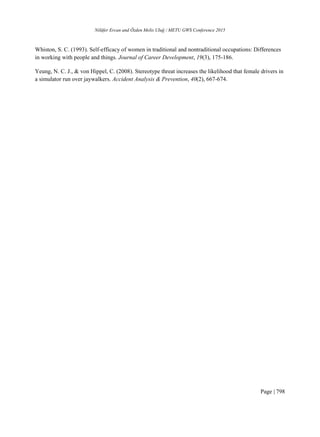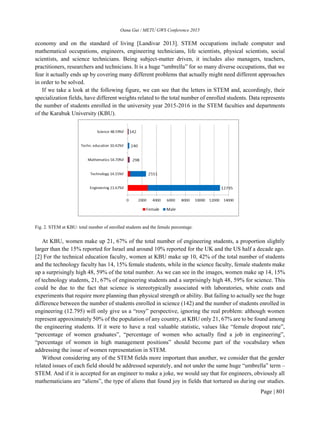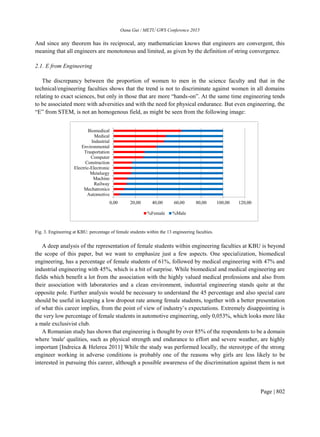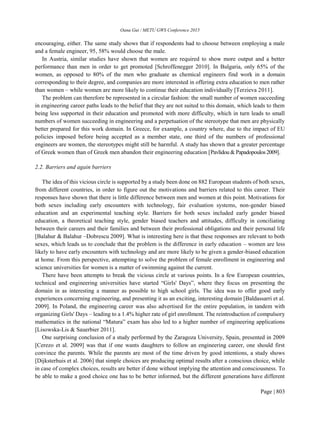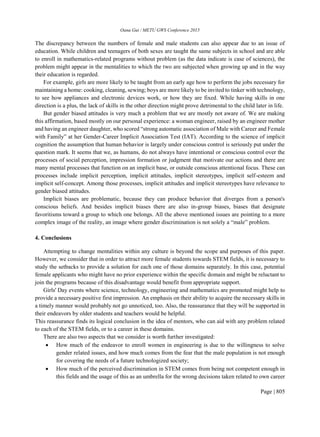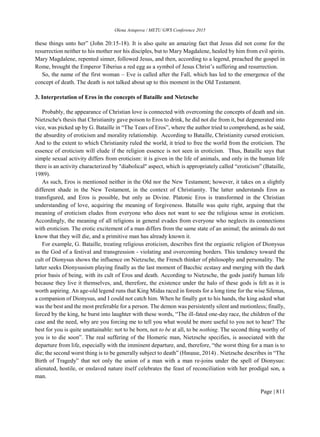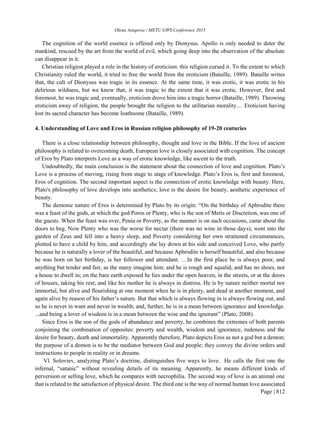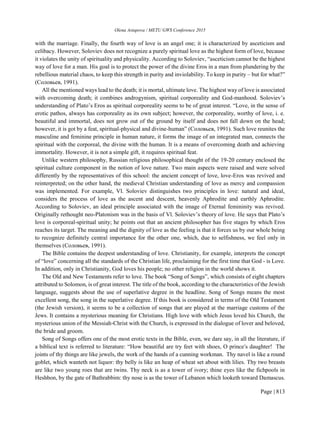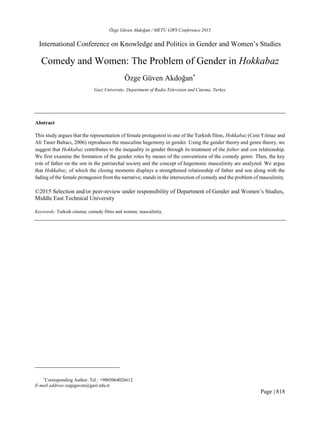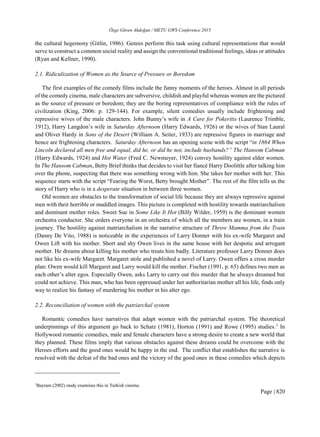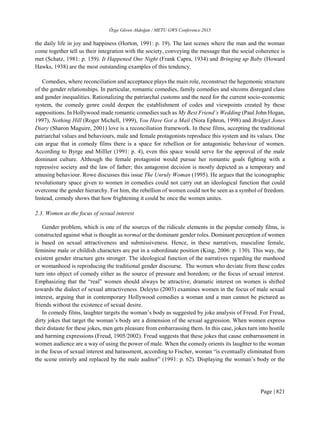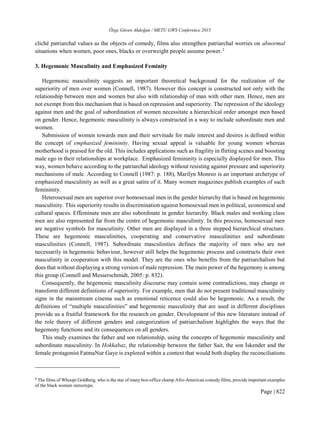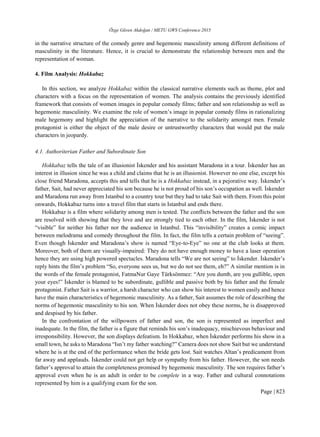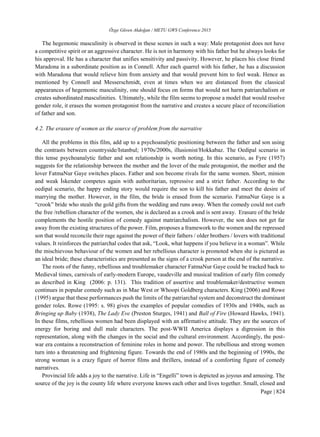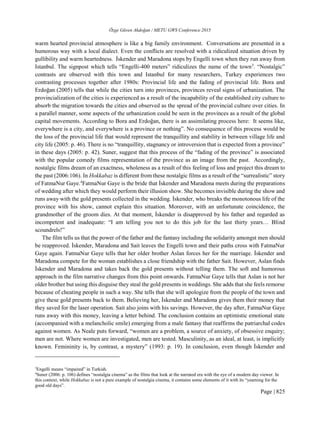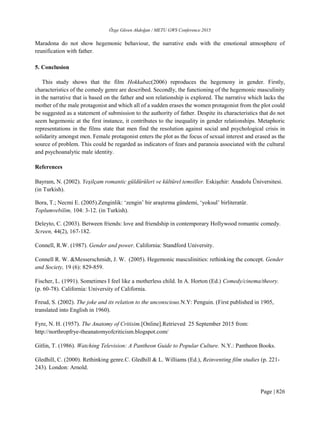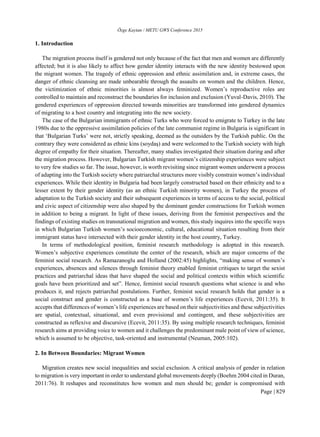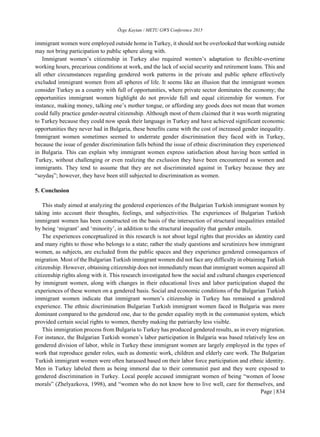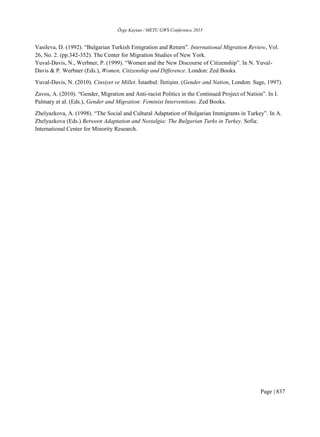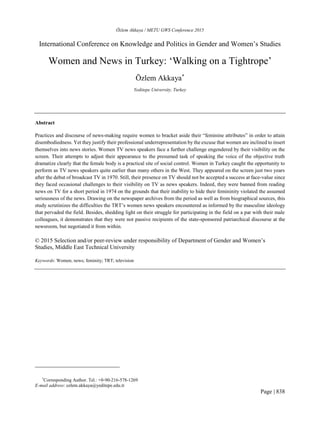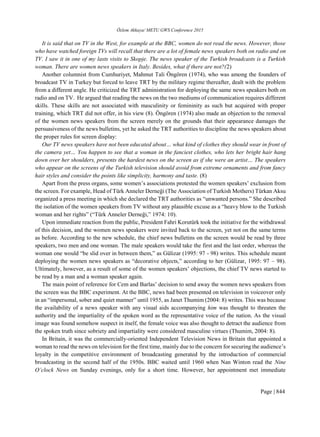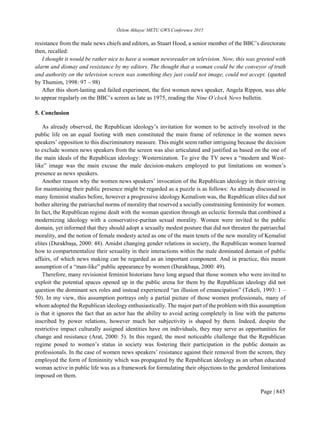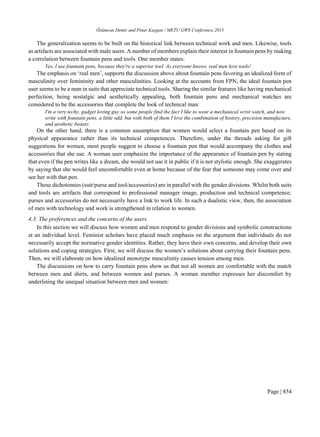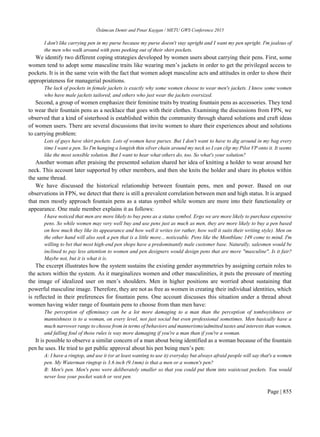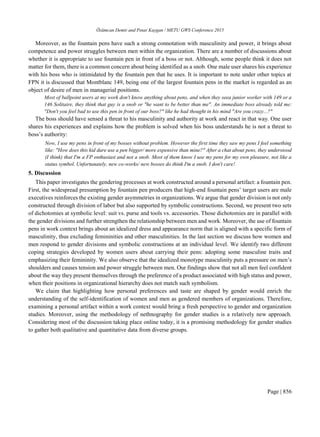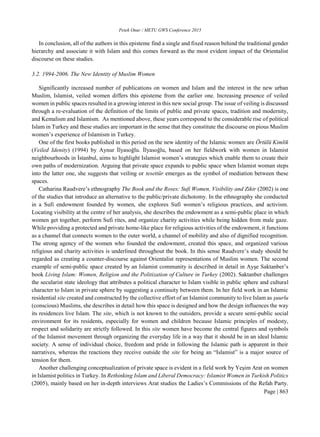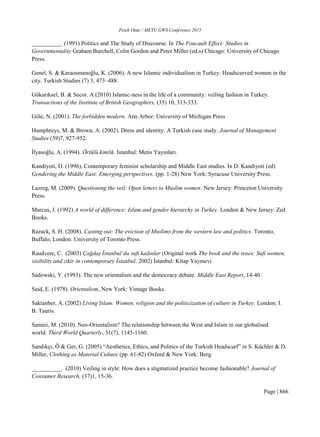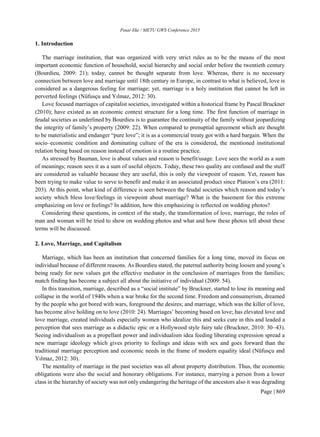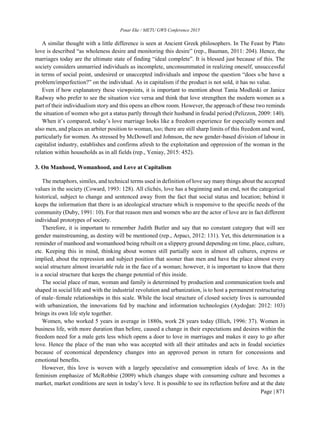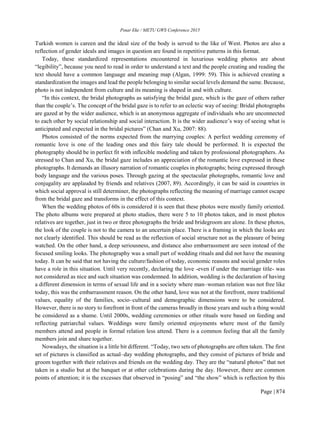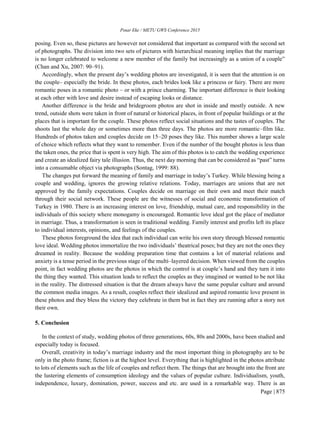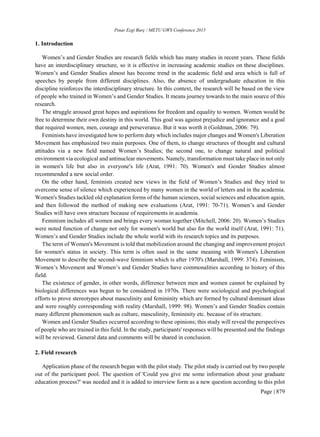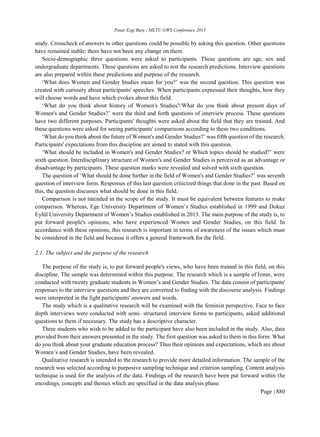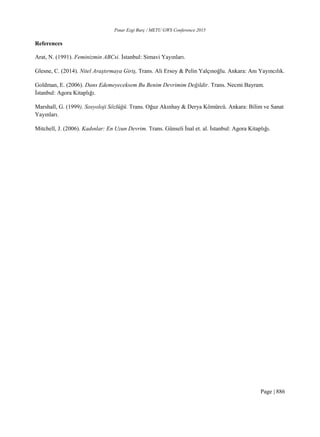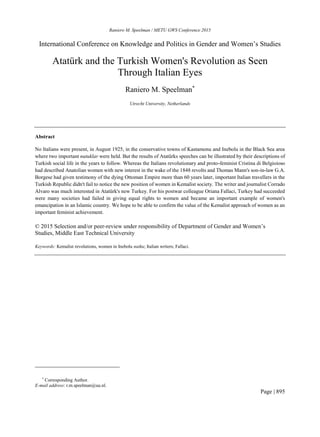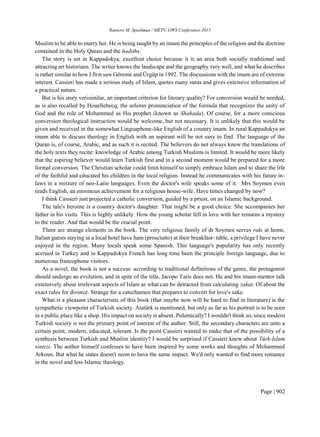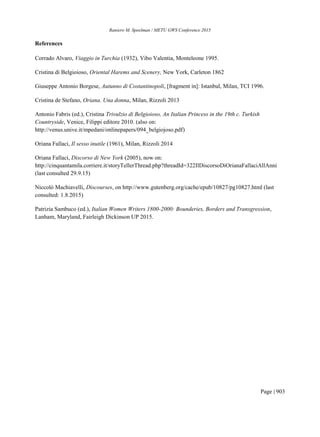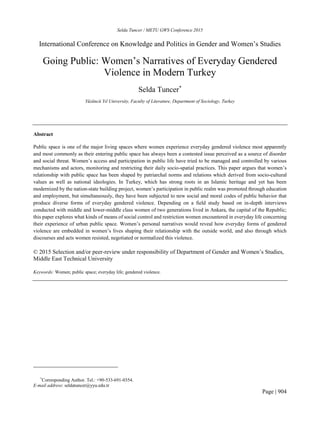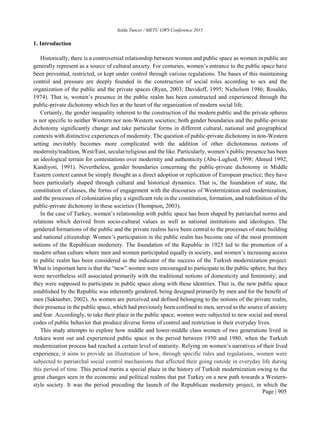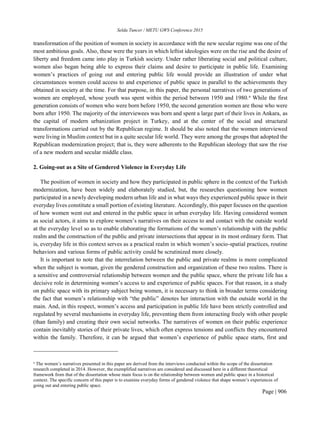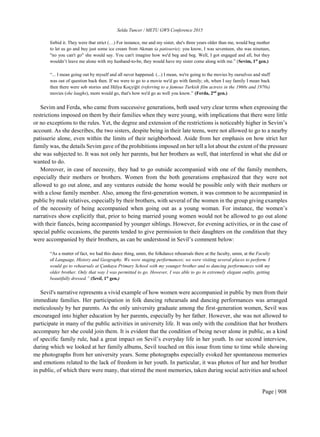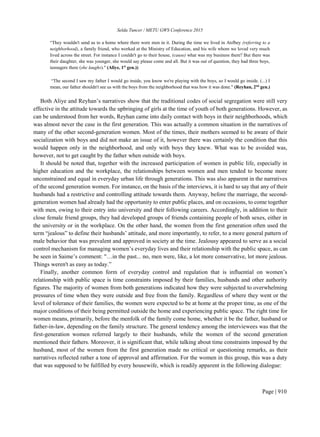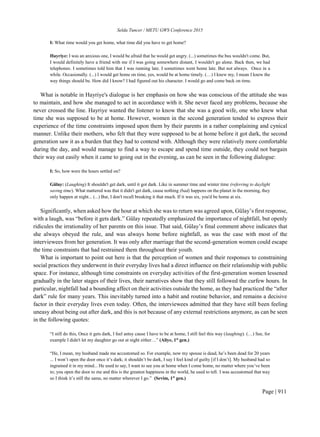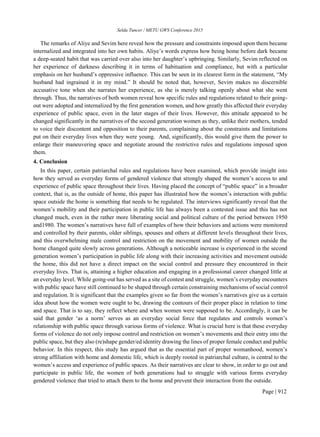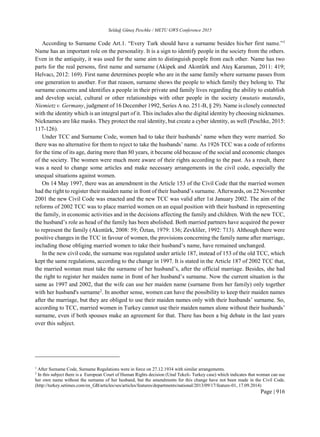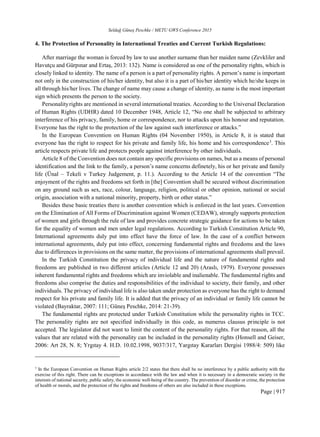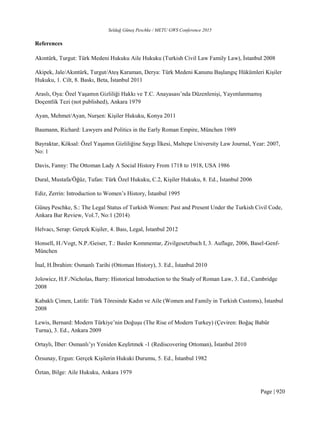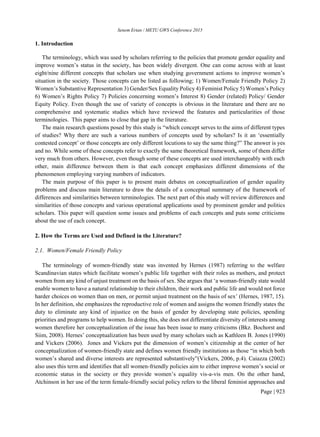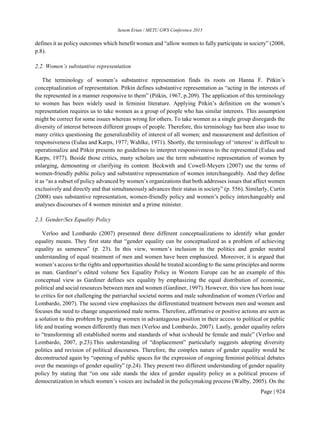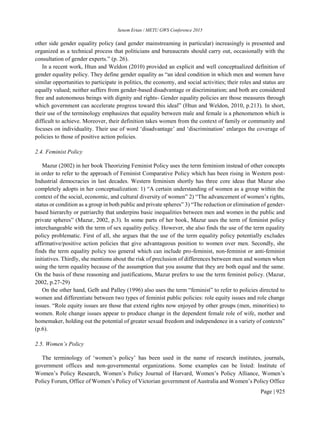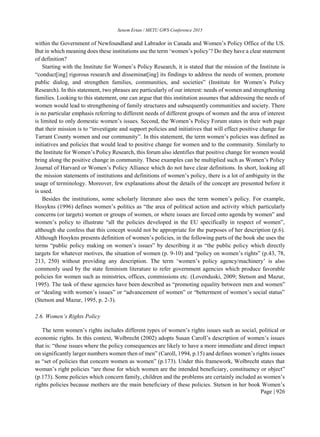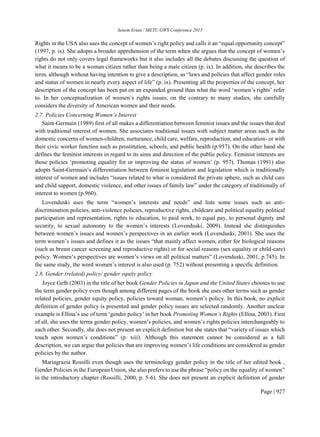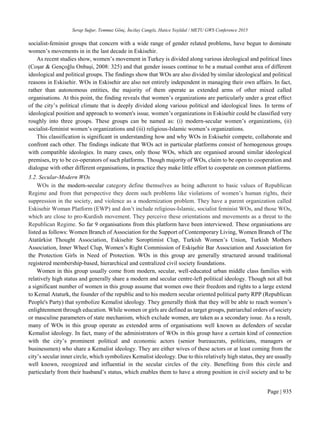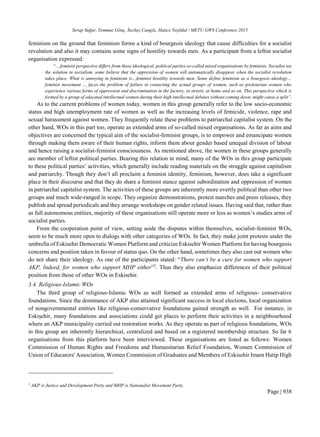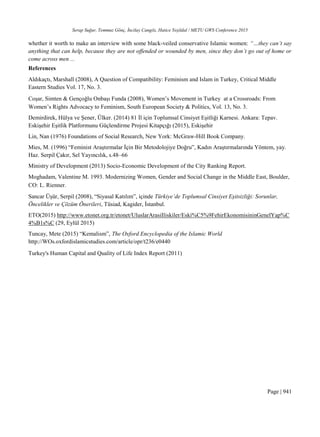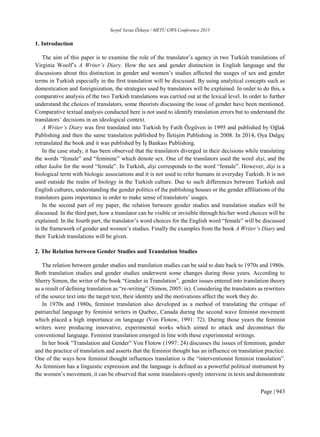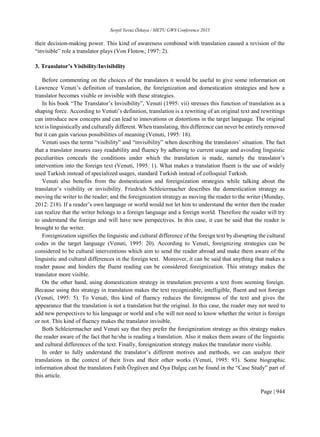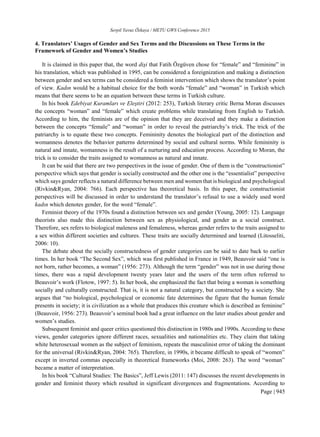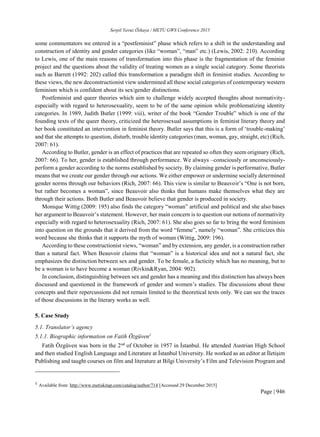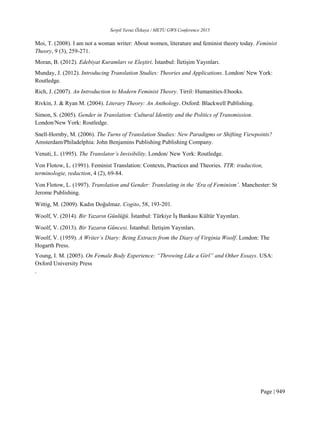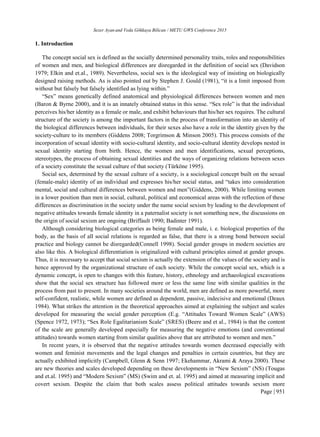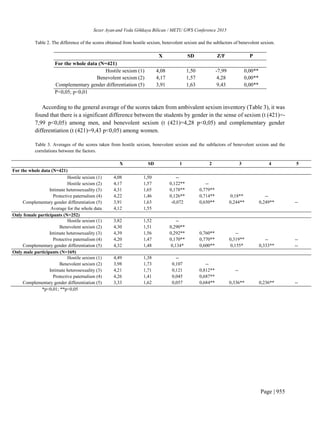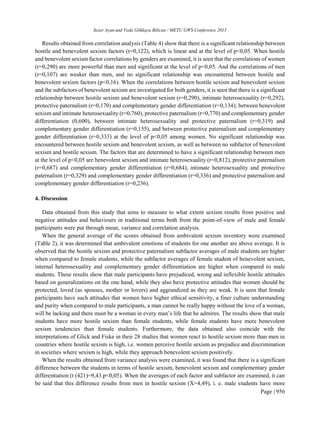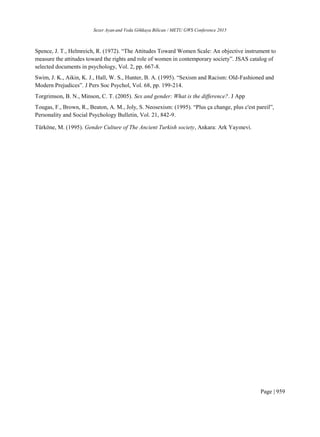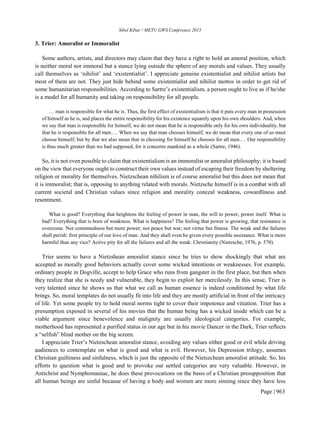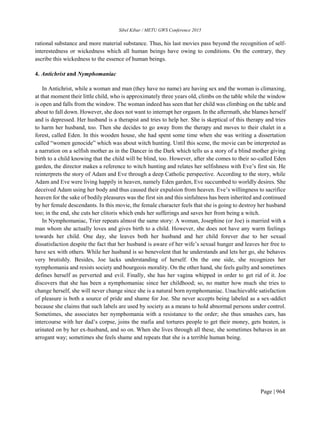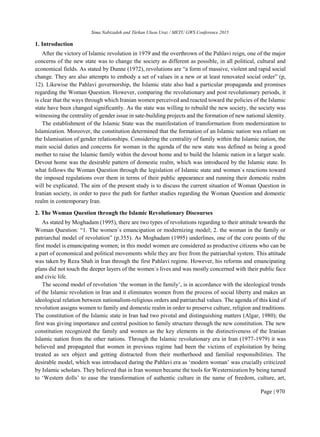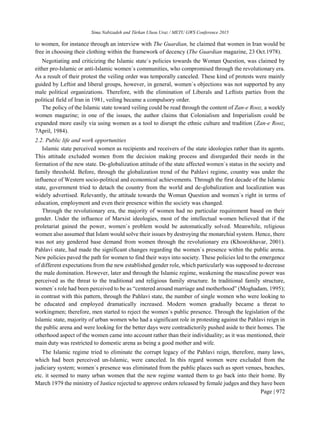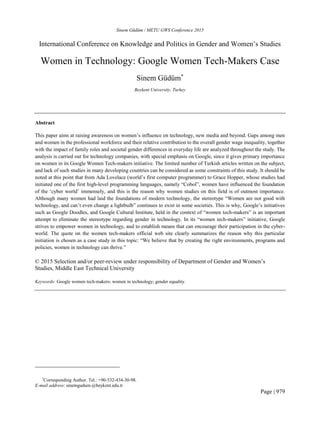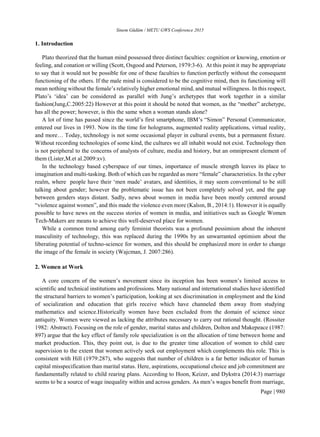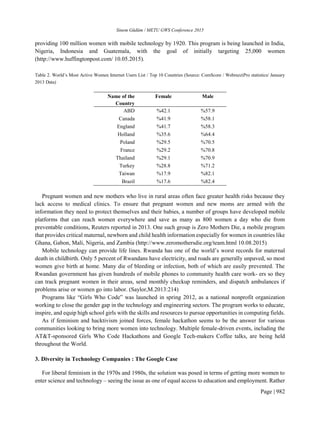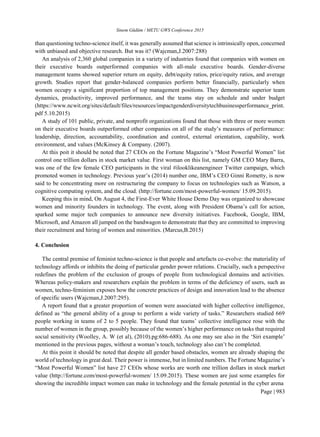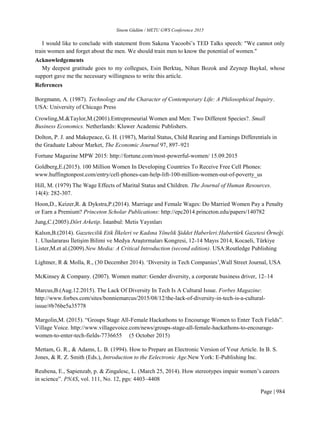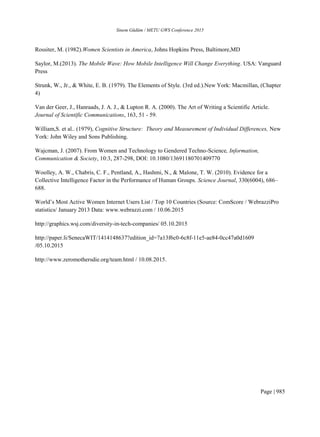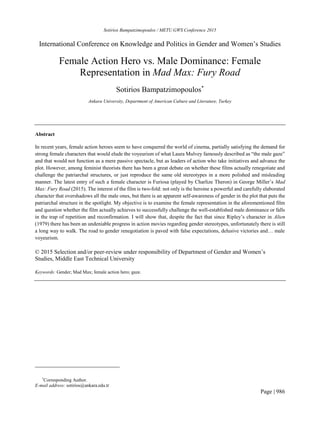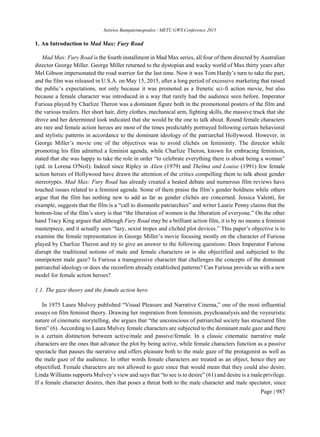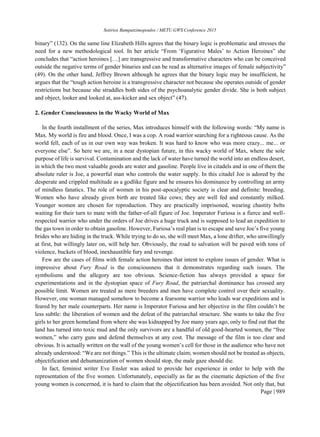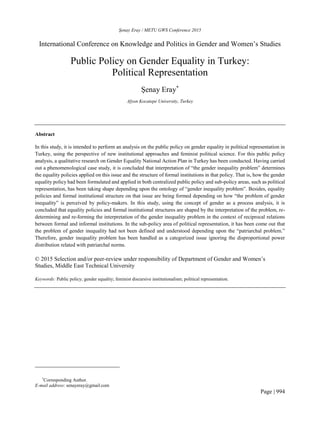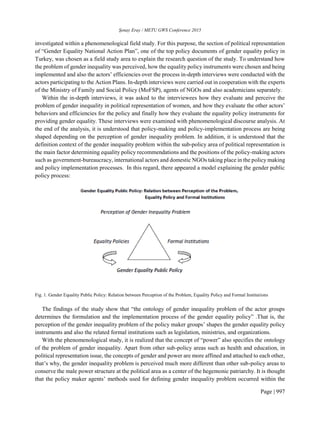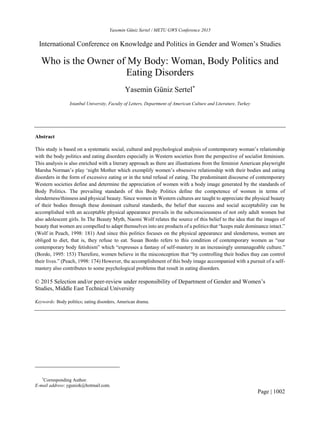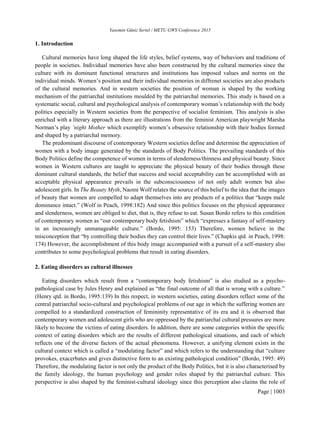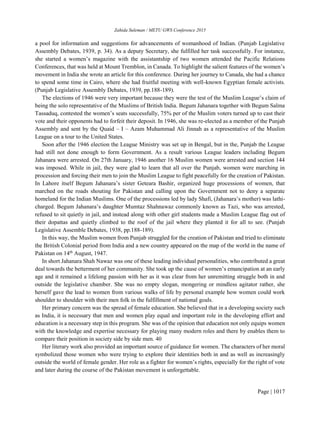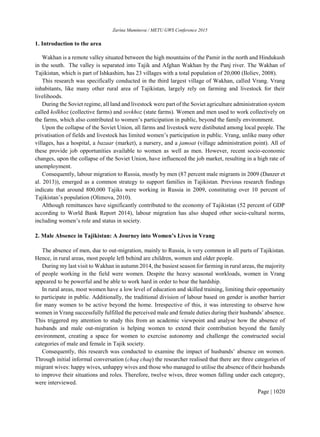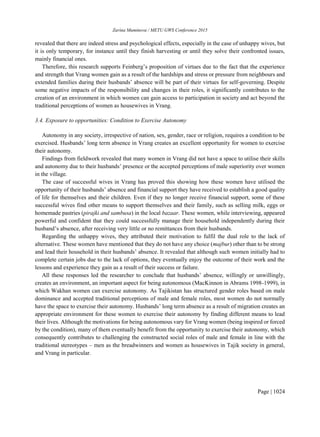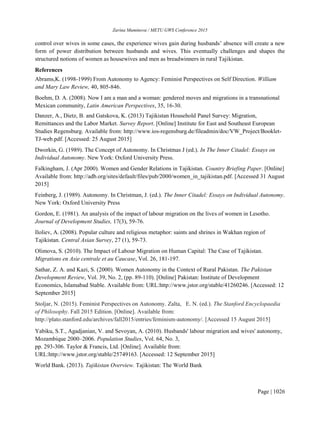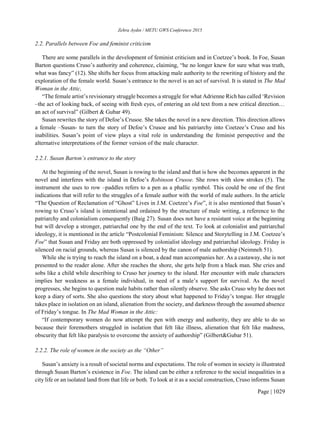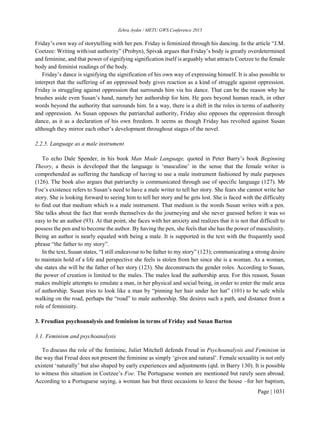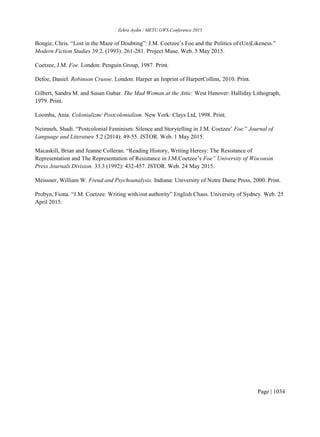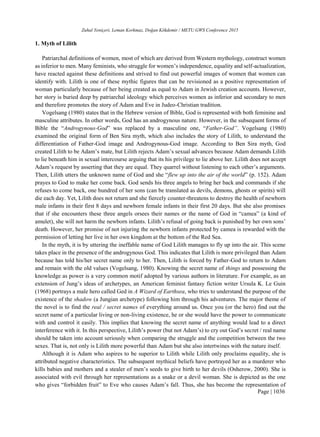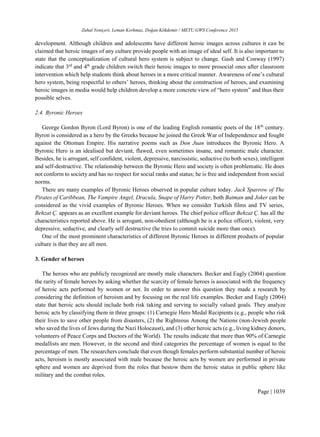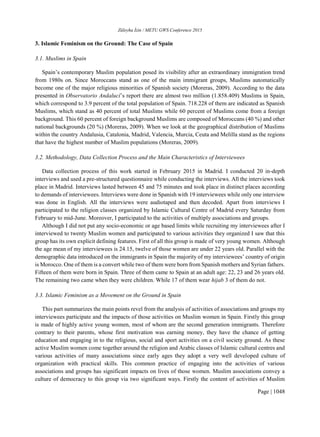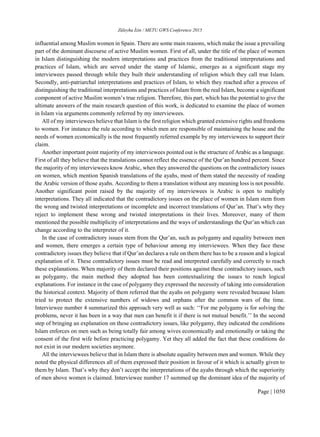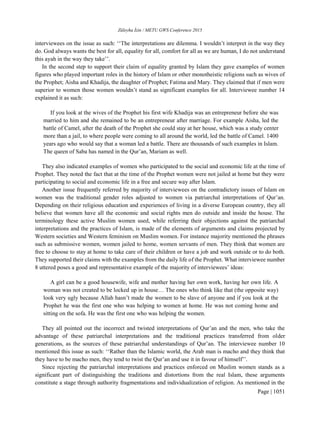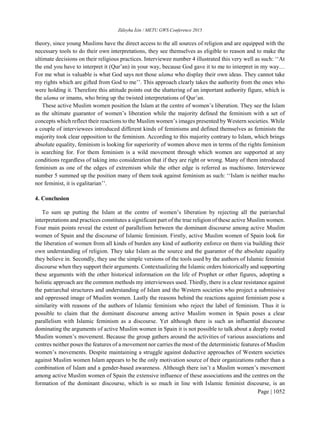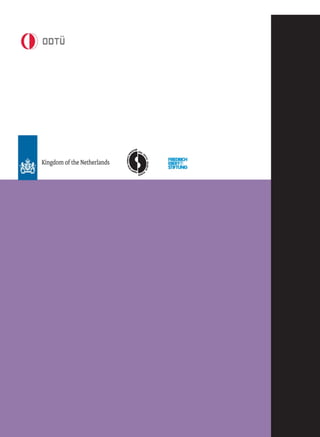This document provides information about the copyright and committees for the proceedings of the International Conference on Knowledge and Politics in Gender and Women's Studies 2015. It lists the scientific committee, advisory board, organizing committee, and student support team for the conference. It also provides copyright information, stating that abstracting and nonprofit use is permitted with credit, and instructors can print isolated articles for noncommercial use without fee. The document contains the conference committees, table of contents, and foreword for the proceedings.
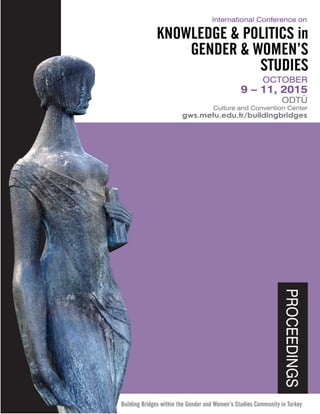






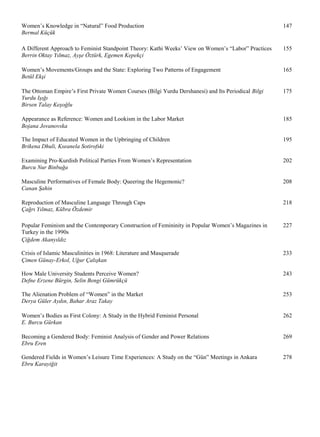
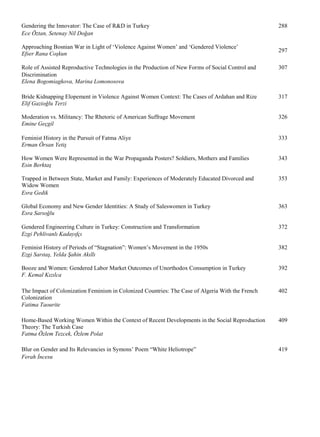
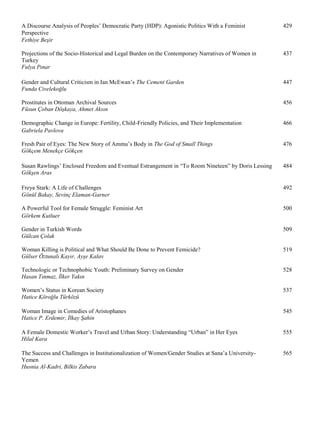




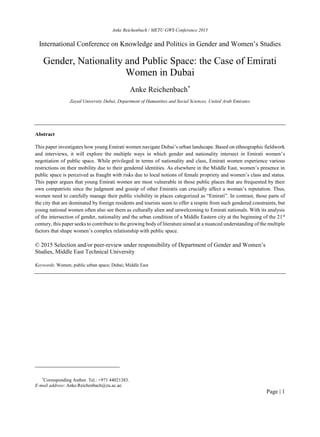

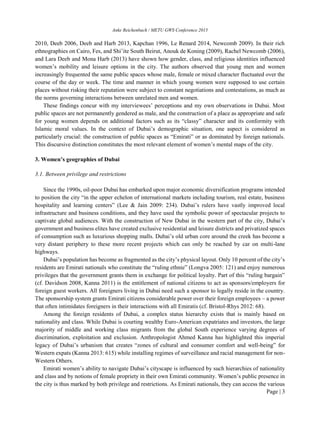
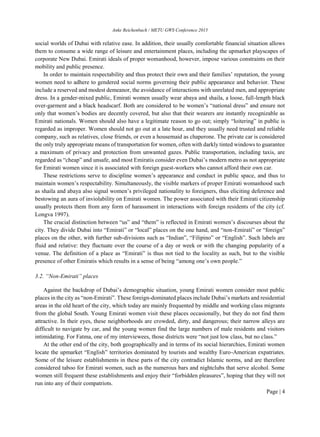
![Anke Reichenbach / METU GWS Conference 2015
Page | 5
Western places that are more acceptable from a religious point of view, enjoy a wider popularity among
young Emirati women, such as art galleries, flea markets, non-chain coffee shops, second-hand bookstores,
or sports facilities. The young women often perceive such places as easy-going, permissive environments
where they can relax from the strict gendered norms of their own Emirati environments.
As clearly recognizable “outsiders”, however, they do not always feel entirely comfortable there.
Emirati friends told me that they were often openly stared at or photographed without permission, usually
by tourists who were thrilled to finally see an Emirati woman. Some Emiratis also felt that many expatriates
resented their presence in Western places, as if they were, as Amira put it, “a problem to come”. While
some Emiratis understand this unwelcoming attitude as postcolonial arrogance, others assume that
foreigners are simply afraid of unintentionally upsetting one of the supposedly all-powerful nationals and
having to face harsh consequences. Irrespective of the reasons, the occasionally annoyed reactions of
expatriates in “white” places make Emirati women sometimes feel “out of place” and not particularly
welcome.
3.3. “Emirati” places
In contrast to Dubai’s numerous non-Emirati territories, young Emirati women’s geographies of the city
contain only few places labeled as “Emirati”. Those include the luxurious Dubai Mall, especially on
weekends, a handful of smaller, elegant malls along the coast or near Emirati residential areas further inland,
and the newly opened entertainment and shopping districts Citywalk and Box Park. All “Emirati” places
share a number of characteristics: They are perceived as orderly, clean, safe and morally impeccable; they
are associated with an exclusive global culture of consumption, and they are privately owned, with security
staff, surveillance cameras and “courtesy policies” that discipline visitors’ behavior and dress. Similar to
the coffee shops explored by Lara Deeb and Mona Harb (2013) in Beirut, they thus “blur the borderline
between public and private spheres by domesticating public space” (2013: 27).
Most young Emirati women spend much of their leisure time in these places, mainly in the malls. There
they socialize with female friends, go to the movies, visit coffee shops and restaurants, stroll, or go
shopping. For them, malls are convenient and respectable places that considerably expand their access to
public urban space (cf. Abaza 2001, Akçaoǧlu 2009, Le Renard 2015). As Najma explained, women’s
families assume that malls provide a protective environment for their daughters, sisters, or wives:
“Our parents think that malls are safe. […] With the malls, it’s the idea that they know where you are, and that you are locatable.
And that they know everyone, especially from the Emirati society which is very small, and they all know each other. Which means
that someone is going to be there who knows you, in a way. So, it’s so much safer.”
As Najma’s quote highlights, malls and other Emirati places are, on the one hand, places where the
young women can feel “at home”, but on the other hand, they are also the public arenas where young
women’s conduct and appearance are most closely monitored and judged by their own compatriots.
Through displays of socially desirable feminine behavior and decent but elegant dress, accessories, perfume
and make-up, young women have to uphold the good reputation and status of their families. Under the
scrutinizing gazes of other Emiratis who “love to judge and gossip,” young women need to demonstrate
time and again that they are “respectable young ladies” who obey the rules of their society, as Firiyal, one
of my friends, put it. In Emirati places, the boundaries between men and women are more strictly policed
than in other environments, and even the most adventurous of my interviewees told me they would not dare
to enter a place that was full of Emirati men, fearing harassment and gossip. Thus, “Emirati” places](https://image.slidesharecdn.com/59efbcce-7adc-4ccf-9a99-524cc539d6df-160605031959/85/My-published-research-19-320.jpg)
![Anke Reichenbach / METU GWS Conference 2015
Page | 6
constitute rather ambivalent environments for young national women: The places where they are among
their own compatriots also harbor the greatest risks for their reputations.
But even this intense social control cannot prevent young Emiratis from transgressing moral boundaries.
Many young women find the gender-mixed character of malls and other “Emirati” places tantalizing, since
only this kind of leisure environment offers the chance to playfully interact and flirt with Emirati men.
Fatma explained:
“We cannot have such interactions with men anywhere else. We have family gatherings, we have male cousins, but we cannot
just chitchat with them. It’s not good, it’s not decent. […] The eyes of the family are always on us, on the girls. You shouldn’t do
anything, you should be good, an angel, and you shouldn’t be naughty, you know. It’s nice to have a different kind of interaction
sometimes.”
Since this “different kind of interaction” between unrelated men and women is socially frowned upon,
however, it cannot take place in settings such as coffee shops or restaurants where accidental observers
could easily take notice. Instead, such clandestine interactions occur in the transit and passage zones of
“Emirati” territories, in interstices and on back-stages, where people keep on moving and encounters are
fleeting. While circulating through the malls’ passages, on their way through the malls’ car parks, or while
driving at night along well-known “flirt roads” such as Jumeirah Beach Road, Emirati men and women
exchange glances and smiles. They engage in playful banter and mutual teasing; young men approach
women with small gifts such as CDs with love songs, roses, or chocolates and attempt to persuade them to
accept their telephone numbers. Men and women pursue each other in their cars and interact from vehicle
to vehicle through half-open windows.
In such encounters, young Emiratis defy social norms and subvert the hierarchies of gender and
generation (cf. Wynn 1997). However, even during such fleeting encounters women need to protect their
reputation by remaining anonymous, e.g. by exchanging mobile numbers that are not registered in their
names, or by remaining half-hidden behind tinted car windows. “Nothing can bring shame on men,” a
popular proverb states. Young Emirati women’s reputations, however, are much more vulnerable, particular
in those public places where the women ostensibly belong.
4. Conclusion
Amira, the young woman quoted at the beginning, had emphasized her sense of being under constant
scrutiny in the public spaces of Dubai. As this paper has shown, other Emirati women share her sentiments
of being exposed to different kinds of judgement by various audiences in the city. While the places
categorized as “non-Emirati” appear to offer a respite from the gendered constraints prevalent in Emirati
environments, they are often also perceived as unwelcoming to Emirati nationals. “Emirati” places on the
other hand are viewed as safe, respectable and morally impeccable, but there, women experience the most
intense pressure to adhere to strict gendered norms. Hence, they harbor the greatest risks for a woman’s
reputation and social prospects. Yet, the assumption cherished by many families that “Emirati” places offer
no room for transgressions underestimates young women’s (and men’s) creativity and ingenuity in
subverting mechanisms of social control and appropriating public spaces for their own agendas. It is the
passages and transit zones of Emirati territories and thus mobility itself that enables young Emiratis to resist
scrutiny. But even in such fleeting encounters, young women bear the greater risks since it is their
compatriots’ moral judgement that, in the words of Najma, “can literally define your future.”
Acknowledgements
I wish to thank Carla Bethmann for inspiring discussions and her insightful and critical comments on an
earlier version of this paper.](https://image.slidesharecdn.com/59efbcce-7adc-4ccf-9a99-524cc539d6df-160605031959/85/My-published-research-20-320.jpg)
![Anke Reichenbach / METU GWS Conference 2015
Page | 7
References
Abaza, Mona (2001) Shopping Malls, Consumer Culture and the Reshaping of Public Space in Egypt.
Theory, Culture & Society 18/5: 97-122.
Afsaruddin, Asma (1999) Introduction: The Hermeneutics of Gendered Space and Discourse. In: Asma
Afsaruddin (ed.) Hermeneutics and Honor. Negotiating Female “Public” Space in Islamic/ate Societies.
Cambridge: Harvard University Press, 1-28.
Akçaoǧlu, Aksu (2009) The Shopping Mall. The Enchanted Part of a Disenchanted City. The Case of
ANKAmall, Ankara. In: Johanna Pink (ed.) Muslim Societies in the Age of Mass Consumption. Politics,
Culture and Identity between the Local and Global. Newcastle: Cambridge Scholars Publishing, 53-72.
Bianca, Stefano (1991) Hofhaus und Paradiesgarten. Architektur und Lebensformen in der islamischen
Welt. [Courtyard House and Paradise Garden. Architecture and Lifestyles in the Muslim World]. Munich:
C. H. Beck.
Bristol-Rhys, Jane (2012) Socio-spatial Boundaries in Abu Dhabi. In: Mehran Kamrava & Zahra Babar
(eds.) Migrant Labor in the Persian Gulf. London: Hurst & Company, 59-84.
Dahlgren, Susanne (2010) Contesting Realities. The Public Sphere and Morality in Southern Yemen.
Syracuse: Syracuse University Press.
Davidson, Christopher M. (2008) Dubai: The Vulnerability of Success. New York: Columbia University
Press.
Deeb, Lara (2006) An Enchanted Modern. Gender and Public Piety in Shi’i Lebanon. Princeton:
Princeton University Press.
Deeb, Lara & Mona Harb (2013) Leisurely Islam. Negotiating Geography and Morality in Shiʻite South
Beirut. Princeton: Princeton University Press.
De Koning, Anouk (2009) Gender, Public Space and Social Segregation in Cairo: Of Taxi Drivers,
Prostitutes and Professional Women. Antipode 41/3: 533-556.
El Guindi, Fadwa (1999) Veil. Modesty, Privacy and Resistance. Oxford: Berg.
Holmes-Eber, Paula (2003) Daughters of Tunis. Women, Family, and Networks in a Muslim City.
Boulder: Westview Press.
Kanna, Ahmed (2011) Dubai. The City as Corporation. Minneapolis: University of Minnesota Press.
Kanna, Ahmed (2013) “A Group of Like-Minded Lads in Heaven”: Everydayness and the Production of
Dubai Space. Journal of Urban Affairs 36/S2: 605-620.
Kapchan, Deborah (1996) Gender on the Market. Moroccan Women and the Revoicing of Tradition.
Philadelphia: University of Pennsylvania Press.
Lee, HongJu & Dipak Jain (2009) Dubai’s brand assessment success and failure in brand management –
Part 1. Place Branding and Public Diplomacy 5/3: 234-246.](https://image.slidesharecdn.com/59efbcce-7adc-4ccf-9a99-524cc539d6df-160605031959/85/My-published-research-21-320.jpg)
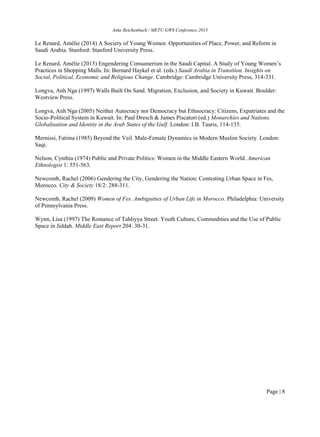

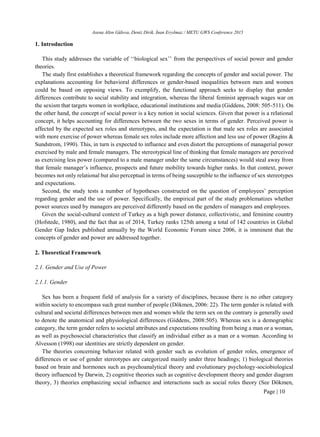
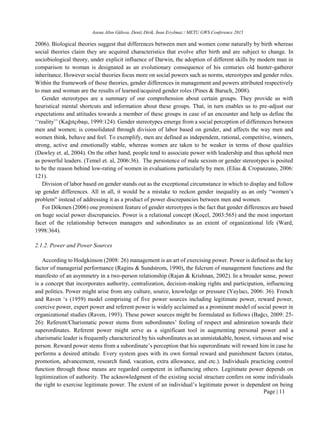
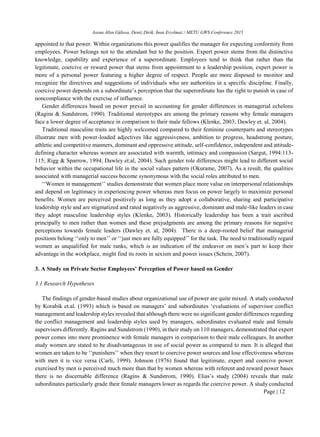
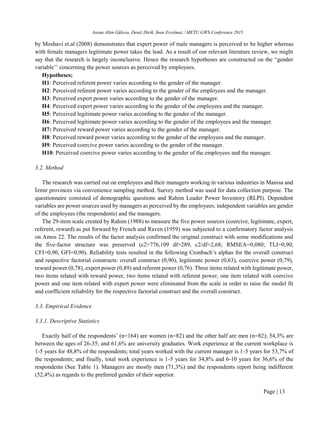
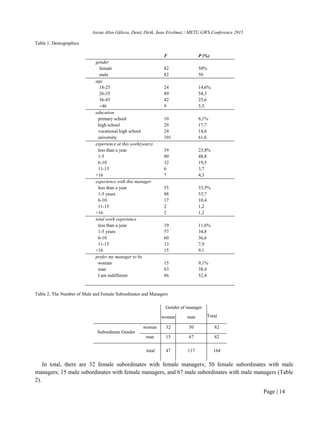
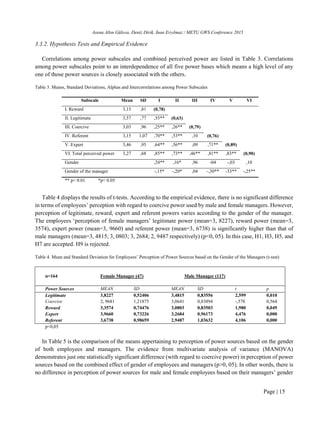
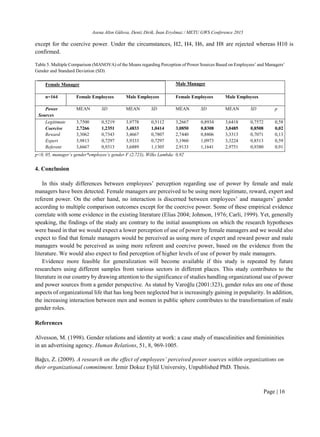
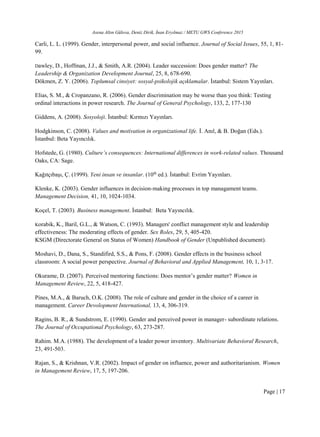
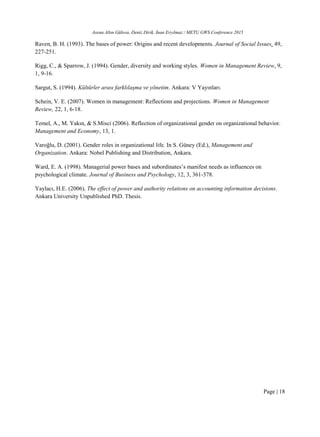

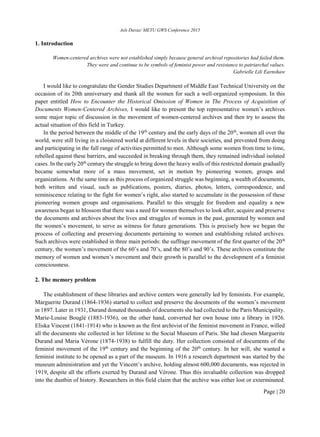




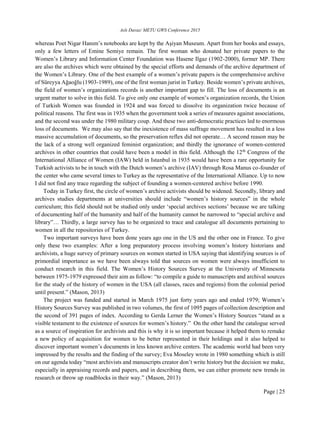

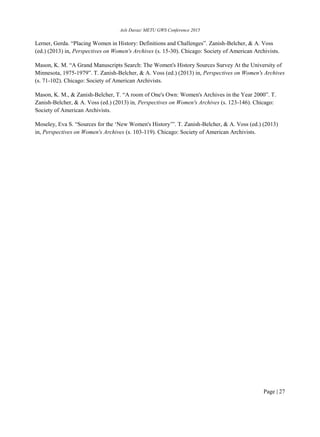


![Aslı Polatdemir and Charlotte Binder / METU GWS Conference 2015
Page | 30
Table 1. Information about conducted interviews
Cities Ankara Diyarbakır Aegean Region
(Denizli, Muğla)
East Black Sea Region
(Trabzon, Artvin)
Period of field
research
03.-04.2014;
09.-10.2014
03.-04.2014;
04.2015
03.-04.2015 06.-07.2015
Number of
conducted
interviews
20 9 18 18
2.1. Topic of research: diversity of women’s movements
The universal category of gender is a topic which is open to discussion in poststructural, (queer-) feminist
and postcolonial theory, as well as in the identity politics put forward by new social movements. In the
process of social-constructivist transition in Women’s and Gender Studies, the up-to-now collectivist
aspects of women’s movements were questioned (Lenz 2002: 78).
Aside from exploring coalitions and solidarity in women’s movements in Turkey, this project also puts
special emphasis on the integration of this diversity aspect in its research scope. Thus, it is of importance
to discuss the project’s title. Due to reflection of universal debates on collective subjects of women’s
movements, we decided to apply a feminist-oriented social movement research theory, which
conceptualises women’s movements as plural-differentiated and transnationally oriented (Lenz 2014).
While putting an ‘-s’ at the end of women’s movement and feminism, we, as the members of research
project, do aim to include diverse perspectives. Even if the analysis of our interview material is in an early
stage, our first findings could shed light on the specific area which we are targeting. If interviewees have
different positions on certain topics, this plural ‘-s’ plays an important role and it needs to be emphasised.
İlknur Üstün, coodinator of the Women’s Coalition in Ankara, underlines the necessity of touching upon
the topic with special awareness:
[…] it is important to recognize the diversity, it is a dynamic structure, in all of these
diversities, differences it would not be fair to lump them together […]it is necessary to talk
about a process when you talk about woman, women’s movement or movements in Turkey.
(İlknur Üstün 2014)
Violence against women and the ruling government’s misogyny lead to the development of spaces and
platforms for coalitions and solidarity, as Gaye Cön, member of the woman centre KAMER from Muğla,
points out: “Because each passing day there are more attacks against woman by the government, we often
come together there, that is to say if I think about Turkey in general.” (Gaye Cön 2014)
However, the beauty of the matter lies not merely in that solidarity should always be pursued, or that
coalitions should be formed for everything, but rather in the colourful mosaic of different groups attempting
to work together to effect social change. Bahar Bostan, member of the Women’s Rights Commission of
Trabzon Chamber of Lawyers, aptly describes it in the following passage:
Islamist women, Kurdish women, Turkish women - like socialist feminists, Turkish
Women’s Association - we all unite. Especially in case of the state’s invasion of our spaces.
However, when human rights and ethnic issues are on the table, or political matters, or
political differences, we go our separate ways. Well, when we analyse this as Kurdish](https://image.slidesharecdn.com/59efbcce-7adc-4ccf-9a99-524cc539d6df-160605031959/85/My-published-research-44-320.jpg)
![Aslı Polatdemir and Charlotte Binder / METU GWS Conference 2015
Page | 31
Women’s Movement, Turkish Women’s Movement or Secular Women’s Movement, Islamist
Women’s Movement, we disintegrate. (Bahar Bostan 2015)
Nebahat Akkoç, founder of KAMER and based in Diyarbakır, comments on the intersectional perspective
and discusses the interdependent character of women’s issues in the country:
[…] the main issue in Turkey is still the existence of prejudices and discrimination; I have
the impression it is about a lack of clear decisions on whether we want to be on the side of
the leading power, or whether we want to remain independent […] we still cannot talk,
understand the woman issue as independent, abstracted from the system, as a disconnected
issue from other matters, so it remains disconnected. (Nebahat Akkoç 2015)
Interviewees, depending on what group they identify with, had diverse perspectives on, for instance,
LGBTI rights, sex work or education in their mother tongue. At this point, representation of diversity
remains the focal point of this research project.
2.2. Reflection of research: questions on representation
Postcolonial theorist Spivak (2008) underlines postcolonial criticisms of representation and knowledge
production of Eurocentric research. This research project aims to gain understanding by borrowing from
feminist and postcolonial theories in order to properly deal with the delicate matter of this “crisis of
representation” (Winter 2011: 76). This recognition of the (re-)construction of reality, knowledge
production and epistemic rupture are the leading framework for our approach in the analysis of the
interviews.
Said’s concept of othering and orientalism (1979) is very helpful when reflecting on the role of
researchers from Germany/Europe, and when exploring possible approaches in the fight for women’s
equality in Turkey. However, it cannot tell us much about the epistemic assimilation effects that can also
be observed. Thus, with reference to Spivak’s concept of epistemic rupture, we want to briefly explain what
we refer to when we speak of epistemic assimilation: when discussing the rupture between different
discourses, Spivak stresses that every discourse has its own language, its own narratives and its own rules.
Therefore, the forms of interaction in one discourse can be very different from those in another discourse.
Thus, what counts as adequate or as a good argument is very different in each of those discourses. Following
this approach, the planned report on women’s movements in Turkey has to avoid linear references to the
German/European discourse of gender struggle when interpreting developments in Turkey. Because when
Western epistemic categories are applied in the description of occurrences, it dismisses the discursive
properties of the culture this research is studying. To understand, but not to assimilate the activists in Turkey
to a German perspective, it is necessary to find out in which categories they are speaking of themselves in
order to grasp their self-understanding and their motivation. Taking this into consideration, our aim in the
final report is to move beyond orientalist views on women in Turkey, and paint a detailed and appropriate
picture of what it means to be a woman in Turkey, and what her struggles are.
How does our research team deal with the ‘crisis of representation’, both in theory and in practice?
Theory-wise we refer to the aforementioned postcolonial theory and critics of orientalism. This research
project was designed to be an empirical study, meaning attempts to bridge the gap between empirical
research and theory need to be refined with a special standpoint. The standpoint model of research was
developed by feminist social scientists in the late 80s (Harding 2004). In brief, various social positions](https://image.slidesharecdn.com/59efbcce-7adc-4ccf-9a99-524cc539d6df-160605031959/85/My-published-research-45-320.jpg)
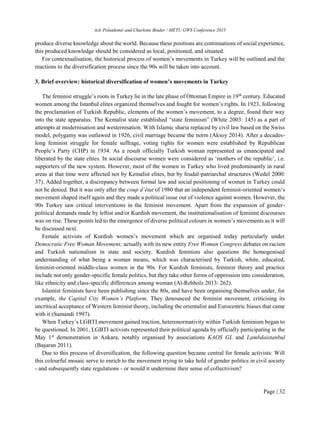
![Aslı Polatdemir and Charlotte Binder / METU GWS Conference 2015
Page | 33
How will we stand side by side? How will we stand as one? How will we recognize each
other’s different experiences and struggle for each other’s’ rights? How will we get
organized around our gendered identities with our ethnic, cultural, class-related, sexual,
regional, religious and bodily differences? (Bilal 2006)
This chain of questions, put forward by the Armenian feminist and academician Melissa Bilal, clarifies
why debates on the politics of solidarity, and on coalitions within the feminist movement happen, despite
their differences. Because of contributions from antiracist, antimilitarist and queer perspectives between
then and now, autonomous feminists aim to approach to Kurdish women and LGBTI groups. Their mutual
opponent, patriarchal structures are identified which oppress women, LGBTI individuals and members of
ethnic and religious minorities through sexism, heterosexism, racism and/or militarism (Acar Savran 2011).
An example of solidarity between feminists and religious-conservative women is the platform ’We stand
by one another’, which was established by female activists, journalists and academics as a reaction to the
headscarf debates in 2008. Women only partly affected by the headscarf ban, came together and insisted
that female students with a headscarf be freely allowed into university buildings, and thus protected from
discrimination based on gender and/or religious affiliation (Koç 2009).
However, because of their experiences within leftist movements in the 70s, many autonomous feminists
have only collaborated sparingly with leftist and Kemalist-oriented women (Somersan 2011: 100 – 123).
Despite all mutual concerns and the diversification process in the frame of historical steps of women’s
movements in the country, how could (im-)possibilities of solidarity and coalitions be put on the table while
there are endless responses and subjective concepts of “being-a-woman”?
4. (Im-)Possibility of coalitions despite of diverse reflections on “being-a-woman“?
There are many different responses to the interview question “Being a women - what does it mean to
you?”:
[…]we talk about a creature which maintains its life, contributes hugely to social
relations, but with its other part being oppressed, exploited, in other words like summation
of being subject and object. (Figen Aras 2015)
[…] she is in part a biological creature, with reproductive organs and breasts, but […]
being a woman means one has to carry lots of things together with place, culture and people
you live with. Both living its delightfulness but more struggle with its difficulties. (İlknur
Üstün 2014)
[…] being a woman is also something we learn about. [...] all cases of being woman, man
and so forth are speculative for me and personally my thing is, you know if the current
situation would not be like this, I would not emphasize my female identity, I would not make
women’s policy. In other words because it does not fit to my attitude, I love to define myself
as a woman as well as a man rather than only as woman or man. But actually you know I
insistently stress my woman identity because we live in a terrible state of society, surely I
believe it is necessary to struggle for this. (Pelin Kalkan 2014)
Since we have endless explanations of what being a woman even means, how can we even talk about
whether all women can fight together? Interviews conducted in 2014 and 2015, and literature analyses](https://image.slidesharecdn.com/59efbcce-7adc-4ccf-9a99-524cc539d6df-160605031959/85/My-published-research-47-320.jpg)

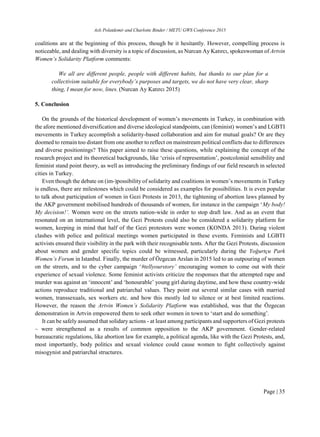

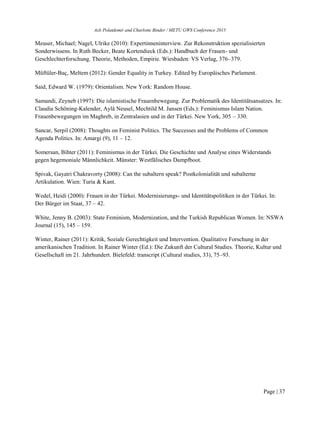
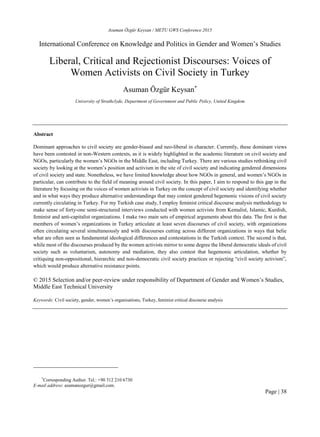

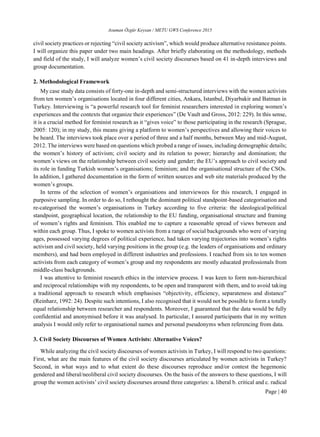

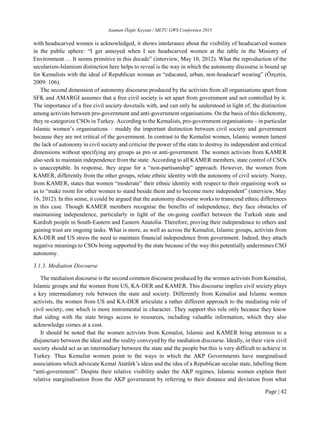

![Asuman Özgür Keysan / METU GWS Conference 2015
Page | 44
such relations arise from within civil society or between CSOs and the state. The anti-hierarchy discourse is
mainly discussed with regard to relationships within CSOs, and specifically the issue of representation and
leadership.
The critique of hierarchy dovetails for many of my interviewees with their critique of patriarchy. The
women activists from SELİS and KAMER certainly identified male dominance as one of the roots of
hierarchy. As Reşide, one of the youngest activists from SELİS, comments, “We grow up with this
hierarchical structure in which mother is always in the kitchen, is responsible for the child care and the father
works outside. It is all these little things we grow up with” (interview, May 22, 2012). The fact that
dominance in the family translates into dominance of men in mixed group decision-making processes in civil
society annoys these women, and is contrary to their equality-based understanding of civil society. In line
with this approach, the CSOs dominated by men and attributing traditional gender roles to women are called
into question as Reşide from SELİS articulates in the following extract: “…for example, in one of the
meetings I participated in, there were some women who can said that “if a woman does cleaning at home,
gets along well with her husband, she is not exposed to violence”...there are also civil society organisations
[that support this kind of idea]” (interview, May 22, 2012).
Differently, some interviewees from KA-DER and AMARGI emphasize that the transformation of civil
society can only be realised by feminism. While integrating a feminist approach into civil society is
acknowledged as being “difficult due to the dominance of hierarchies within and between the civil society
organisations” (interview with Çiçek, KA-DER, July 21, 2012), Duygu, one of the oldest members of
AMARGİ that I interviewed, argues that feminism has already had a significant impact on civil society. She
says that “it is feminism that will bring horizontal organisation into the society … and should develop
relationships with civil society” (interview, June 2, 2012).
3.2.3. Democratization discourse
The emphasis on the democratic outcomes of the promotion of civil society activism lies at the heart of
democratization discourse, which is circulated by the women from the KAMER, SELİS, US and KA-DER.
Nonetheless, these women activists from two different groups have different ideas about what the main goal
of democratization should be. Whereas almost all of women from KAMER and SELİS evoke a civil society
area free of discriminatory ideas and practices, women from US and KA-DER refer to a civil society space
which becomes more civil through the promotion of active-citizenship.
The interviewees from both Kurdish organisations focus their attention on the need for civil society to
combat discrimination. They frame discrimination between and within CSOs as a “democratic failure”, and
their emphasis upon it is linked to the regional and ethnic problems they encounter as Kurdish women and as
individuals working within Kurdish women’s organisations. In the first place, they argue that they face
discrimination on the basis of ethnic difference coded in geographical terms. Thus Nuray from KAMER
mentions that she is bothered by some people from other organisations referring to her as “coming from the
Eastern part of Turkey” (interview, May 16, 2012), i.e. the Kurdish regions of Eastern and South-Eastern
Anatolia. As noted by Derya from KAMER: “One of the problematic areas in the civil society is
discrimination … We can see it when we go to the West from the East [of Turkey] for project work. When I
say I am from Diyarbakır [a city in Eastern Anatolia], you can see eyebrows are raised, because they have
some type of profile in their minds, and they get surprised if the person they met doesn’t fit into this profile....”
(interview, May 17, 2012). For Derya, this discrimination can even result in violence: she goes on to describe
a Women’s Shelter Congress held in 2012 in which “Our women friends coming from the East and South-
East were almost lynched, they had to be guarded and sent away after they felt their lives were in danger …
This is ridiculous … This is where we are in civil society” (interview, May 17, 2012). Unlike the women](https://image.slidesharecdn.com/59efbcce-7adc-4ccf-9a99-524cc539d6df-160605031959/85/My-published-research-58-320.jpg)






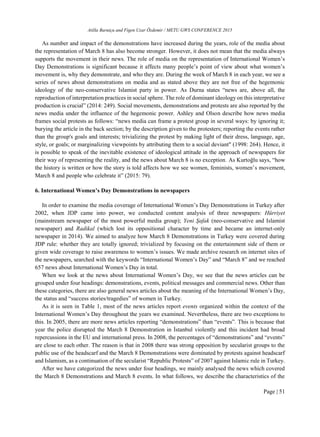
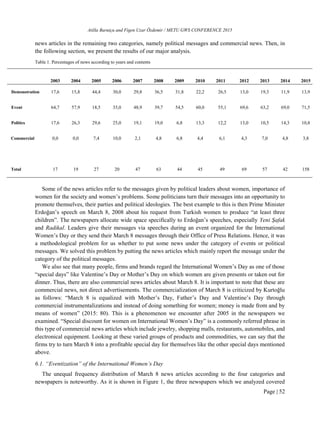
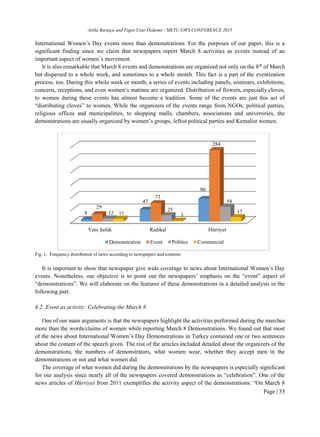
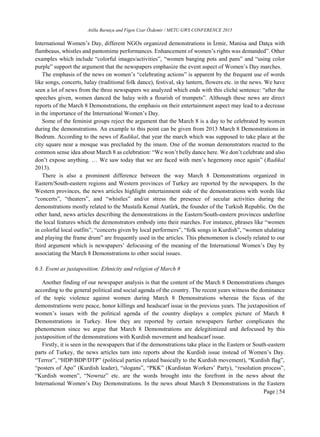

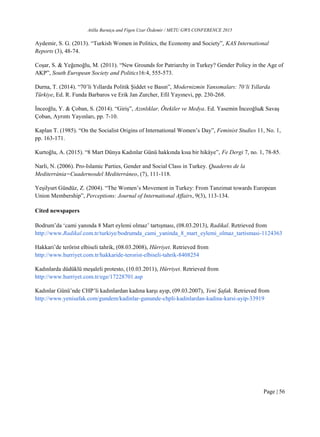






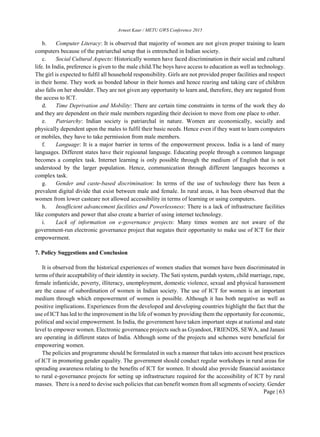
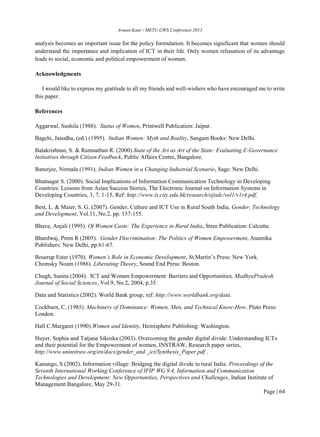

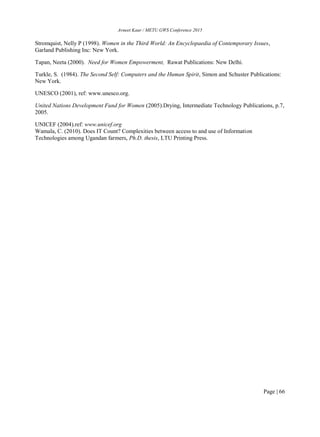




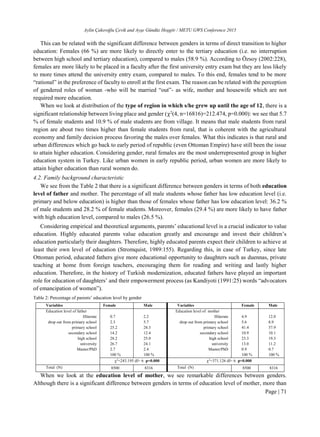
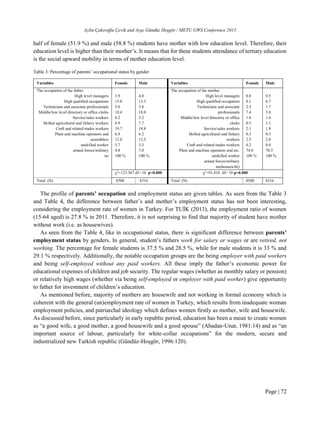

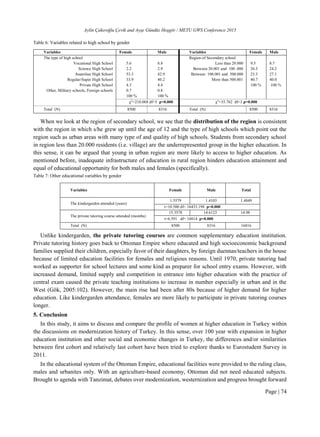
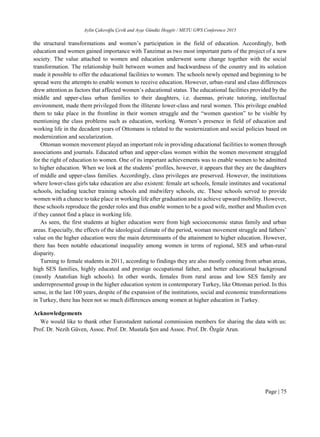
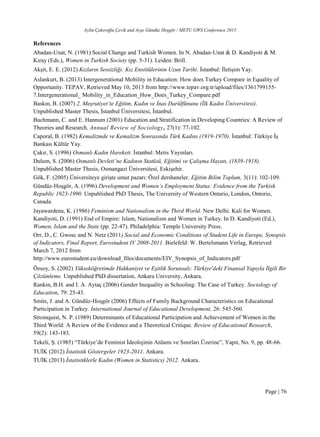
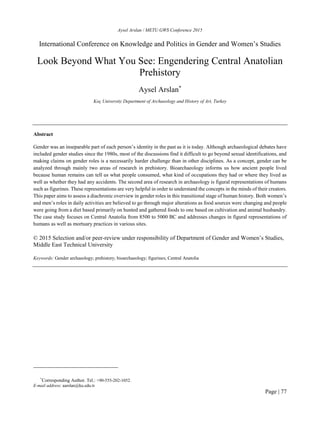
![Aysel Arslan / METU GWS Conference 2015
Page | 78
1. Introduction
When I mention to people that I research gender in the Neolithic period, the period when people first
settled down and decided to do agriculture, most of the time I get questions about matriarchy and the Mother
Goddess. The idea of a society ruled by women and the Mother Goddess seems to be still attracting a lot of
attention by the public. The public interest in gender-related issues in the past communities mainly revolves
around the power relations between males and females. But, how do we understand who was ‘wearing the
pants’ in the society if they are long gone? Archaeologists have an answer to this question.
In this paper, I first provide a historical background to gender archaeology and thereafter elaborate on the
use of bioarchaeological studies when considering gender. Bioarchaeology is one of the main sources of a
gendered approach since human body gives archaeologists a great amount of information about how people
lived, what they ate, and what they did regularly. This way it becomes easier to make assumptions about
gendered lifeways in earlier periods.
After that, I discuss figurine analysis and its impacts on gender archaeology. I especially examine the
mother goddess theory that dominated the archaeological interpretation of female figurines until the 1980s.
This theory has been disputed by many scholars (eg. Fleming 1969; Tringham and Conkey 1998), yet there
is still a contingent who supports this idea and proposes that women’s ritual power and importance in the
society stems from their biological roles as birth givers (eg. Roller 1999). Finally, I summarize my
interpretations of the changing gendered lifeways in Central Anatolia from 8500 to 5000 BC as a case study.
2. The History of Gender Archaeology
Anthropological studies that concentrate on women, power and early states started as early as the 1970s
and it became clear that it was necessary to understand women in ancient history in order to understand
women’s roles in history (Hutson et al. 2013: 45). Archaeological research on gender and sexuality developed
thereafter in the 1980s (Conkey and Spector 1984; Voss 2000: 181; Spencer-Wood 2000: 113; Spector 1996:
485).
However, gender theory in archaeology and anthropology, as in other fields of the social sciences, take
their roots from much earlier theories. The origins of the discussion go back to the hypothesis in Engels’
1884 book The Origin of the Family, Private Property and the State. Influenced by the post- enlightenment
theories, Morgan, and Bachofen, Engels proposed that there is a steady social development in human
evolution, and matrilineal and matriarchal societies were the original but the earliest social organizations
(Engels 1997[1884]: 12). He (1997[1884]: 14) discusses that in the earliest period of human civilization not
fathers, but mothers were highly esteemed because it was not possible to determine the biological father.
However, with the increase of wealth, men became more important than women in the family. He says “The
overthrow of mother right was the world historic defeat of the female sex.” (Engels 1997[1884]: 14, italics
in the original). With the appearance of monogamy, the first division of labor (childbearing), and the first
class oppression by males onto the females began (Engels 1997[1884]: 16).
In the 1970s, the feminist movement in anthropology and archaeology gained pace. In 1984, Conkey and
Spector wrote ‘Archaeology and the Study of Gender’, underlining that there is androcentrism in
archaeological and ethnological research. They criticized the archaeological approach to female roles as
females are less visible and regarded as separate from males (Conkey and Spector 1984: 6). It was generally
accepted that universal laws of behavior dictated male and female roles and relationships. In many cases,
although archaeologists did not think of women and gender, they were making assumptions or claims about
their roles and positions in prehistoric societies. While making these assumptions, they made use of western](https://image.slidesharecdn.com/59efbcce-7adc-4ccf-9a99-524cc539d6df-160605031959/85/My-published-research-92-320.jpg)

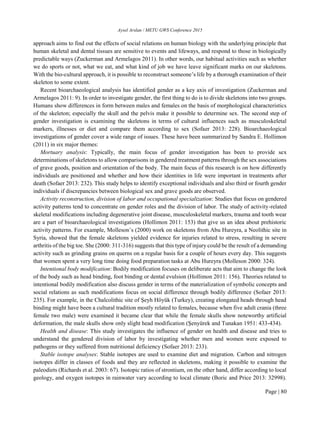

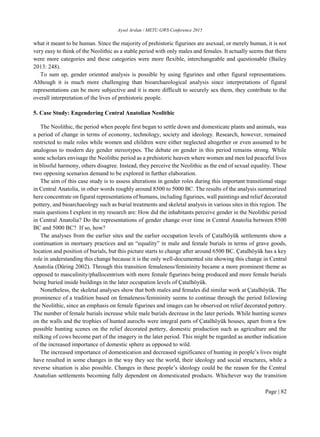
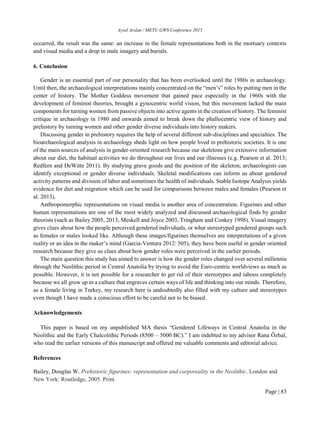
![Aysel Arslan / METU GWS Conference 2015
Page | 84
--- “Figurines, Corporeality, and the Origins of the Gendered Body.” A Companion to Gender
Prehistory. Ed. Diane Bolger. Pondicherry, India: Wiley and Blackwell, 2013: 244-264. Print.
Bolger, Diane. “Introduction: Gender Prehistory – The Story So Far.” A Companion to Gender Prehistory.
Ed. Diane Bolger. Pondicherry, India: Wiley-Blackwell, 2013: 1-19. Print.
Borić, Dušan, and T. Douglas Price. “Strontium isotopes document greater human mobility at the start of
the Balkan Neolithic.” Proceedings of the National Academy of Sciences 110.9, 2013: 3298-3303. Print.
Bourdieu, Pierre. Outline of a Theory of Practice. Trans. R. Nice. Cambridge: Cambridge University
Press, 1977. Print.
Butler, Judith. Gender trouble and the subversion of identity. New York and London: Routledge, 1990.
Print.
--- Bodies that matter: on the discursive limits of "sex". New York: Routledge, 1993. Print.
Conkey, Margaret W., and Janet D. Spector. “Archaeology and the study of gender.” Advances in
archaeological method and theory 7, 1984: 1-38. Print.
Düring, Bleda S. “Cultural Dynamics of the Central Anatolian Neolithic: the Early Ceramic Neolithic –
Late Ceramic Neolithic Transition.” The Neolithic of Central Anatolia: Internal Developments and
External Relations during the 9th–6th Millennia cal. BC. Proceedings of the International CANew Table
Ronde. Ed. F. Gerard and L. Thissen. Istanbul, Turkey: Ege Yayınları, 2002: 219-236. Print.
Engels, Friedrich. “The origin of the family, private property, and the state”, In: R.C. Tucker (ed.) The
Marx-Engels Reader, W.W. Norton and Company, New York, 1978[1884]: 734-759. Print.
Fleming, Andrew. “The myth of the mother‐goddess.” World Archaeology 1.2, 1969: 247-261. JSTOR.
Web. 15 Feb. 2014.
Foucault, Michel. The history of sexuality, Volume I. New York: Vintage, 1978. Print.
Garcia-Ventura, Agnès. “From Engendering to Ungendering: Revisiting the Analyses of Ancient Near
Eastern Scenes of Textile Production.” Proceedings of the 7th International Congress on the Archaeology
of the Ancient Near East Vol. 3. Fieldwork & Recent Research Posters. Eds. Roger Matthews and John
Curtis. Harrasowitz: Wiesbaden, 2012: 505-515. Print.
Gilchrist, Roberta. Gender and Archaeology: Contesting the Past, London and New York: Routledge,
1999. EBSCOhost. Web. 16 March 2013.
Gimbutas, Marija Alseikaitė. The goddesses and gods of Old Europe, 6500-3500 BC, myths and cult
images. Univ of California Press, 1982. Print.
Hamilton, N., J. Marcus, G. Haaland, R. Haaland, and P.J. Ucko. “Viewpoint: Can we interpret figurines?”
Cambridge Archaeological Journal 6.2, 1996. 281-307. Cambridge Journals. Web. 11 May 2013.](https://image.slidesharecdn.com/59efbcce-7adc-4ccf-9a99-524cc539d6df-160605031959/85/My-published-research-98-320.jpg)
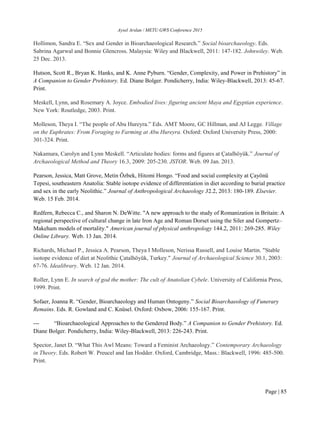


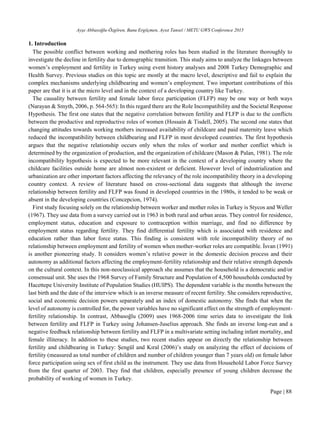
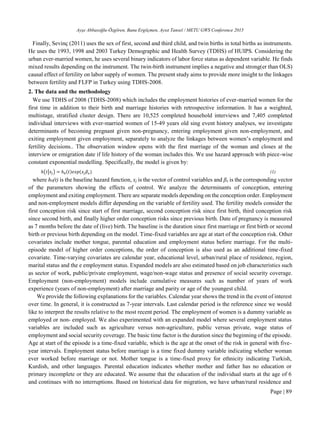




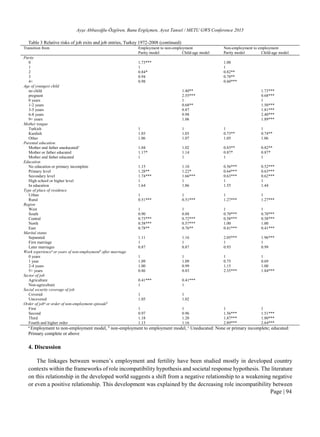

![Ayşe Abbasoğlu-Özgören, Banu Ergöçmen, Aysıt Tansel / METU GWS Conference 2015
Page | 96
Acknowledgements
This paper forms a part of the PhD thesis of Ayşe Abbasoğlu-Özgören prepared under the supervision of Banu
Ergöçmen and Aysıt Tansel. A major empirical part of the thesis was carried out during a research visit of Ms.
Abbasoğlu-Özgören at Stockholm University Demography Unit (SUDA) funded by the scholarship from
TUBITAK with 2214/A International Doctoral Research Fellowship. She is grateful to TUBITAK for the support,
SUDA for their hospitality and Gunnar Andersson for his technical supervision.
References
Abbasoğlu, A. (2009). Investigating the Causality between Female Labour Force Participation and Fertility in
Turkey (Unpublished master’s thesis). HUIPS, Ankara.
Concepcion, M. B. (1974). Female Labor Force Participation and Fertility. International Labor Review,
109(5/6), 503‐517.
Hossain, M., & Tisdell, C. (2005). Fertility and female labour force participation in Bangladesh: Causality and
cointegration. Asian-African Journal of Economics and Econometrics, 5(1), 67-82.
İsvan, N. A. (1991). Productive and Reproductive Decisions in Turkey: The Role of Domestic Bargaining.
Journal of Marriage and the Family, 53(4), 1057-1070.
Ma, L. (2013). Employment and motherhood entry in South Korea, 1978-2003. Population-E, 68(3): 419-446.
Mason, K. O., & Palan, V. T. (1981). Female Employment and Fertility in Peninsular Malaysia: The Maternal
Role Incompatibility Hypothesis Reconsidered. Demography, 18(4), 549-575.
Narayan, P. K., & Smyth, R. (2006). Female labour force participation, fertility and infant mortality in
Australia: Some empirical evidence from Granger causality tests. Applied Economics, 38(5), 563-572.
Özdemir, D., & Dündar, H. Ç. (2012). Türkiye’nin Kriz Sonrası Eve Dönen Kadınları: İşgücüne Katılımda Kriz
Etkisi ve Fırsat Maliyeti. TEPAV Değerlendirme Notu, Ağustos2012 N201240.
Sevinç, O. (2011). Effect of Fertility on Female Labor Supply in Turkey (Unpublished master’s thesis). Middle
East Technical University, Department of Economics, Ankara.
Stycos, J. M., & Weller, R. H. (1967). Female Working Roles and Fertility. Demography, 4(1), 210-217.
Şengül, S., & Kıral, G. (2006). Türkiye’de Kadının İşgücü Pazarına Katılım ve Doğurganlık Kararları [Female
Labor Force Participation and Fertility Decisions of Women in Turkey]. T.C. Atatürk Üniversitesi Journal of
Economics and Administrative Sciences, 20(1), 89-104.](https://image.slidesharecdn.com/59efbcce-7adc-4ccf-9a99-524cc539d6df-160605031959/85/My-published-research-110-320.jpg)
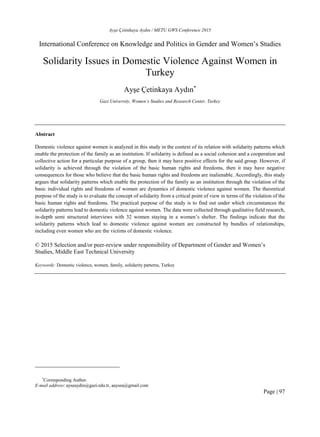
![Ayşe Çetinkaya Aydın / METU GWS Conference 2015
Page | 98
1. Introduction
Today in Turkey domestic violence against women has reached such a serious level that even those who
generally ignore the women’s human rights cannot disregard it. Almost daily cases of femicide are the most
concrete evidence of the current situation of domestic violence against women in Turkey. In parallel to the
increasing number of cases of domestic violence against women, efforts to combat and to eliminate it have
also increased, especially in recent years. New policies are established, new laws are implemented, lots of
conferences, workshops, congresses etc. are held, lots of researches are conducted, lots of books and articles
are written and published, at universities new programs on gender and women’s studies are opened and so
on. However remarkable results indicating that domestic violence against women is getting decrease have
not been reached yet. On the contrary unofficial statistics reveal that there is an increase in the number of
femicide cases, ultimate form of violence against women. For example according to We Will Stop Femicide
Platform’s statistics, last year, in 2014, 294 women were killed by their intimates. And in the first 8 month
of 2015, 182 women were killed (http://kadincinayetlerinidurduracagiz.net/veriler/2349/agustos-2015-
kadin-cinayeti-gercekleri). It is also known that most of the women were killed when they attempted to
make their own decisions about their own lives.
So, the present situation can be explained like this: On the one hand there is an increasing struggle to
combat and to eliminate domestic violence against women and on the other hand there is an increasing
number of cases of domestic violence against women. Then, it seems, there is a paradox here. How this
paradox can be explained in a rational manner? What are the gaps between the studies on domestic violence
against women and reality? How these gaps can be filled to find permanent and sustainable solutions for
elimination of domestic violence against women?
At this point, in order to find reasonable answers to these questions it might be useful to review the
results of the previous researches on violence against women from a different point of view. In this context,
some common results obtained from different researches on violence against women are summarized
below:
Men hold the power within the family as a reflection of patriarchal power relations in society. So,
force/violence used by men against family members is legitimate in the event that it is considered necessary
to do so (Rittersberger-Tılıç, 1998).
Honor of family legitimizes the violence against women. Accordingly, a woman’s “dishonorable
behaviors” are not accepted and are shamed and blamed even by other women. Therefore, violence against
women for their “dishonorable behaviors” is regarded as legitimate (Rittersberger-Tılıç, 1998; Başbakanlık
Aile Araştırma Kurumu [AAK], 1995).
Women victims of domestic violence generally try to keep their family together rather than move
away. In some events, women victims of violence believe that they are responsible for the violence they
suffer. Moreover they accept and internalized violence and learn to live with it (İçli, 1994; AAK 1995;
Rittersberger-Tılıç, 1998, Gülçür, 1999).
In accordance with traditional gender roles, family members and relatives of women victims of
violence persuade them to keep their family together (AAK 1995; Yıldırım, 1998; Gülçür, 1999;
Başbakanlık Kadının Statüsü Genel Müdürlüğü [KSGM], 2009).
In accordance with a traditional common belief, violence within the family should be kept secret
from outsiders (İçli, 1994; AAK, 1995; Rittersberger-Tılıç, 1998; Gülçür 1999).](https://image.slidesharecdn.com/59efbcce-7adc-4ccf-9a99-524cc539d6df-160605031959/85/My-published-research-112-320.jpg)
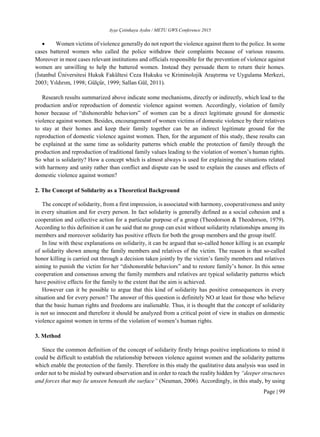
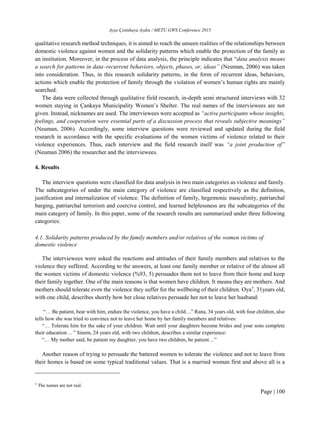
![Ayşe Çetinkaya Aydın / METU GWS Conference 2015
Page | 101
wife rather than an independent individual. So the right place of a married woman is her husband’s home.
And she must stay there even she is subjected to violence by her husband. Gönül, 28 years old, with one
child, tells how her relatives try to keep her family together:
“… Let’s save this family, there is a child, there is a home, let’s save it and, let’s give his wife back to him…” Ela,
23 years old, with two children, explains how her mother and aunt do not pay to attention the violence she suffered by
her husband and persuade her to keep her family together:
“… Firstly I told my aunt, and she said, it is not so important, we also are beaten, what is the problem. Do whatever
he wants. I said, no, I am not his slave. And my aunt said, you will be [his slave], he is your husband, if he beats you
even he kills you. Then I told my mother, and my mother said, it is not important, your father also beats me…” Meltem,
31 years old, with two children, has similar experience with her sisters and brothers:
“… My brothers and my sisters too, said, you went there [husband’s home] with your wedding dress and you will
return with your shroud, this suits us...”
The above explanations indicate that, convincing or forcing women victims of domestic violence by
their family members and/or relatives not to leave their husbands and keep their family together lead to
reproduction violence against women. However, the explanations also indicate that convincing or forcing
battered women not to leave their husbands and keep their family together strengthens the traditional family
values in the form of solidarity patterns which on the one hand enable the protection of the family but on
the other hand reproduce violence against women. Accordingly, repetitive expressions like “be patient”,
“endure the violence”,” tolerate him for the sake of your children”, “let’s save the family”, “you went
there with your wedding dress and you will return with your shroud”, “we are also beaten, what is the
problem” are solidarity patterns which enable the protection of family through the violation of women’s
human rights.
4.2. Solidarity patterns produced by the police responsible for prevention of violence against women
The interviewees were also asked the attitudes of the police when they call for help. According to the
answers 28 women out of 30 (%93) called the police for help at least once. The 20 women who called the
police said some of the police officers have an attitude that domestic violence against women is a part of
family relationships. Ece, 19 years old, with one child, explains her experience with the police:
“… I went to the police station. Most of the police officers there knew my husband. They asked me how I could
endure him. But there was an old one. He said, you are a married woman, you should endure him. Today’s women
leave their husbands for even just a slap…” Deniz, 34 years old, with two children explains the attitudes of the police
toward her:
“… One day the police came to our house for routine control. They asked me if I had any problem with my husband.
I said no. In that time my husband got better a little bit. One of the police officers said, what will you do if he does not
get better? Do you have any financial power? No. So you should endure him…” Burçin, 23 years old, with one child,
tells how the police officers tried to convince her to forgive her husband:
“… I didn’t go to the police station near our house. Because all the police officers there knew my husband and I
was afraid that they called him. I went to another police station. The police officers in that police station said me to
forgive my husband. They said, forgive your husband, you have a child… These kinds of events could occur in every
marriage… The police officers tried to convince me to forgive my husband a lot of times and I was tired to say them
no… I was so surprised and I thought whether if I relied on them or not… ” Çiğdem, 22 years old, has also similar
experience with the police:](https://image.slidesharecdn.com/59efbcce-7adc-4ccf-9a99-524cc539d6df-160605031959/85/My-published-research-115-320.jpg)
![Ayşe Çetinkaya Aydın / METU GWS Conference 2015
Page | 102
“… I went to police. They said, you are a family, you are young, and you can solve your problems yourselves,
return to your home… This is a small town and it would be better not to be heard your problems from the others…”
According to the law in force # 6284, Protection of Family and Prevention of Violence against Women,
the police as law enforcers, are authorized and are responsible for the prevention of violence against women.
However this research results indicate that in most cases the attitudes of the police toward the women
victims of domestic violence do not comply with the provisions of the law # 6284. Unfortunately the data
obtained from the field research cannot directly explain why the police don’t take the necessary measures
stated in the law in force to prevent the domestic violence against women. Nevertheless, within the
framework of the explanations of the women victims of violence, it can be said that the police generally
enforce the law in order to protect the family, as stated in the first part of the name of the Law # 6284 rather
than to take measures, which are clearly mentioned in the provisions of the law, to eliminate domestic
violence against women.
Thus, in case the Law in question is enforced by the police to encourage the women victims of domestic
violence to return to their homes where they suffer violence and to keep their family together, traditional
family values which lead to violence against women are reproduced by solidarity patterns. Accordingly,
repetitive expressions such as “today’s women leave their husbands for even just a slap”, “you should
endure him”, “forgive your husband, you have a child”, “these kinds of events could occur in every
marriage”, “return to your home”, “it would be better not to be heard your problems from the others” can
be accepted as solidarity patterns which enable the protection of family through the violation of women’s
human rights.
4.3. Solidarity patterns produced by the women victims of domestic violence
The interviewees were asked if they think that they somehow deserve the violence to which they have
been subjected. The answers are classified and evaluated in two groups:
1) According to the answers 18 women out of 31 (%58) at least sometimes think that they deserve the
violence. Bade, 37 years old, with one child, explains how she tried to find fault with herself as an excuse
for husband’s violence:
“… At first I always asked myself if I was guilty. Did he use violence against me because of my fault? I asked
myself if I deserved it…” Rana, 34 years old, with four children, tells how she forced herself to find an excuse for her
husband’s violence:
“… At first I thought that I was guilty, because I loved him. I thought maybe he was angry about something. His
financial situation was not good, so maybe he was worried about it. Maybe I was guilty, maybe I made him angry …”
Gamze, 31 years old, with two children, explains how she legitimizes her husband’s violence in an event that she thinks
she is guilty:
“… I keep my silence if I know that I am guilty. I say, OK! I am guilty in this event. I say, I deserve it [violence].
And I keep my silence…” Banu, 28 years old, with two children, tells how she justifies her husband’s violence in
certain cases:
“… He didn’t like my parents. He didn’t allow me to call my mother. Therefore I usually called my mother without
notice to him. One day when I was talking with my mother, he saw me and he beat me. I thought I deserved it. Because
although he didn’t want me to call my mother, I called her without notice to him …”
Just like other research results on violence against women, the results of this study also show that in
certain cases violence against women is somehow justified even by the women victims of domestic](https://image.slidesharecdn.com/59efbcce-7adc-4ccf-9a99-524cc539d6df-160605031959/85/My-published-research-116-320.jpg)
![Ayşe Çetinkaya Aydın / METU GWS Conference 2015
Page | 103
violence. And this justification provides a basis for production and reproduction of violence against women.
It is also well known that there are some social, cultural and economic reasons such as traditional family
values, concern for children, financial dependence, behind the justification of violence by the battered
women. However, whatever the reasons behind the justification of domestic violence against women the
repetitive expressions such as “I thought I deserved it [violence], “I keep my silence” “maybe I was guilty”,
“maybe I made him angry” enable at the same time the protection of family by fostering traditional family
values in the form of solidarity patterns which ultimately lead to violence against women.
2) According to the answers, 13 women out of 31 (% 42) never think that they deserve the violence.
However there are some contradictions in their explanations. For example the explanations of 10 women
who said they never find themselves guilty for the violence they suffer give also an impression that in some
cases women may deserve the violence. For example Ezgi, 44 years old, with four children, explains why
she did not find herself guilty for the violence she was subjected:
“… I never justified his violence. We [Ezgi and her co-wife] were perfect. At home we made everything perfectly.
But we were nothing to him…” Gonca, 28 years old, with three children, also tells why she didn’t think that she
deserved the violence:
“… I never found myself guilty. I never thought like that. Because I did everything properly…”
Accordingly, although the women, who never find themselves guilty for the violence they suffer, carry
out all their responsibilities in accordance with the requirements of the traditional gender roles, they suffer
from violence. And they find it unacceptable rather than the violence against women in general. Hence, it
is thought that the explanations of the women who say they never think that they deserve the violence are
not completely different from the explanations of those who sometimes think that they deserve it. Thus, it
can be argued that the expressions such as “I never justified violence, because at home we made everything
perfectly”, “I never find myself guilty, because I did everything properly” enable the protection of the
family as an institution by fostering the traditional family values which lead to domestic violence against
women.
In fact the answers given to another question related to the justification of domestic violence against
women verify the above evaluation on the attitudes of the interviewees toward the domestic violence against
women. The interviewees were also asked their opinions about the women who behave “dishonorably”
toward their husbands and their families. 8 women out of 24 (%32) stated, for example, if a woman cheats
on her husband, this is an unacceptable, “dishonorable” behavior and she deserves the violence in anyway.
That is, she should be beaten at least. Gönül, 28 years old, with one child, explains in which cases domestic
violence against women is justified:
“… I am angry with that woman. If her husband doesn’t beat her, she doesn’t have any right to behave like this. I
think she should be beaten, she should be beaten. There are a lot of women who cannot find a warm home…” Duygu,
26 years old, with two children, also agrees with Gönül:
“… She deserves the violence. Why she cheats on her husband? If I were her husband I would have been beaten
her. If I were her husband I would have kicked seven bells out of her. If I were her husband I would have kicked her to
the curb. Why she cheats on her husband? She deserves the violence. She should be punished any way…” Pınar, 24
years old, with three children, explains why a woman who cheats on her husband deserves the violence:
“… She deserves the violence. I explain the reason. If she cheats on her husband although he is nice to her, although
he doesn’t beat her, although he is a perfect husband, she deserves the violence. As a woman I can say that she deserves
the violence. This is my opinion. I know that beating is not good. But in that case she deserves the violence. I think like
this, it is not necessary to lie…”](https://image.slidesharecdn.com/59efbcce-7adc-4ccf-9a99-524cc539d6df-160605031959/85/My-published-research-117-320.jpg)

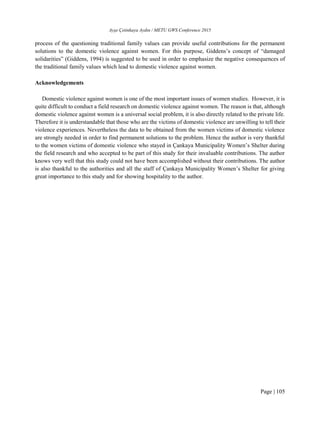
![Ayşe Çetinkaya Aydın / METU GWS Conference 2015
Page | 106
References
Başbakanlık Aile Araştırma Kurumu. (1995). Aile İçi Şiddetin Sebep ve Sonuçları [Elektronik Sürüm].
Ankara: Bizim Büro Basım Evi.
Başbakanlık Kadının Statüsü Genel Müdürlüğü. (2009). Türkiye’de Kadına Yönelik Aile İçi Şiddet
[Elektronik Sürüm]. Ankara: Elma Teknik Basım Matbaacılık.
Crow, G. (2002). Social Solidarities. Theories, Identities and Social Change. Buckingham: Open
University Press.
Giddens, A. (1994). Beyond Left And Right. California: Stanford University Press.
Gülçür, L. (1999). A study on domestic violence and sexual abuse in Ankara, Turkey. Women for
Women’s Human Rights Reports No.4.
İçli, T. (1994). Aile İçi Şiddet: Ankara-İstanbul ve İzmir Örneği [Elektronik Sürüm]. Hacettepe
Üniversitesi Edebiyat Fakültesi Dergisi, 11 (1-2), 7-20.
İstanbul Üniversitesi Hukuk Fakültesi Ceza Hukuku ve Kriminolojik Araştırma ve Uygulama Merkezi.
(2003). Suçla Mücadele Bağlamında Türkiye’de Aile İçi Şiddet. Ülke Çağında Kriminolojik ve
Viktimolojik Alan Araştırması ve Değerlendirme. İstanbul: Beta Basım.
Kadın Cinayetlerini Durduracağız Platformu. (t.y.). Erişim: 27 Eylül 2015, Kadın Cinayetlerini
Durduracağız Platformu Ağ Sitesi, (http://kadincinayetlerinidurduracagiz.net/veriler/2349/agustos-2015-
kadin-cinayeti-gercekleri)
Neuman, W. L. (2006). Social Research Methods. Qualitative and Quantitative Approaches. (6th
ed.).Boston. Pearson Education.
Rittersberger-Tılıç, H. (1998). Aile İçi Şiddet: Bir Sosyolojik Yaklaşım. O. Çiftçi (Ed.). 20. Yüzyılın
Sonunda Kadınlar ve Gelecek Konferansı (s. 119-129). Ankara: Orta Doğu Amme İdaresi Yayınları.
Sallan Gül, S. (2011). Türkiye’de Kadın Sığınmaevleri. Erkek Şiddetinden Uzak Yaşama Açılan Kapılar
mı? İstanbul: Bağlam Yayıncılık.
Theodorson, G. A. ve Theodorson A. G. (1979). A Modern Dictionary of Sociology. New York,
Hagerstown,
San Francisco, London: Barnes & Noble Books.
Yıldırım, A. (1998). Sıradan Şiddet. İstanbul: Boyut Yayın Grubu](https://image.slidesharecdn.com/59efbcce-7adc-4ccf-9a99-524cc539d6df-160605031959/85/My-published-research-120-320.jpg)
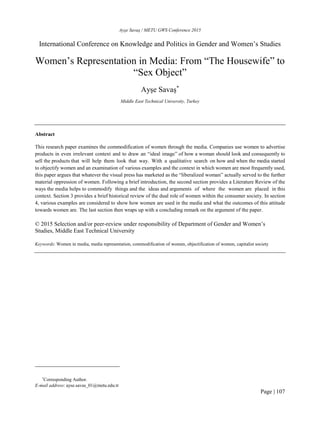
![Ayşe Savaş / METU GWS Conference 2015
Page | 108
1. Introduction
Through our daily lives, we are constantly bombarded with images from the media. The newspapers,
the television, the internet. There is no running away from it and actually, this is what those who prepare
the advertisements pride themselves on – they can put those images anywhere, even onto our coffee cups
or right into that video we watch online. It is also not possible to miss the pattern in which women are
usually shown in these images: mostly the focus is on their bodies, with the message being their
appearance is the most important aspect of them, and other times they are mostly shown as one-dimensional
characters even on movies. They are generally regarded as something less than they are and with this
recurring attitude the media has long helped the objectification and commodification of women.
Gallagher suggests that it wasn’tuntil the 1990s, when media coverage could no longer be dismissed in
most of the world, that the issues concerning women in media stopped being regarded as of secondary
importance to “cardinal problems such as poverty, health and education” (2002:2). On the other hand, van
Zoonen states that “[the] media have always been at the centre of feminist critique” and points out that as
early as 1963, Betty Friedan in The Feminine Mystique, was criticizing the media for its contribution to
the “myth that women could find true fulfilment in being only a housewife and a mother” (1994:11).
According to van Zoonen since “women’smovement is not only engaged in a material struggle about equal
rights and opportunities for women, but also in a symbolic conflict about definitions of femininity”, the
way women were represented in the media have always been an important battleground for the feminists.
She states that by the early 1970s a considerable collection of feminist action and thought about the
media was accumulated. One can only assume that works concerning the issues of women have become
more frequent after that since McClelland (1993:220) marks the start point of the concern for the patterns
for sexist visual imagery as the 1970s, following the rapid social change of the 1960s.
Concerns over the representation of women in the media have been on the quantitative –Gallagher uses
data on the underrepresentation of women- and also regarded the content analysis –the stereotypes and
socialization, pornography and ideology as van Zoonen groups the feminist themes in communication
studies. More and more frequently, though, the focus has been on the gender portrayal in the media and
how this may affect the way women perceive themselves as well as showing how the society sees them.
As van Zoonen notes, Tuchman, –whose work in the late 1970s is among the first to produce research
on this topic with a well-developed theoretical framework- comments on the fact that the media has failed
to represent the increasing numbers of women in the labour force and “also it symbolically denigrates
[women] by portraying them as incompetent, inferior and always subservient to men” (1994:16).
Kilbourne states in the third instalment of her Killing Us Softly video series (2000) that as the foundation
of the mass media, advertisements aim to sell products and they do; however, they also sell values, images
and “concepts of love and sexuality, of romance, of success... and perhaps most important of normalcy. To
a great extent advertising tells us who we are and who we should be.” As Kilbourne focuses, media does
so especially in regards to its visualization of women.
In this paper, it is my purpose to show the ways in which the mass media objectifies women, the
consequences of this behaviour on women and also the consequences on the way society regards women
and to see when this started. It is argued that the “liberalized women” actually served to the further the
material oppression of women within the capitalist system.](https://image.slidesharecdn.com/59efbcce-7adc-4ccf-9a99-524cc539d6df-160605031959/85/My-published-research-122-320.jpg)
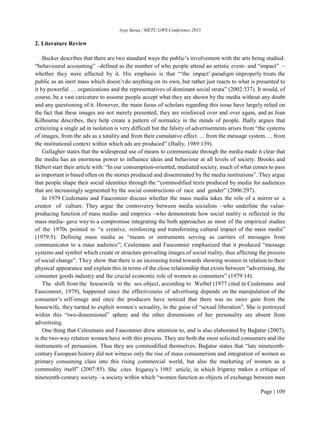
![Ayşe Savaş / METU GWS Conference 2015
Page | 110
for the purposes of sex and reproduction”- explaining that “[the women’s] status and subjectivity are
defined through their relationship with men”, in support of her point. Bağatur stands on the belief that
women were the primary group to be thought of as consumers –whereas men were the producers- and she
states that through “spectacularization” women were also commodified: “[W]hile women were invited to
consume more, specific guidance of this consumption towards articles related to women’s appearance made
women themselves commodities.” (2007:87).
In 1993 Steeves lists the “representations of women in global, mainstream media” as one of the Five
Global Gender Issues and also shares the belief that mass media is not a mere representative of the society
but it reinforces, not just creates, patriarchal ideologies around the world. It should, however, be noted that
Steeves’ list is questionable in the sense that it seemingly focus more on the problems of women who live
in the “developed” countries of the world. Mohanty describes this as “the typically authorizing signature
of such Western feminist writings on women in the third world” (1988:352) and is very vary of this
authorization as she draws a parallel with the “humanism as a Western ideological and political project.”
McClelland states that women and minorities are being portrayed in stereotypical roles and in
distorted or sexist images within the mass media and also believes that the visual images are powerful
means of communication which convey “intended or unintended messages” and can carry “cultural
symbolism” (1993:221). He lists the consequences of the women’s portrayal in mass media as;
objectification, seduction, self-gratification, stereotyping and underrepresentation.
Overall, it is safe to say that most scholars who write about the issues of women’s relationship to media
believe that, despite being an appropriate means to examine the production-consumption relations and
perceptions of self-image in the society, the mass media more than just reflects the social structure; it also
affects it and alters it. The two most concerning topics discussed by the literature are the lack of
representation of women in the media and how they are represented when they are.
3. A Brief Historical Review on Women’s Dual Role within the Consumer Society
“The adage ‘Consumption, thy name is women’ resonates with such venerable authority that one might
expect to find it cited in Barlett’s Familiar Quotations, attributed to some Victoria savant or to an eminent
critic of modern frippery,” are the opening words of The Sex of Things (1996). The emphasis of the book
is on the fact that despite its naturalization as an inevitable part of the women’spsychology, the “excessive
desire to consume as a peculiarly feminine quality” (Jones, 1996:27) is a historical phenomenon which
has its roots in the long transition from the aristocratic to bourgeois society (1996:1).
Of interest to note is that with the technological advances and the “industrial revolution”, it was seen as
the “men” were conquering nature. The nature had been thought of as “female” for centuries and in
accordance with this, as Jones states, women were associated with the characteristics of inconsistency,
treachery and change. The advent of liberal politics and public space, which distinguished needs as
“irrational, superfluous, or so impassioned that they overloaded the political system” and “those that were
rationally articulated and cast in terms appropriate to being represented and acted through normal
political process” (1996:15), was one of the structural changes that reinforced the propensity to feminize
the realm of consumption. In line with the view of women being inconsistent, the first set of needs defined
were identified with women.
The division of labour of the capitalist system which constructed the household with the male
breadwinner, defining his labour as the wage labour, further reinforced the differences between the
household and the market place, the female provisioners and male workers, the consumers and the producers
(1996:15). With Say’s famous theory of supply creating its own demand taken basis, the production](https://image.slidesharecdn.com/59efbcce-7adc-4ccf-9a99-524cc539d6df-160605031959/85/My-published-research-124-320.jpg)

![Ayşe Savaş / METU GWS Conference 2015
Page | 112
could “well be described as an emblematic figure for that Paris being constructed through capitalism as the
capital of desire” (1992:142).
The image of women as housewives, which ruled as the dominating image of women in the media
until the late twentieth century, reinforcing the household structure has been present since at least the
nineteenth century, too. Loeb paints a picture of how women were represented as housewives of the
Victorian England advertisements. According to Burdon’s review on her book, Loeb argues “as
consumers of the merchandise and the media that represented it, women played a major role in the
nineteenth-century commercial revolution documented by [the descriptive catalog of Victorian and
Edwardian advertisements]” (1997:348). Burton notes that the advertisements were widely based on the
gendered stereotype of the idea that the home was the woman’s domain and hence the “Victorian notions
of the ‘respectable feminine’” were pivotal to the process of the products of the commercial capitalism
being naturalized and the icons of mass production being domesticated. Burton points out that Loeb has not
concerned herself with explaining whether women were affected by these advertisements but counts that
images of consumer-as-mother was also played upon by the advertisers and tells us that it was realized that
“sexy women would sell” (Loeb, 1994:57 cited in Burton, 1997:349).
Even though the spread of images through technological advancement has definitely accelerated these
processes and the needs of the market along with women’s position in the society altered the domineering
portrayal, one thing we can draw from this review is that neither women’s role as consumers nor the
female body’s commodification were natural. They were historical processes which came to be within
capitalist society.
4. Women’s Representation in Media
The headline of the Turkish newspaper Referans for 17-18th
of April 2010 read: “Not much changed in
the advertisement strategies during the past fifty years! Sexist advertisements are dead, sexy woman is on
the shop window”. Özçelik states in the article that even though the sexist advertisements of the 1950s
which showed women as the housewives who are only born to please their husbands no longer exist, the
one thing that remains is the commodification of women. While women reshaped their existence within
the social, political, artistic and work lives, the advertisers realized that telling women to buy one product,
or else their husband would leave them, did not work anymore. As a result, advertisements moved towards
“disguised sexist” ones or ones within which women were outright used as sexual objects. The new way
to sell was to tell women that with the right cosmetic products they could look like Hollywood stars and
with the help of photoshop, unattainable goals were worked into women’s subconscious.
According to Bağatur’s analysis on the Turkish print media’s representation of women from 1930 to
1970, women in this period were not as sexualized as they are today. Rather the focus was on their role
as the housewife or their facial beauty and how they needed to keep it to hold onto their husband or to
find one. Advertisers were in a dilemma, Bağatur explains, on regards the representation of women in
advertising since the newly forming republic expected her to take upon her shoulders by simultaneously
being modern and traditional: “While they were invited to beautify themselves in accordance with the
Western norms with new cosmetics and fashion products, they were also continuously associated with
traditional roles of housewife and mother.” (Bağatur, 2007:110).
She presents advertisements of product such as butter, pasta and cleaning items showing how they
played on the stereotype of women being responsible for cooking and cleaning for the family. Where
woman is the natural bearer of the tasks such as cooking and serving for the family, it is usually the
daughter who helps her, while the man is either the husband who comes home happy to see a meal served](https://image.slidesharecdn.com/59efbcce-7adc-4ccf-9a99-524cc539d6df-160605031959/85/My-published-research-126-320.jpg)
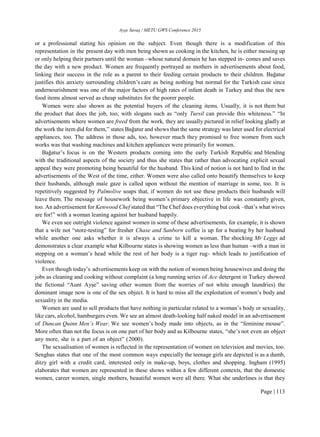

![Ayşe Savaş / METU GWS Conference 2015
Page | 115
media’s portrayal and they do feel pressured to measure up to this ideal image, how else could have
the diet, the cosmetics, the cosmetic surgery could make millions of dollars each year?
To conclude, it should be noted that women’s oppression continues with force within our society. The
fact that this has reached such early ages is quite threatening. Even if their representation in the media is
not the primary concern of women in the entire world, considering its effects and the fact that it reinforces
the way that women are thought of, it is high time that precautions be taken on the issue.
Acknowledgements
I would like to thank Assoc. Prof. Sheila Margaret Pelizzon for her guidance and continued support.
As always, to my family.
References
Bağatur, Sine (2007). “Engendering Consumption: Commodification of Women through Print Media
with Specific Reference to the Turkish Case”. Unpublished Master Thesis, Middle East Technical
University
Becker, Anne E. and Hamburg, Paul (1996). “Culture, the Media, and Eating Disorders”, Harvard
Review of Psychiatry, 4:3, pp 163-167
Becker, Howard S (2002). “Studying the New Media”, Qualitative Sociology, Vol. 25, No. 3; 337-343
Brooks, D. E. and Hébert, L. P. (2006). “Gender, Race and Media Representation”, in The SAGE
Handbook of Gender and Communication, B. Dow and J. Woods (eds.), Thousand Oaks, CA: Sage
Publications, Inc, pp 297-319
Burton, Antoinette (1997). “Reviewed work(s): Consuming Angels: Advertising and Victorian Woman by
Lori Anne Loeb”, The Journal of Modern History, Vol. 69, No. 2, pp 348-350
Ceulemans, Mieke and Fauconnier, Guido (1979). Mass Media: The Image Role and Social
Conditions of Women. Paris: UNESCO; [New York: distributed by Unipub]
De Grazia Victoria and Ellen Furlough (eds.). The Sex of Things: Gender and Consumption in Historical
Perspective, Berkeley, L.A. and London: University of California Press, 1996
Gallagher, Margaret (2002). “Women, Media and Democratic Society: In Pursuit of Rights and
Freedoms”, EGM
Ingham, Helen (1995). “The Portrayal of Women on Television”. Retrieved from:
http://www.aber.ac.uk/media/Students/hzi9401.html
Irigaray, Luce (1985). “Women on the Market” in This Sex Which is Not Mine, Ithaca: Cornell
University Press, pp 170-191](https://image.slidesharecdn.com/59efbcce-7adc-4ccf-9a99-524cc539d6df-160605031959/85/My-published-research-129-320.jpg)
![Ayşe Savaş / METU GWS Conference 2015
Page | 116
Jhally, Sut (1989). “Advertising, Gender and Sex: What‟s Wrong with a Little Objectification?” in
Working Papers and Proceedings of the Center for Psychosocial Studies (edited by Richard Parmentier
and Greg Urban) No. 29. Retrieved from: http://www.sutjhally.com/articles/whatswrongwithalit/
Kilbourne, Jean (2000). Killing Us Softly 3: Advertising’s Image of Women.
MacDonald, Myra (1995). Representing Women: Myths of Femininity in the Popular Media. London:
HodderArnold
McClelland, John (1993). “Visual Images and Re-Imaging: A Review of Research in Mass
Communication” in Women in Mass Communication, ed. Pamela J. Creedon, Newbury Park, CA: Sage
Mohanty, Chandra Talpade (1988). “Under Western Eyes: Feminist Scholarship and Colonial
Discourses”, Feminist Review, No. 30, 61-88
Ono, Kent A. and Buescher, Derek T. (2001). “Deciphering Pocahontas: Unpacking the
Commodification of a Native American Woman”, Critical Studies in Media Communication, 18, 23-43
Özçelik, Sıla. "Seksist Reklamlar Öldü, Seksi Kadın Vitrinde” Refereans [İstanbul] 17-18 April
2010: 11
Peach, Lucinda Joy (ed.) (1998). Women in Culture: A Women’s Studies Anthology, Massachusetts and
Oxford: Blackwell Publishers
Roberts, Mary Louise (1998). “Gender, Consumption, and Commodity Culture”, The American
Historical Review, Vol. 103, No. 3, 817-844
Senghas, Sarah (2006). “Slender, Sexy Women Portrayed in Movies, TV, Magazines and
Advertisements” Retrieved from:
http://www.associatedcontent.com/article/32112/sexist_stereotypes_in_the_media.html?cat=9
Steeves, Leslie (1993). “Gender and Mass Communication in a Global Context” in Women in Mass
Communication, Creedon, Pamela J (ed.), Sage Publications, Second Edition, pp 32-60
Van Zoonen, Liesbet (1994). Feminist Media Studies. London; Thousand Oaks, CA: Sage](https://image.slidesharecdn.com/59efbcce-7adc-4ccf-9a99-524cc539d6df-160605031959/85/My-published-research-130-320.jpg)


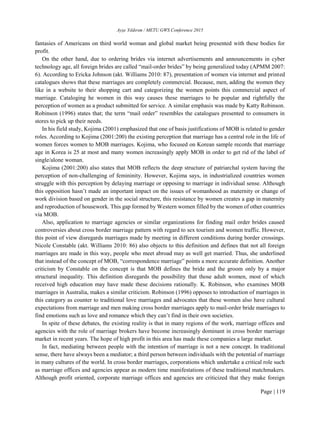

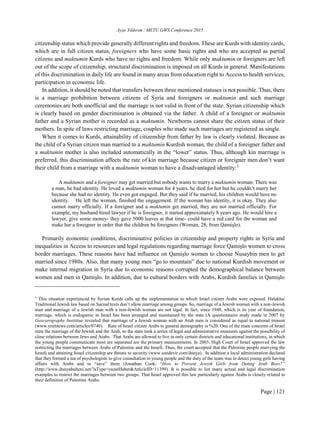







![Ayşegül Gökalp Kutlu / METU GWS Conference 2015
Page | 129
especially in the Eastern and South Eastern parts of Turkey and among families within the lower socio-
economic classes. It was not until the 1980s that Turkish women would indulge in a new wave of feminism
and address their own problems such as domestic violence, harassment, honour killings, virginity
examinations, family-oriented gender rules and the patriarchal hegemony.
One of the key achievements of the feminist movement in Turkey was the Domestic Violence Act
(1998). The Act introduced legal sanctions for not only abusive and violent husbands but for the male
members of the family. It also made it possible for the prosecutors to issue protection orders, providing
shelters for the victims, perpetrators to be kept away from the family home for a specific time period,
confiscation of his arms, and payment of alimony, and in case of noncompliance with the court order,
imprisonment for up to six months (Aslan-Akman&Tütüncü, 2013: 93).
In addition to the strengthening feminist movement, the EU candidacy also contributed to policy reform
in gender equality. The EU’s conditionality, together with Turkey’s feminist movement, resulted in
important amendments in the Constitution, and adoption of the new Civil, Penal Codes and the Labour Act,
establishment of the Women-Men Equal Opportunities Commission, approval of the Istanbul Convention
and adoption of the new Law on the Protection of the Family, and approval of the optional protocol of the
CEDAW which led the way for direct application to the CEDAW Committee for women who are exposed
to discrimination.
With the constitutional amendments in 2001 and 2004, some gender equality provisions were introduced.
In 2001, the clause “The family is the foundation of the Turkish society and based on the equality between
the spouses” was added. In 2004, the statement “[...] Men and women have equal rights. The State shall
have the obligation to ensure that this equality exists in practice”, was introduced and in 2010, “Measures
taken for this purpose should not be regarded against the principle of equality” was added after this
sentence. The famous clause on superiority of international law was also included in 2004 amendments,
stating that the provisions of international agreements that Turkey is a signatory (such as CEDAW or the
Istanbul Convention) will bear the force of law, and in case of a conflict between domestic law and a
provision of an international treaty that Turkey is a signatory, Turkey has to follow the provisions of the
international agreement.
The new Civil Code was adopted in 2001. It established the legal marriage age as seventeen for both
men and women and contended that no one can be forced to marry. It also abolished the concept of men
being the “head of family”, granted women the right to use their own last names along with their husbands’
(in 2015, the Constitutional Court ruled that women can continue using their own last names without the
husband’s surname), established that spouses need not obtain each other’s permission to work, and granted
equal rights to spouses with regards to selection of the residence, matters concerning children, and
distribution of property in case of divorce. It is worth mentioning that while Civil Code was negotiated in
the Turkish Parliament, there was serious opposition to these clauses, particularly from the nationalist-
Islamist male parliamentarians.
With the New Penal Code which took effect in 2005, sexual crimes were considered crimes against
individuals and their penalty was aggravated; the woman/girl distinction was abolished; with regards to
sexual abuse, those under the age of fifteen were considered children; marital rape was recognized; rape for
the purpose of marriage was considered a crime; polygamy was forbidden; criminal sanctions were brought
against those who practices religious marriage ceremony without an official marriage first (which is
severely undermined by the Constitutional Court ruling in 2015 which legalized religious marriages without
obtaining a civil marriage); the practice of cancelling the penalty in case the abductee and the abductor gets
married was abolished; aggravated life imprisonment was brought for honour killings.](https://image.slidesharecdn.com/59efbcce-7adc-4ccf-9a99-524cc539d6df-160605031959/85/My-published-research-143-320.jpg)
![Ayşegül Gökalp Kutlu / METU GWS Conference 2015
Page | 130
Under the Labour Law which entered into force in 2003, no discrimination based on sex or similar
reasons is permissible in the employment relationship; the principle of equal pay for equal jobs has been
adopted; it was also established that female employees cannot be dismissed due to pregnancy or birth and
nursing leaves. Maternity leave was increased to sixteen weeks, which is the standard in EU. Thus, new
arrangements were introduced to prevent the violation of women’s rights which are prevalent in the working
life, and to increase women’s participation in the workforce.
3. Analysing the AKP’s discourse on gender
As Yeğenoğlu and Coşar (2012) point out, AKP’s three terms in government (2002-2007; 207-2011;
2011-2015) witnessed increasing conservation in domestic politics, which is mainly reflected on the gender
policies. As the hopes for EU membership started to fade away during its second term, the AKP’s rhetoric
on social and cultural domains started to be dominated by a religious and conservative discourse. This is a
period in which the concepts and phrases such as “family”, “motherhood”, “anti-feminism”, “abortion is
murder”, “at least 3 children” and “gender justice” dominated AKP’s discourse on women. This discourse
is in line with the neoconservative perspective, which sees the state as having an interventionist role in the
functioning of the society, and “identifies the state, including law, with the task of setting the moral-
religious compass for society, and indeed for the world” (Brown, 2006: 697, cited in Acar and Altunok,
2013: 15). Gender-based problems are intertwined, and although it is hard to disentangle one from the other,
this section will analyse AKP’s discourse on women under three headings: discrimination against women,
domestic violence, and family and reproduction.
3.1. AKP’s discourse on discrimination against women
One of the key demands of the feminist movement in Turkey since the 1990s was the establishment of
a commission on gender equality, and its establishment was proposed in 1998. The 2003 Progress Report
of the European Commission was pointing out to the cases of discrimination in Turkey, and the necessity
of a commission as such was recommended by the UN CEDAW committee in 2005. The establishment of
a commission was realized in 2009, albeit the commission’s name was adopted not as the “equality”
commission, rather, “Women-Men Equal Opportunities Commission”, emphasizing not the equality
between men and women, but the equality of opportunity. Similarly, the office of the State Minister
Responsible for Women and Family was abolished in 2012, and replaced by the Ministry of Family and
Social Policy. In his statement, the then-Prime Minister Erdoğan, claimed that AKP was a conservative-
democratic party, and family was important to them.
On November 24th, 2014, at the International Women and Justice Summit organised by Kadın ve
Demokrasi Derneği (KADEM), Erdoğan, as the President of Turkey, said “You cannot bring women and
men into an equal position; this is against nature. You cannot subject a pregnant woman to the same working
conditions as a man. You cannot make a mother who has to breastfeed her child equal to a man. You cannot
make women do everything men do like the communist regimes did… This is against her delicate nature.”
He went on saying that "They [feminists] talk about equality between men and women. The correct thing
is equality among women and equality among men. But what is particularly essential is women's equality
before the justice. What women need is to be equivalent, rather than equal; that is, justice." He added that
Islam dignifies women as mothers but feminists do not accept the concept of motherhood; but those who
understand are enough, (referring to a blurred “we”) “we’ll continue down this path with them” (Today’s
Zaman, 24.11.2014).. This statement was not news to the public opinion, though. In 2010, when he was](https://image.slidesharecdn.com/59efbcce-7adc-4ccf-9a99-524cc539d6df-160605031959/85/My-published-research-144-320.jpg)

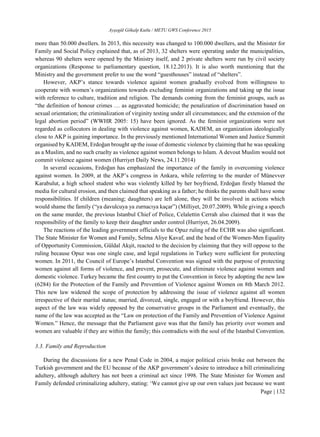
![Ayşegül Gökalp Kutlu / METU GWS Conference 2015
Page | 133
to join the EU. […] We have to respect the values of Turkish society” (Zaman, 28 August 2004). The then-
Prime Minister Recep Tayyip Erdoğan, announced the withdrawal of the proposal after a meeting with EU
enlargement commissioner in Brussels, however, he later expressed his anger over the situation. Referring
to the women’s groups that were protesting the proposal, and their slogan ‘our bodies and sexuality belong
to ourselves,’ he said: ‘There were even those who marched to Ankara, carrying placards that do not suit
the Turkish woman. I cannot applaud behaviour that does not suit our moral values and traditions. […] A
marginal group cannot represent the Turkish woman.’(İlkkaracan, 2008: 41-42).
Woman, in Erdoğan’s discourse, is not an activist but a mother. Both as the Prime Minister and later as
the President, Erdoğan has mentioned the sanctity of motherhood in several occasions. In the Third
Congress on Women in Local Government in 2007, he stated that there is no status comparable to
motherhood, and that is the reason why “our civilization has placed the heaven under the feet of the mothers,
and not those of the fathers”, referring to the well-known hadith (Çitak&Tür, 2008: 464). In his message
for the Mother’s Day in 2008, Erdoğan emphasized that mothers, who are responsible for the upbringing
of the children with love and tender and healthy both mentally and physically, are the pillars of the family
and social life. He went on saying that social responsibilities of mothers are not biological only, but mothers
are also the shapers of our future as a nation and carriers of our traditions and customs (IHA, 11.05.2008).
In 2014, he said "Our religion (Islam) has defined a position for women (in society): motherhood” (Today’s
Zaman, 24.11.2014). The Minister of Health had joined the ‘womanhood equals motherhood’ assertions by
claiming that “mothers should not put another career other than motherhood at the centre of their lives.
They should put raising good generations at the centre of their attention” (Hurriyet Daily News,
02.01.2015).
Erdoğan not only praises motherhood, but on several occasions, he condemned abortion. He called
abortion as ‘murder’ and said the practice should be outlawed. “It makes no difference whether you kill a
baby when it is still in its mother's womb, or after it is born,” he said. He also attacked caesarean section
deliveries, which, he claimed, limited population growth because women are advised not to have more than
two children with this method (BBC, 01.06.2012).
The emphasis on motherhood was put into practice on January 8, 2015, when Prime Minister Ahmet
Davutoğlu announced the “Action Plan for Protecting Family and Dynamic Population Program”. In line
with President Erdoğan’s long-term policy of encouraging at least three children per family, the government
is promising 300 Turkish Liras for a couple's first child, 400 liras for the second, and 600 liras for the third.
Davutoğlu explained the incentives for women by saying that “Mothers [working in public office] will be
able to continue to be promoted in their positions even in their unpaid leave after birth. We will also make
arrangements for part-time work for mothers. After the end of maternity leave, mothers with one child will
have the right to work part-time for two months, mothers with two children for four months, and mothers
with three or more children for six months. They will receive full wages while working part-time.” He
added that the “protection of our family life under any circumstance is of great importance for the protection
of future generations, fundamental norms, our values and moral standards,” and the government’s program
aimed to bring about new measures to help working mothers. He went on saying that motherhood and
continuing a professional career are not categorically opposite things, and mothers who want to continue to
take care of their children until primary school will have the right to work up to 30 hours a week so that
they do not become detached from their professional life. The government also expanded parental leave to
five days so that fathers can support their wives after birth (Hurriyet Daily News, 08.01.2015). Although
these are facts that women's organizations have been voicing for years, the logic behind the new plan is not
compatible with ideas of gender equality and empowerment of women. Instead, it emphasizes that women](https://image.slidesharecdn.com/59efbcce-7adc-4ccf-9a99-524cc539d6df-160605031959/85/My-published-research-147-320.jpg)

![Ayşegül Gökalp Kutlu / METU GWS Conference 2015
Page | 135
international law. Rather, the previously mentioned statements indicate that the method of combatting
violence is religion, by claiming that faithful men do not beat their views and women are sacred because
they are mothers. Therefore, in AKP’s discourse, violence against women is a private issue, not a societal
one, that will be eroded with being more faithful and respecting women who bear children.
Private life is not that private, too. Although the AKP governments are neoliberal in the sense that they
respect individual rights and freedoms, the reproductive rights of women obviously do not fall under this
scope. Although respect for private and family life is a fundamental human right, the AKP governments do
not hesitate to tell families the number of children they shall have, to interfere with women’s bodies on
whether to give birth or not, and the choice of birth-giving methods. In addition, sexual intercourse is only
possible if it is within the family (as discussions on criminalization of adultery indicate). In 2013, the Prime
Minister Erdoğan said that it is against his post and values that male and female university students stay
together at mixed-gender dormitories or student houses, because many things could happen in those houses.
He said that no one shall interpret this as an intervention to private life and added that “we [AKP] are a
conservative democratic party” (Milliyet, 05.11.2013).
In addition to reflecting the conservative point of view of the government, a more important indication
of this neoconservative-neoliberal mentality is that, violence against women is regarded only as physical
violence. Sexual, psychological or economic violence is not pointed out. Indeed, the latest plan of the
government, by encouraging women towards flexible work may lead the way to gradual retreat of women
from the labour force, hence, exposing women to economic violence. In a patriarchal society such as
Turkey, where honour crimes and child marriages are significantly high, the pressure on women to give
birth in increasing numbers might result in sexual and psychological violence.
Although the author of this article acknowledges that women’s unequal participation in the workforce
and in politics would amount to violence and result in increasing levels of violence against women, due to
its narrow scope, this article has left out examples of discrimination in economic life and politics. However,
the author is in the opinion that, the AKP’s recurrent governments created a neoconservative and neoliberal
patriarchy that is insensitive to women’s human rights.](https://image.slidesharecdn.com/59efbcce-7adc-4ccf-9a99-524cc539d6df-160605031959/85/My-published-research-149-320.jpg)



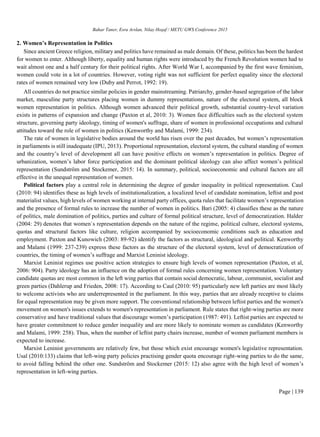
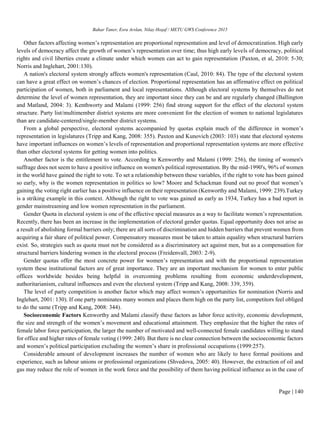
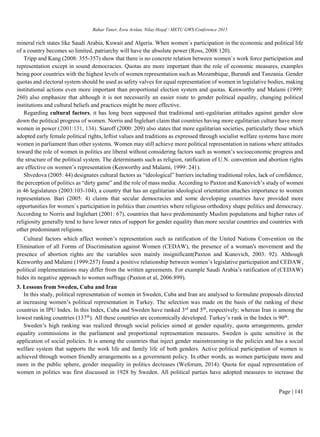


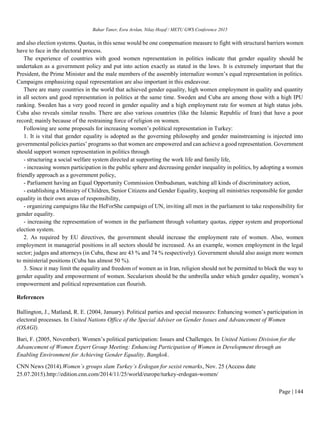

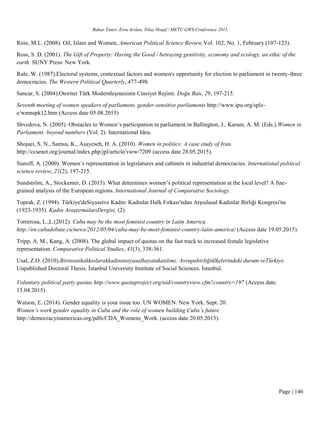



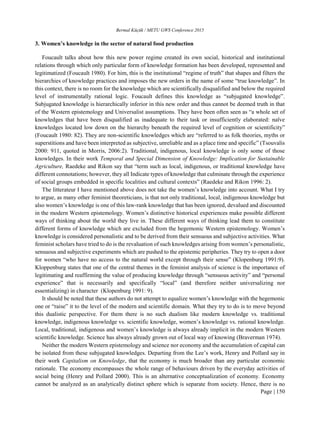

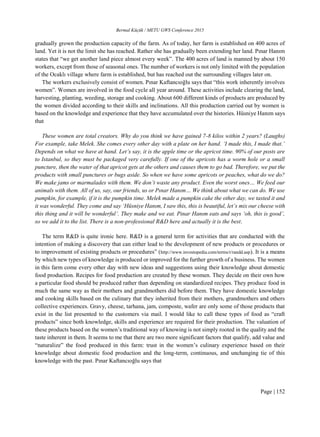

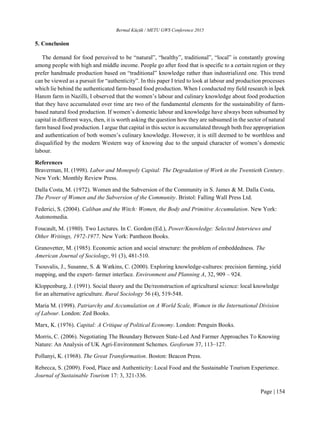

![Berrin Oktay Yılmaz, Ayşe Öztürk, Egemen Kepekçi / METU GWS Conference 2015
Page | 156
1. Introduction
According to Sandra Harding “[o]ne distinctive feature of feminist research is that it generates its
problematics from the perspective of women's experiences. It also uses these experiences as a significant
indicator of the ‘reality’ against which hypotheses are tested” (Harding, 1987: 7). This interpretation
becomes a resource for constructing an epistemology based on women’s experiences.
No doubt that feminist methodology and feminist epistemology based on women’s experiences are
different from the traditional science and the methodology and epistemology they are based on. In other
words, they don’t adopt the methods of positivist sciences. Of course, this differentiation introduces
theoretical debates on which feminist methodology and especially feminist epistemology are based.
Feminist methodology’s questioning dominant dichotomies such as subjective/objective,
rational/emotional, man/woman, masculinity/femininity which positivism and positivist sciences are based
on (Ecevit, 2011: 42) actually brought feminist epistemology debates into light. Once we go beyond
dichotomies which feminist epistemology criticizes and put aside the principles such as objectivity,
neutrality, and rationality; how will the social reality of women be explained? Is there a special approach
particular to women when it is about reality? What is the theoretical foundation of this approach? Can the
feminist standpoint theory provide us with a solution on this issue?
Feminist standpoint theory is based on Marx’s claim that the positions different classes occupy in the
society provide them with different perspectives about the social reality. The positions they are in also
provide them with different perspectives that present different understandings about social relations. At this
point he strengthened his argument by using working class as a base. According to Marx, it is possible to
reach a sound understanding of the capitalist social reality through this socially marginalized but centrally
important in economic sense (Tanesini, 2012: 170-171).
The first feminist standpoint theorists such as Nancy Hartsock, Hilary Rose, Dorothy Smith, took
Marxist definition as the model when explaining their theories. They explained the division of labor in
order to prove that there is actually women’s perspective. They made analyses that show women are both
marginal and central depending on circumstances (Tanesini, 2012: 171).
The argument of feminist standpoint theory in general is the idea that “feminist knowledge and the
production of feminist knowledge are based on social power and the feminist knowledge is based on
women’s experiences” (Ecevit, 2011:47). In other words it can be defined as efforts to understand the world
starting with the experiences of women.
It is important how and with which methodology feminist standpoint theory is dealt (Bora, 2008: 32).
According to some feminist theorists who base their studies on women’s experiences in daily life, a
hierarchical society makes up different standpoints staying connected to social life experiences. How can
women’s experiences in daily life be linked to feminist epistemology? What kinds of explanations can
standpoint offer us at this point? Could there be a theoretical level of women’s experiences? These questions
are important to examine feminist standpoint theory.
Like Sandra Harding, Dorothy Smith argues that the path to knowledge crosses with women’s lives and
emphasizes the importance of women’s perception and experiences in producing knowledge; however
instead of taking personal experience itself as the “real knowledge”, she prefers to take it as a starting point
(Öztan, 2013:38).
According to Bora: “it is not possible to know the experience directly.” In any case “having an
experience” is perceiving and evaluating something lived in the light of pre-acquired values, concepts and
approaches. When we regard the experience itself as the resource of knowledge, the point of view of the
experiencing person forms the knowledge. Thus, the questions related to theoretical nature of experience,](https://image.slidesharecdn.com/59efbcce-7adc-4ccf-9a99-524cc539d6df-160605031959/85/My-published-research-170-320.jpg)
![Berrin Oktay Yılmaz, Ayşe Öztürk, Egemen Kepekçi / METU GWS Conference 2015
Page | 157
formation process of perspective and social links of the discourse in which the experience is expressed are
all left out. Therefore, the experience needs to be approached not as a direct resource of knowledge, but as
a process formed by the subject among all these links, as a particular level of social reality” (Bora, 2008:
33).
Surely, there are many criticisms about feminist standpoint theory. The shared experience may not be
the right starting point for a feminist epistemology. Moreover, Joan Scott criticizes using experience as the
essential foundation of knowledge and claims that it means ignoring the constructed nature of experience
(Tanesini, 2012).
As Ecevit states, there are different arguments among feminist theorists on issues such as which
knowledge is to be chosen, how the concept of power will be perceived; how feminist knowledge will be
founded in experiences of women and in differences among women, while establishing the connection
between feminist knowledge and feminist reality (knowledge and power)” (Ecevit, 2011:50).
Having worked on the issue after the first feminist standpoint theorists, Kathi Weeks brings a different
point of view to the feminist standpoint theory that re-constitutes the feminist subject by approaching the
feminist standpoint theory from women’s laboring experiences. According to her, “[s]tandpoints are
constructed around the potential ontological and epistemological consequences of … laboring practices,
around the subjectivities that emerge from these practices. A standpoint is constitutive of and constituted
by a collective subject, in this case a feminist subject grounded in women’s laboring practices and situated
within the larger field of social relations” (Weeks, 2004: 188).
The aim of this paper is to discuss how Kathi Weeks conceptualizes women’s laboring practices and
how a feminist standpoint theory she wishes to develop based on the concepts which her feminist subject-
subjectivity approach is grounded. The discussion will be based on Kathi Weeks’ book called “Constituting
Feminist Subjects”.
2. Towards Kathi Weeks’ alternative feminist standpoint theory
According to Kathi Weeks, standpoint theorists focus on laboring practices in different ways: For
example “Sandra Harding focuses on the epistemological dimensions of standpoint theories, grounding
them in the more general conditions of women’s lives (including but not confined to laboring practices)
and the positions of marginality (1991). Patricia Hill Collins (1991) grounds black feminist thought in black
women’s experience, of which labor is one determinant among many” (Weeks, 1998: 162).
Stating that she focuses on the studies of the first feminist standpoint theorists such as Nancy Harstock,
Hilary Rose and Dorothy Smith, Weeks refers to their works (Weeks, 2013:19).
Instead of focusing on the system theories, Hartsock develops a standpoint theory where she locates
feminism within the subject’s activity and experience based on the idea that women have privileged
standpoints (in a similar way with Lucas’ claim that proletariat has a privileged, different perspective about
the social relations and this perspective reveals the reality) (Taghan, 2014: 10). For Hartsock “women's
lives differ structurally from those of men… like the lives of proletarians according to Marxian theory,
women’s lives make available a particular and privileged vantage point on male supremacy … [and]
feminist standpoint theory can allow us to understand patriarchal institutions and ideologies as perverse
inversions of more humane social relations” (Harstock, 2004:36).
Meanwhile Hartsock is criticized for universalizing women’s experiences. She assumes all women share
common experiences just because they have the same female body. She bases her assumption on
corporeality. This assumption explains why she prefers to use the term “sex” instead of “gender” (Tanesini,
2012: 181). No doubt that this standpoint theoy which ignores the differences among women and which is](https://image.slidesharecdn.com/59efbcce-7adc-4ccf-9a99-524cc539d6df-160605031959/85/My-published-research-171-320.jpg)

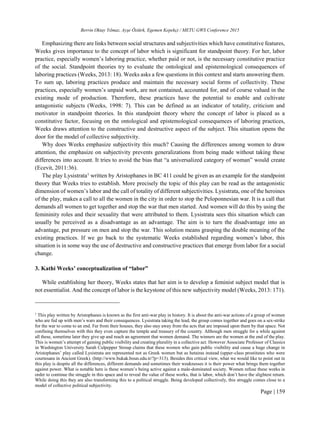
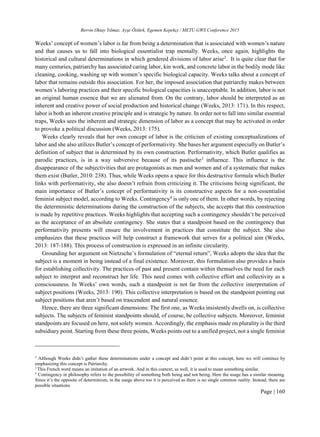

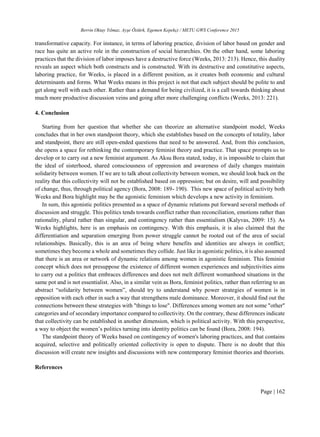




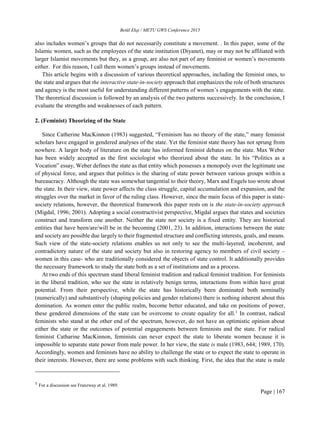
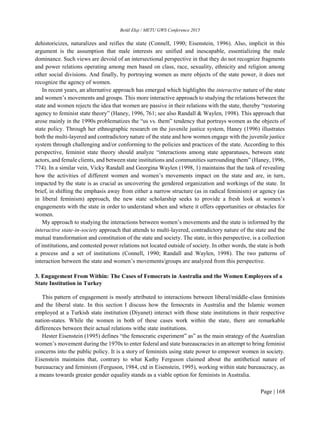
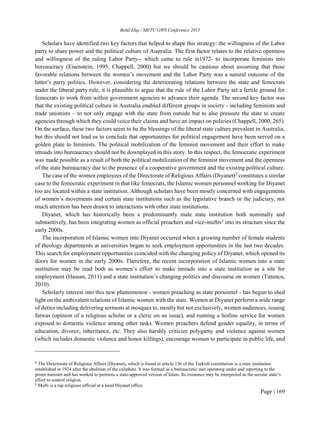
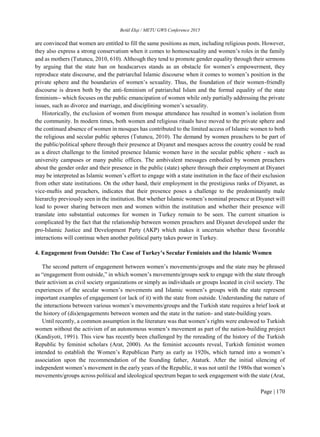

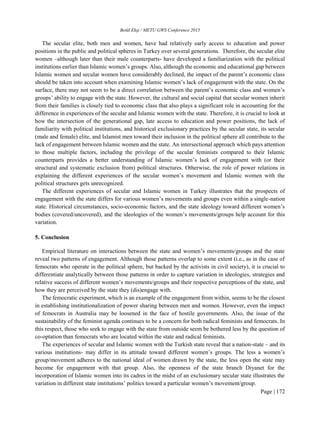
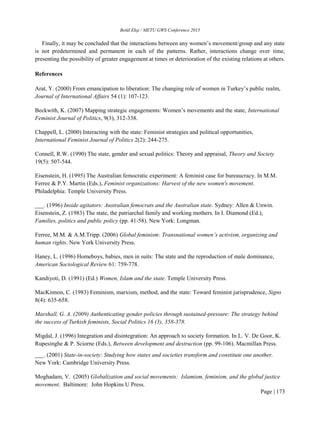

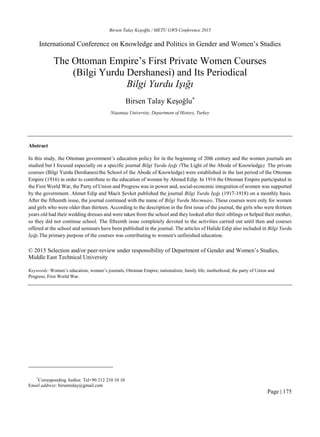


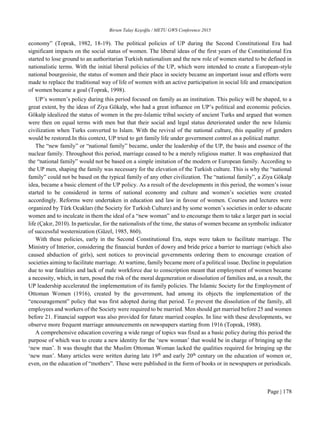
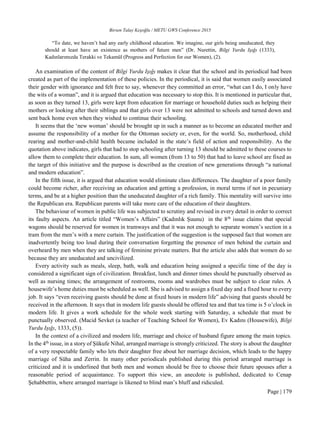

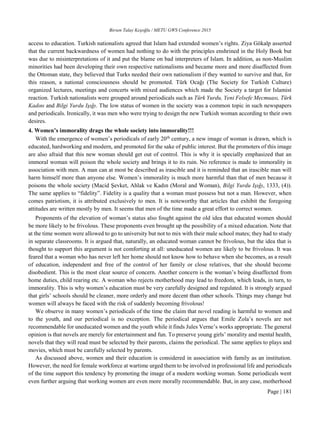

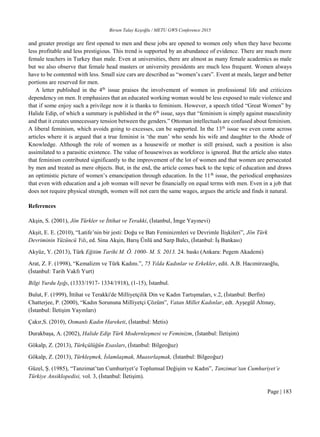
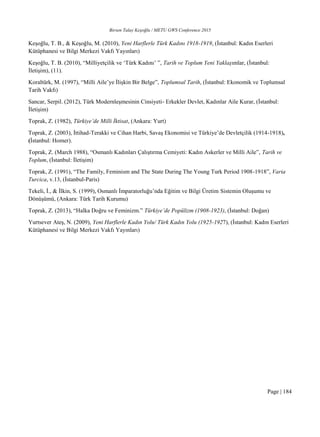






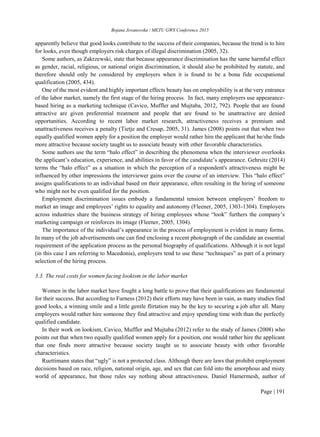

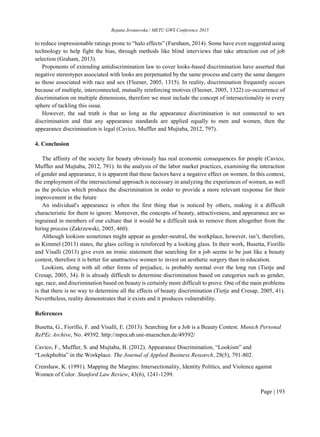


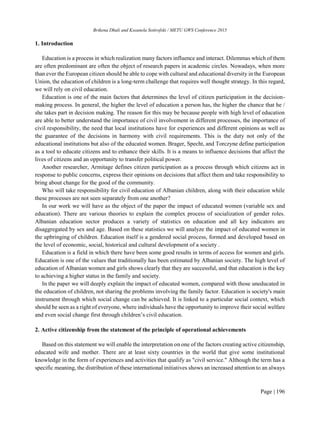
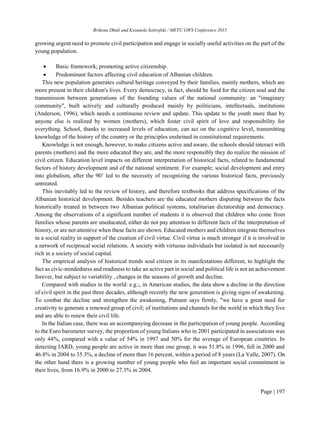

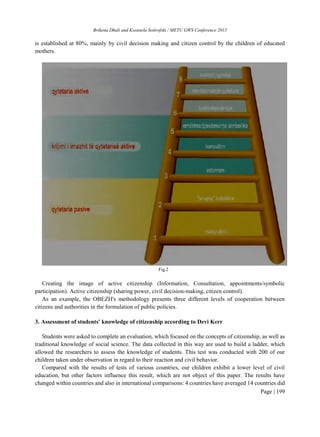
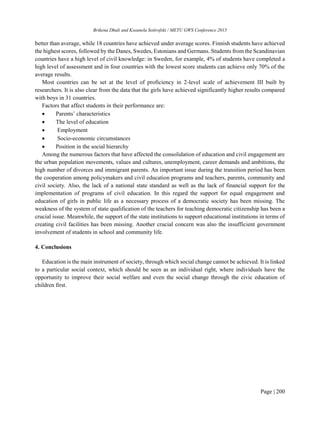


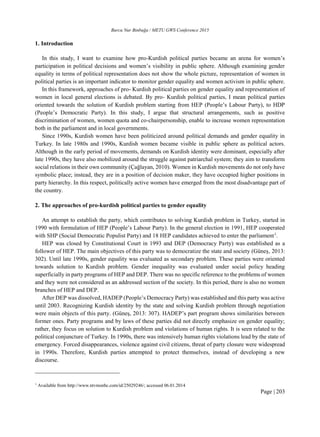

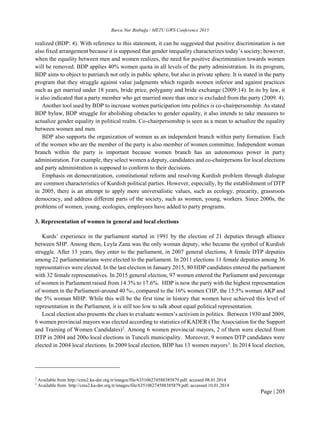


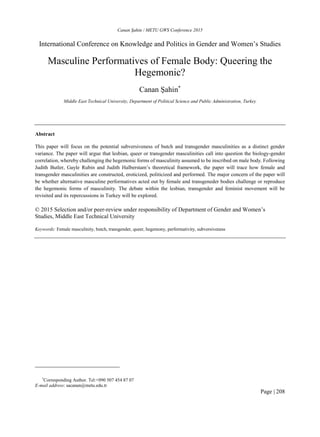

![Canan Şahin / METU GWS Conference 2015
Page | 210
whose masculine enactment problematizes the category of woman but do not feel comfortable in the
category of man either.
2.2. Debate within the Movement
While a significant body of literature saw the increasing interest in butch and transgender as a negative
development, others interpreted this trend as a sign of growing radicalism in sexual politics. To illustrate
the first category of responses, Penelope (1993: 18) saw the renewed interest in butch as “lesbian
manifestation of the contemporary right-wing backlash”. Jeffreys (1989: 160) saw it as a “dangerous
development for lesbians”. Not only butch masculinity but also femmes, commonly conceived as an
inseparable part of butch dominated erotic system, have been attacked on the grounds that they were
upholding patriarchal practices of femininity. Radical and lesbian feminism problematized masculinity in
a totalistic fashion (Nguyen 667) since masculinity has been seen as “a sign, a reward and an instrument of
men’s power” (Gardiner, 2002), and as the crucial core of the continuation of male hegemony and women’s
oppression. Gardiner (2002) wrote that masculine behavior, masculine roles, and masculine beings were an
obstacle to women’s liberation. Butch women were seen as “pseudo-men” and their masculine behavior,
dressing and treatment of women were seen “an even more insidious threat to the lesbian feminist
community [since they were seen as] the enemy within” (Love, 2000:106). Jeffreys (1989: 169) called
stone-butch a form of “internalized lesbophobia” accusing the stone-butch of rejecting or denying oneself
as female and thus a lesbian. However, not all responses were negative. On the contrary, there was a
growing body of literature drawing attention to the subversive potential of female masculinity.
2.3. Queer Responses: Butler, Rubin and Halberstam
It is possible to view female masculinity as a specific gender rather than mimicry only if perception of
gender and sexuality is based on non-naturalist and non-essentialist theorization. In Gender Trouble (1990),
Butler asserts that there is no ontological status that the body retains as a pre-given materiality onto which
gender is inscribed. She also contends that acts, gestures and desire produce the effect of an internal core
or substance (Butler, 1990: 173-174). Such an understanding breaks the assumingly natural link between
the body as surface and gender as its cultural expression, which is usually presented as a relation of naturally
determined causality. Rubin’s “Thinking Sex” (1984) had already paved the way for a socially
constructivist perspective of radical sexuality politics:
The new scholarship on sexual behaviour has given sex a history and created a constructivist alternative
to sexual essentialism. Underlying this body of work is an assumption that sexuality is constituted in society
and history, not biologically ordained. This does not mean the biological capacities are not prerequisites for
human sexuality. It does mean that human sexuality is not comprehensible in purely biological terms. Human
organisms with human brains are necessary for human cultures, but no examination of the body or its parts
can explain the nature and variety of human social systems. The belly’s hunger gives no clues as to the
complexities of cuisine. The body, the brain, the genitalia, and the capacity for language are necessary for
human sexuality. But they do not determine its content, its experiences, or its institutional forms (Rubin,
1984: 149).
Drawing on Rubin’s non-essentialist view and Butler’s account of performative gender with a slightly
nuanced correction, Halberstam provided the first book-length study of female masculinity in its most
inclusive term. Historical and literary representations of female masculinity and transgender were featured](https://image.slidesharecdn.com/59efbcce-7adc-4ccf-9a99-524cc539d6df-160605031959/85/My-published-research-224-320.jpg)

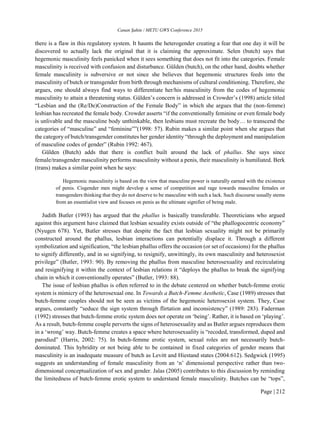
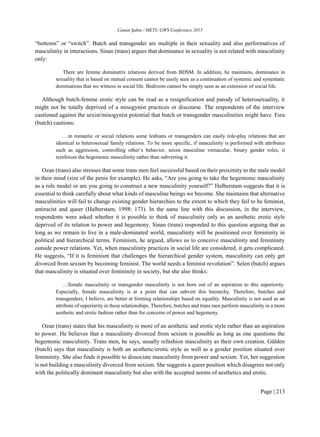
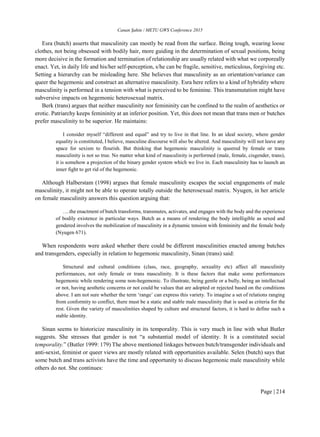
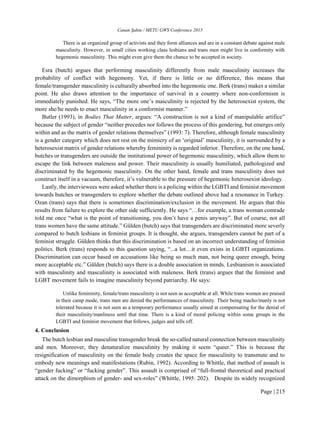

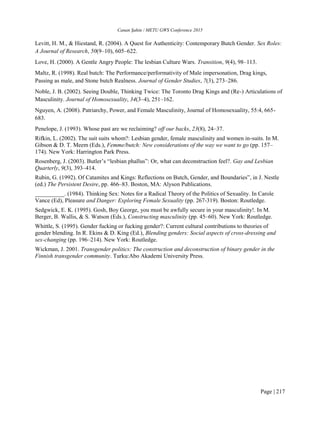



![Çağrı Yılmaz and Kübra Özdemir / METU GWS Conference 2015
Page | 221
photograph or on the screen in front of us” (Abercrombie and Longhurst, 2007: 178). If elaborately defined,
an image
[…] is a collection of signs and symbols – what we find when we look at a photograph, a film still,
a shot of a television screen, a print advertisement, or just about anything. … Images generally are
visual, often are mediated – carried by the mass media – and are connected to information, values,
beliefs, attitudes, and ideas people have. … An image is a collection of signs, and each of these
signs has meaning; in any image, there are many different levels of meaning and interactions
between meanings (Berger, 2008: 61).
A strict bond is required to be formed between an image maker and a community in order that the
message conveyed via the images can be better understood by the target group of people. Each image
constitutes a message for the targeted audience. Images, thus, function in causing people to develop an
attitude and adopt new ideas or influencing their decisions on condition that a common sense can be
established in a community. John Berger (2008: 9-10) in his Ways of Seeing associates an image with
seeing:
An image is a sight which has been recreated or reproduced. It is an appearance, or a set of
appearances, which has been detached from the place and time in which it first made its appearance
and preserved – for a few moments or a few centuries. Every image embodies a way of seeing.
[…] Yet, although every image embodies a way of seeing, our perception or appreciation of an
image depends also upon our own way of seeing.
Berger’s quotation above lays emphasis that reproduction of an image cannot be distinguished from the
subjective way of perception. Each looker can make his/her own interpretation out of the image seen. It is
possible to decontextualize an image from its original meaning that it stands for and tackle it independently
from its entity. For the sake of a nouveau meaning, the image can reformed, reproduced and reinterpreted
with a user’s subjective vision.
Creation of an image paves the way for a dichotomy: First of all, an image which is subjectively
interpreted and (re)produced through “information gathered and processed” as Rudolf Arnheim (1997: 1)
points out, by individual mind that either recollects discourses and acts performed in the past and connected
to the present, or absorbs particular information of the present to process. Secondly, collective mind which
affects the way an individual reproduces an image. The former refers to the notion that each person is
enabled to create an image via his/her past or present experiences whereas the latter sheds light on the fact
that each subjective (re)creation of an image stems from the totality of a social ambiance in which societal
or communal factors such as family, society, nationality, religion, state, national forces, educational
institutions, media, ethnicity, collective identity, gender etc. play a crucial role. Subjectivity, therefore, can
be claimed to be (re)formed in a cultural framework by social (re)constructions.
3.1. Caps: a hybrid unit of the sayable and the visible
Caps, a new medium of humour and satire in which image and discourse coexist in an eclectic style “… is
a narrative form interwoven with daily life and current issues” (Dede at al., 2014: 109). Works of caps are
“cognitive visions which the artists create through their imagination and not only include concepts
concerning the world and ideas but also display figurative characteristics” (Göğüş and et al., 1998: 65).
Caps is exploited to describe an instant state/situation or a person through an image captured from any form
of media such as picture, painting, video, film, television programs etc. and originally stated or quoted
writing which is meant to complement the image for a better depiction. Both the image and text are
individually present for their own sake at first. The maker either applies electronic photocomposition](https://image.slidesharecdn.com/59efbcce-7adc-4ccf-9a99-524cc539d6df-160605031959/85/My-published-research-235-320.jpg)
![Çağrı Yılmaz and Kübra Özdemir / METU GWS Conference 2015
Page | 222
techniques to reform the image or acts in loyalty to the original image. Most of the time, s/he
decontextualizes the image to integrate it with the written text. Finally, the sayable and the visible are
reformed in a unit constituting a “sentence-image” (Rancière, 2008: 50), after which caps, a new and
coherent context, is offered to the readers.
Pioneered by İnci Caps website and İnci Sözlük, an online interactive dictionary designed in 2009 by
İsmail Alpen and Serkan İnci, Caps movement has allowed images to be simply distributed in digital form
on a variety of social networking websites including Facebook and Twitter. Caps movement primarily
pursues entertainment and social networking websites have been Caps makers’ playgrounds. In İnci Caps
Kutsal Mizah Kırbacı written by Umut Kullar and Serkan İnci to introduce Caps movement, Kullar and
İnci (2015: 9) assert that İnci Caps can be considered to have created a new sense of humour on social
media. Millions of social media users are regarded as the founders or creators of İnci Caps movement (2015:
10), as the writers state. Kullar and İnci (2015: 11) put the dynamic process of creating caps into words
explaining that “acting arbitrarily is an obvious requirement of caps philosophy; most of the creations are,
therefore, improvised. […] It is neither a doctrine nor a paradox put forth to raise an issue. It is, in its
definite and plain term, humour”. Caps instantly come out of human nature (Kullar and İnci, 2015: 16). In
addition, “individuals’ immediate interactivity with the facts of world” and “the close relation between the
increasing power of caps and participation of users” (Kullar and İnci, 2015: 15) contribute to the dynamic
processes of creation and distribution of caps. In the process of creation, events are humorously redesigned
or a visual description is satirized (Kullar and İnci, 2015: 25). Kullar and İnci (2015: 85) call caps makers
“mizahşör”. “Mizahşör” is derived from Turkish words “mizah” and “silahşör”. In English, “mizah” means
“humour” and “silahşör”, “musketeer”. Such an appellation indicates that caps makers are regarded as those
who use their sense of humour as a gun. Humour is considered to be a highly valued individual act by caps
makers. By that individual act, a great number of people can be gathered to act collectively and “break
taboos” (Kullar and İnci, 2015: 19) of sacred values established in a given society regarding religion,
nationalism, gender, politics etc. Caps movement is considered to have created a new sense of humour on
social media, especially on social networking websites, thanks to caps makers who have created a new
sense of humour, “techno-humour” (“tekno-mizah”, in Turkish). We offer “techno-humour” as a new sense
of humour which has been developed through the digital age of the 21.century on social media platforms.
Caps makers who exploit caps to redefine cultural ideals inherited from the society and institution of family
undermine these ideals by a satirical approach. Deconstruction of the sacred values, now reconstructed in
a different manner, does not offend but makes laugh.
On the other hand, it is an unavoidable fact that “Caps makers are differentiated in cultural background
and take an individual approach to humour” (Kullar and İnci, 2015: 19). Variety in viewpoints is linked to
one’s outlook on life, character, education s/he receives from family and school, social sphere and relations,
values, religious belief, sex etc. Yet, there still remains a risk in misinterpreting and misperceiving things
and, as a result, reconstructing and reinforcing a misbelief in a community. Self-reference always relies on
one’s former experience and actual knowledge of life.
Gender is of such an utmost controversy that preconceived thoughts and discourses on being a “man or
woman” are repetitively reproduced in a community. Since this writing wishes to handle problematical
representation of woman persona and femininity through caps, it is aimed to demonstrate that not only
thoughts and discourses but also images are mediated to reproduce misconceived or misbelieved facts about
woman. Discriminative attitudes against femininity, forming a woman’s character in a restricted and,
mostly, patriarchal frame and irrational expectations about what a woman is supposed to be are not only
constituted on a discursive basis but also embodied in images, which corroborates us that “our thoughts](https://image.slidesharecdn.com/59efbcce-7adc-4ccf-9a99-524cc539d6df-160605031959/85/My-published-research-236-320.jpg)



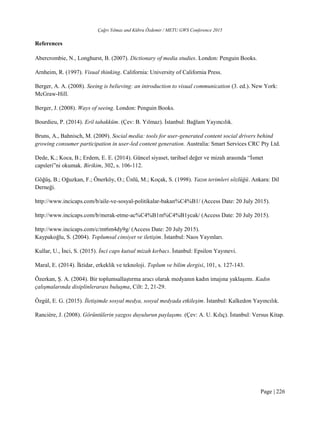
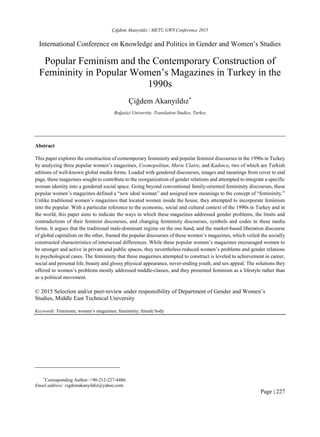
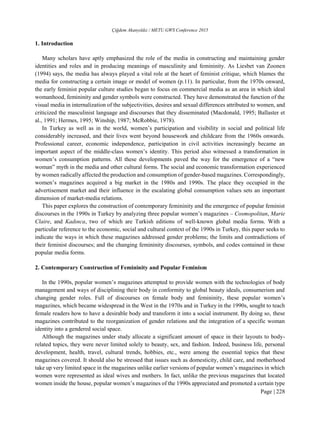

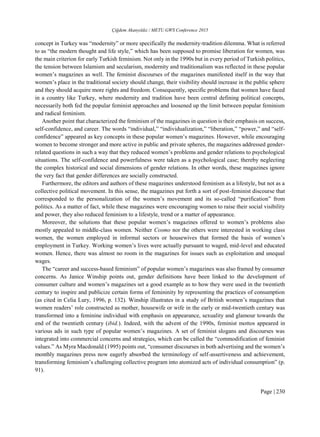

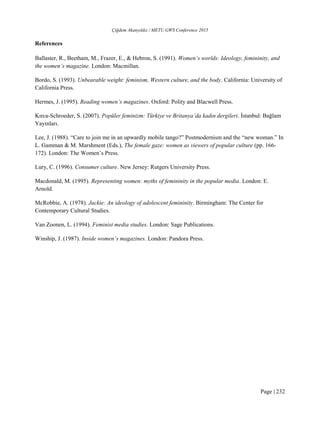

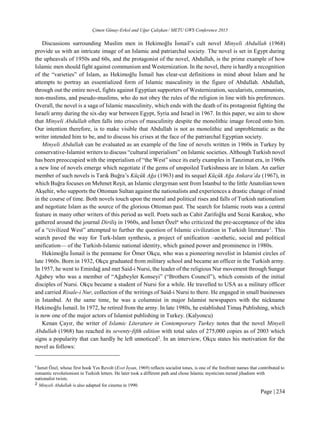


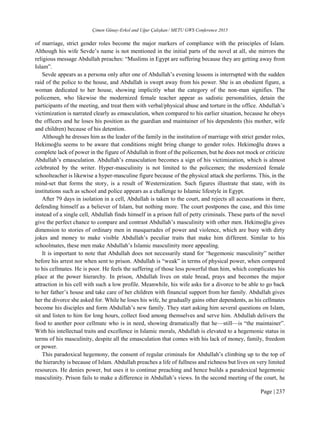


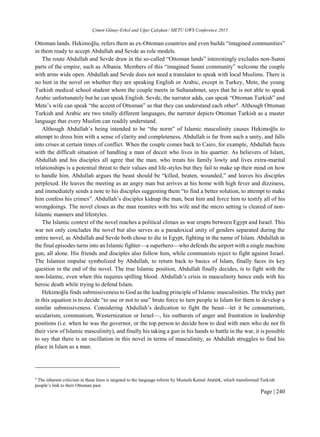




![Defne Erzene Bürgin and Selin Bengi Gümrükçü / METU GWS Conference 2015
Page | 245
1965. As of 2013, this rate was 31.2%. While this is major setback compared even to the 1960s, this rate is
around 30% since the 1970s. In addition, it is observable that there is an amelioration since the second half
of early 2000s, as the rate was 23.3% in 2010. However, it is obvious that these shares are far from desired
and needed, especially compared to Turkey’s European counterparts. As it is mentioned in a 2013 report
by Women’s Labor and Employment Initiative Platform, “even though Turkey is one of the selected
emerging economies among OECD members, Turkey is ranked last with respect to women’s economic
participation” (KEİG 2013). Departing from this fact, increasing women’s participation in labor force is
listed as one of the targets of the Tenth Development Plan (2014-2018) approved by Turkish Grand National
Assembly in 2013. It is aimed to increase women’s participation rate to 34.9 % and women employment
rate to 31 % (Ministry of Development, 2014).
In this regard, thanks to the efforts of the women’s movement and the EU accession process,
policymakers developed some concerns about increasing women’s share in labor force. However, there are
some scholars who claim that these concerns are not as “innocent” as they seem. According to the advocates
of this idea “the main motivating factor has been the re-invented advantage of the policies targeting the
‘disadvantaged population’ in fostering economic development. A declining fertility rate coupled with a
larger working-age population has stimulated the economy, expanding production” (KEİG 2013). Thus,
women, as an “untapped pool of labour resource” would be used for further economic growth (KEİG 2013).
Whatever the reason is, it is obvious that there have some recent developments in Turkey to urge further
participation of women to labor force. In early 2015 the government introduced new incentives package to
encourage working women to have more children. Prime Minister Davutoğlu declared that: “Mothers
[working in public office] will be able to continue to be promoted in their positions even in their unpaid
leave after birth. We will also make arrangements for part-time work for mothers. After the end of maternity
leave, mothers with one child will have the right to work part-time for two months, mothers with two
children for four months, and mothers with three or more children for six months. They will receive full
wages while working part-time” (Hürriyet Daily News, January 8, 2015). While this incentive presents
some benefits for working mothers, it also received critical comments from some actors advocating gender
equality. Debates about the role of women in society were further fueled by the statements of Minister of
Health, Mehmet Müezzinoğlu, which he made during his visit to the first baby born in 2015. He said during
his visit that, “Mothers have the career of motherhood, which cannot be possessed by anyone else in the
world. Mothers should not put another career other than motherhood at the center of their lives. They
should put raising good generations at the center of their attention” (Hürriyet Daily News, January 1, 2015).
He repeated his idea on January 2nd
, 2015 when he was asked to comment about earlier statement:
“Motherhood is indisputably a career” (Hürriyet Daily News, January 2, 2015). These statements also
created disputes about the issue.
In sum, it is clear from all these data and debates that “the incorporation of a gender equality perspective
into the areas of employment, power and decision-making, research and budgetary and financial policies
has also not been realised” in Turkey (KSGM 2013). In order to incorporate the gender equality perspective,
it is of significant importance to raise consciousness of men about the issue. Indeed, raising awareness and
sensitivity of men to achieve gender equality is listed as one of the means of promoting gender equality in
some documents. For instance, “defining the roles of men in achieving gender equality and raising their
awareness” is listed as one of the objectives of the relevant public offices in Turkey in order to empower
women and promote gender equality, in the National Action Plan Gender Equality 2008-2013 published by
the General Directorate on the Status of Women (KSGM 2013). In this regard, the KSGM is the responsible](https://image.slidesharecdn.com/59efbcce-7adc-4ccf-9a99-524cc539d6df-160605031959/85/My-published-research-259-320.jpg)


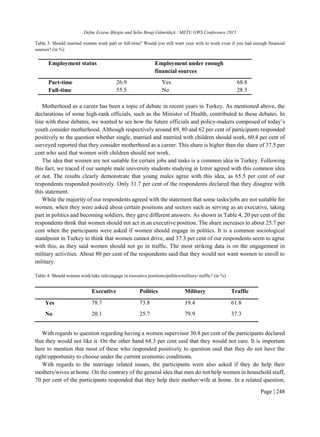
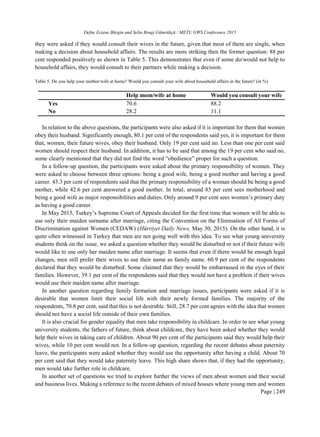
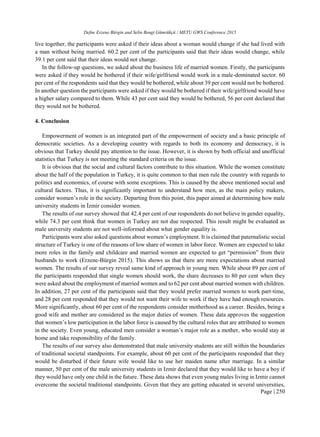
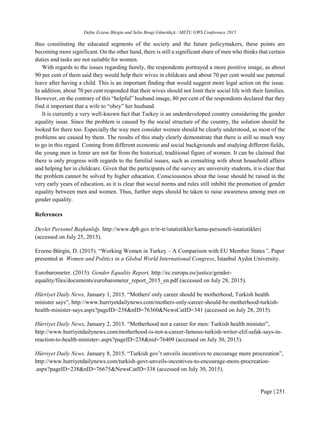
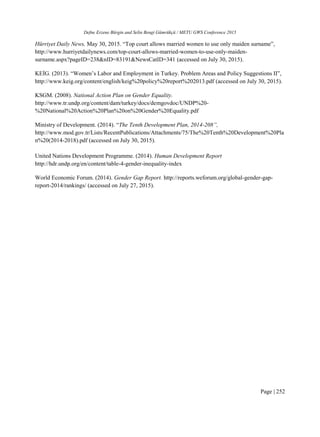

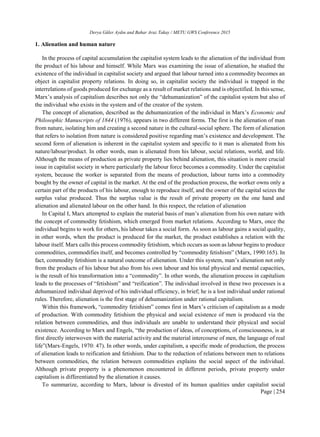

![Derya Güler Aydın and Bahar Araz Takay / METU GWS Conference 2015
Page | 256
peaceable ‘savage’ life. Workmanship is no longer production; acquisition of goods and idleness are the
determining social values (Veblen, 1973 (1899)). In this culture, jealousy of status and meaning and value
determined by competition are attributed to commodities and consumer goods involving animistic qualities,
but not to the production process (Diggins, 1977). In brief, conspicuous consumption and idleness and
acquiring and using objects and time extravagantly began to find a place in the central values of the society.
Veblen’s critique of capitalism emerges as conspicuous consumption and the alienation of the individual
who loses his instinct of workmanship. Conspicuous consumption is symbolic because it serves the
individual to exhibit himself in society. Workmanship is only a means to acquire wealth (Veblen, 1946). In
developed capitalist societies, conspicuous consumption, wealth, and property represent power more than
need and are the main goals in life. More consumption is indicative of belonging to a higher class. A desire
to own things is displayed to develop jealousy in other individuals, - consumption is a means of displaying
the buyer’s superiority. Consumption that goes beyond necessity gets ahead of production, creating a
condition that underrates work. In a capitalist society, a social class excluded from production and work
activities expresses itself in conspicuous consumption. This class tries to display its power not by working,
but by spending (Veblen, 1946).
In conclusion, Veblen, who explains alienation on the basis of conspicuous consumption and loss of the
workmanship instinct, argues that there are two basic weaknesses that lead to the alienation of man. The
first weakness is the impact of animism and the second and most important is society’s contempt for
workmanship. Man’s salvation from alienation depends on acceptance of the workmanship instinct as the
most valuable phenomenon. The machine age enables salvation from this alienation. In Veblen’s view, the
machine and the engineer who designs it is productive, profitable and less lavish lifestyle and the society
that sustains them best, develops (Veblen 1973 (1899)).
2. The Spiritual Journey of Goddesses of Capitalism
This study focuses on the question of what lies behind the growing interest in “personal development”
among women in recent years. In this context, the fact that the women who show this tendency are usually
employed in high-income jobs is the main factor that drives one to think that the incentive behind this
growing interest may be rather socio-economic than personal. From this point of view, this study questions
the existing economic and social structure and bases its analysis on the concepts of alienation and
conspicuous consumption. The selected sample group consists of women who are employed in high-ranking
(mostly executive) positions in the private sector. Within the framework of this study, in-depth interviews
were conducted with eleven women. In addition to questions about their demographic and social
identifications, the respondents were asked about the alienation of women induced by the market society
and their consequent inclination towards personal development activities. Moreover, the ways in which
conspicuous consumption, which also involves personal development activities, reproduces alienation were
inquired about. During the interviews, the respondents expressed in their own words negative views about
capitalism.
“Well, [it is] a game in which we are wholly absorbed, such a relentless spirit...” (Interview No.1,
Istanbul)
“I mean capitalism is a system in which money is above everything else.” (Interview No.3, Istanbul)
“Capitalism is war and rivalry.” (Interview No.5, Istanbul)
“...[it is] struggle, definitely struggle” (Interview No.8, Ankara)
“Capitalism is private business...” (Interview No.10, Ankara)](https://image.slidesharecdn.com/59efbcce-7adc-4ccf-9a99-524cc539d6df-160605031959/85/My-published-research-270-320.jpg)
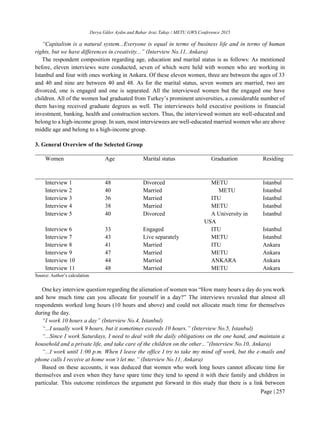
![Derya Güler Aydın and Bahar Araz Takay / METU GWS Conference 2015
Page | 258
aspirations for personal development and a busy work life. Within this scope, the respondents were asked
what they did to rest their body and soul. Personal development activities ranked first among the responses
to this question. Yoga, meditation, NLP and breathing therapies in particular were very popular among the
interviewed women. As a matter of fact, the respondent in Interview No.10 in Ankara stated that yoga hours
had been initiated at her workplace, and that such a therapy method that could be utilized during lunchtime
or out of working hours was very rewarding for women in particular.
“Your body and soul cannot rest. I also take care of the corporate dealings of the firm. We have initiated
yoga hours for our female personnel at the firm...I will not be able to participate this evening because I
need to work; I cannot leave [the office]. It will be very good if we can boost such activities. Everyone in
the firm needs this...Fatigue has accumulated.”(Interview No.10, Ankara)
When the other interviews are also taken into consideration, it is seen that personal development, or
centuries-old Buddhist philosophy in other words, has been taken up and commercialized by the market as
nearly the sole instrument for self-transformation, self-tranquilization and self-relaxation. Women who
participate in personal development activities to avoid the “fatigue and busyness” caused by working under
intense competition in the market are themselves becoming “instrumentalized”, and in a way alienated, as
they contribute to the introduction to the market of another commercial instrument.
“You can detox by doing exercise, or feed your soul by, I don’t know, going to a (book) fair. You can
socialize or do something else... I think the economy works this way. A new sector [the respondent refers
to personal development courses] is being created; I believe it is like a soap bubble to burst soon. First a
need is invented and then they say this is the cure.”(Interview No.2, Istanbul)
While we refrained, at the beginning of the interviews, from asking in an explicit manner the question
of whether the market/work life alienated them, all respondents, when asked directly, stressed without
hesitation that they were alienated from their lives and their identity, especially as a woman. Their role as
a mother, through which they experience their female identity to the fullest, provides them with a space to
breathe. On the other hand, however, this role lays a burden on them. The respondents expressed that they
were in a disadvantaged competitive position vis-à-vis men holding similar positions in business life and
that they needed to assume extra responsibilities to overcome this disadvantage.
“Well, the work place is a battlefield for him (man); there is nothing against his nature there. We, on
the other hand, are in a struggle for existence outside of our nature. What does this do to us? This makes
us neither a man nor a woman.” (Interview No.1, Istanbul)
“Here, there are many colleagues who are fathers. But they never have a sick child or a parents’
meeting as an excuse because mothers have to take care of these... There is no fair division of labour in our
society; women have to display full performance both at work and at home. This is seen as something
capitalism entails.” (Interview No.2, Istanbul)
The responses of the interviewees to questions about capitalism, working hours and work place
competition presented qualitative differences between the interviews held in Istanbul and those held in
Ankara. Undoubtedly, the geographical, cultural and commercial peculiarities of the two cities lead to
differences in their social and economic structures. This difference became evident when the respondents
in Istanbul made more pungent comments on capitalism than those made by the respondents in Ankara. It
is interesting to observe that the same system may function in divergent ways across different geographies
within the same country, though still having disruptive effects throughout. A similar situation manifested
itself also in the responses to questions about alienation and conspicuous consumption.](https://image.slidesharecdn.com/59efbcce-7adc-4ccf-9a99-524cc539d6df-160605031959/85/My-published-research-272-320.jpg)



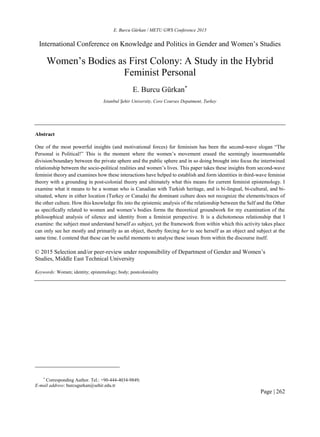
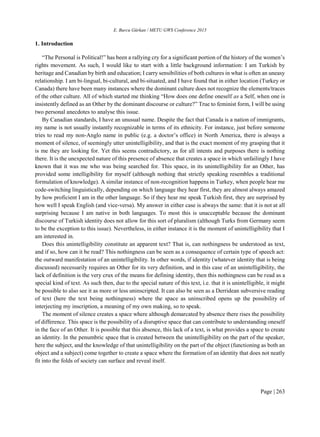
![E. Burcu Gürkan / METU GWS Conference 2015
Page | 264
2. Two Empirical Studies: Moments of Erasure
A recent study published in Psychological Science offers us an interesting experiment on self-
representation and objectification of women’s bodies. In the experiment, students are asked to give an oral
introduction of themselves in one of three modes (randomly chosen) to an unseen listener. The sex of the
listener was indicated to these students at the beginning of the experiment. Of the three modes – videos of
their faces, or their bodies, or audio only – the most interesting results (although not unexpected) were from
the interaction that the female participants displayed when the video was of their bodies and their
interlocutor was male.
Women who were in the body condition and thought they were interacting with men spent less
time talking than participants in all other groups. In addition, the majority of women disliked the
body condition, indicating that they found having their bodies gazed at aversive. (Saguy, Quinn,
Dovidio, Pratto, 2010, p. 178-182)
The authors of the study set out to examine the impact of objectification during social interaction. The
aim was to analyze how ‘objectified targets’ presented themselves to others.
The study’s conclusion makes the claim that:
[w]e demonstrated that when a woman believes that a man is focusing on her body, she narrows
her presence in the interaction by spending less time talking. The impact of objectification on
talking time occurred independently of gender self-stereotyping, which suggests that attempts to
behave femininely did not account for this effect. It is important to note that the majority of women
disliked the body condition, indicating they found having their bodies gazed at aversive. In
addition, when freed from this experience, and from visual inspection more generally (i.e., in the
audio condition), women did not talk less than men. (Saguy et al., 2010, p. 181)
This is indicative of self-silencing, an erasure of self, so to speak. The authors theorize different reasons
for how and why this happens, not the least of which is the possibility that women’s cognitive preoccupation
with objectification reduces their ability to speak or have an intellective interaction (!). (Saguy et al., 2010,
p. 182)
While it may be dangerous to draw gross generalizations from one study, the implications of this sort of
inquiry seems intriguing from a feminist point of view in that it could lay the groundwork for some sort of
empirical foundation for further investigation. Not only does the study gesture towards the fundamental
importance and weight of the body in relationality, it underscores the primacy of gender in this relationality.
The reduction to an objectified entity – in this case simply the body – rendered the subjects less likely and
less able to both present and represent themselves. This is an obvious case of direct objectification and its
concomitant results, namely a silencing of self. The question that now arises is what this implies for less
direct moments of objectification. What happens when we, a la Foucault, are reduced to disciplined bodies?
And more significantly, what does this mean for women who often are no more than their bodies?
A comparable, but earlier, experiment reached similar conclusions, albeit with an explicit feminist
grounding and methodology using objectification theory (Fredrickson, Roberts, Noll, Quinn, Twenge,
1998, p. 269). Objectification theory argues that the “cultural milieu of sexual objectification functions to
socialize girls and women to treat themselves as objects to be evaluated on the basis of appearance”
(Fredrickson et al., 1998, p. 270). Taking their cue from Sandra Bartky’s preliminary definition in](https://image.slidesharecdn.com/59efbcce-7adc-4ccf-9a99-524cc539d6df-160605031959/85/My-published-research-278-320.jpg)
![E. Burcu Gürkan / METU GWS Conference 2015
Page | 265
Femininity and Domination, the authors characterize the occurrence of sexual objectification “whenever
people’s bodies, body parts or sexual functions are separated out from their identity, reduced to the status
of mere instruments, or regarded as if they were capable of representing them” (Fredrickson et al., 1998, p.
269). In other words, individuals become equated, and conflated, with their bodies; they become objectified,
becoming objects for the surveillance (and pleasure) of others. This type of sexual objectification happens
both in terms of “actual interpersonal encounters” and through the ubiquitous presence of mass media where
studies have shown women are far more often the target of objectifying treatment” (Fredrickson et al., 1998,
p. 270).
Objectification theory holds that, then, culture socializes girls and women to internalize an objectifying
perspective on their own bodies, an effect that they have termed “self-objectification” (Fredrickson et al.,
1998, p. 270). In this they mean that “individuals think about and value their own body more from a third-
person perspective, focusing on observable body attributes (e.g., “How do I look?”), rather than from a
first-person perspective, focusing on privileged, or non-observable attributes (e.g., “What am I capable of?”
or “How do I Feel?”)” (Fredrickson et al., 1998, p. 270). Self-objectification, as the authors argue, can result
in an “array of intraindividual psychological consequences,” such as the vigilant monitoring of the body
which can lead to an overconsumption of mental resources being devoted to constant bodily attention
(Fredrickson et al., 1998, p. 270-271). Given that the authors are attempting to study the mental
consequences of female bodily objectification, they surmise that self-objectification as a result of pervasive
and insidious sexual objectification can lead to a decreased capacity to perform mental activities (in the
experiment they used advanced mathematical tests to evaluate these mental activities) (Fredrickson et al.,
1998, p. 271).
The experiments tested three hypotheses: that self-objectification would lead to 1) body shame, the
consequence of which was restrained eating; 2) diminished math performance; and 3) being more evident
amongst women rather than men (Fredrickson et al., 1998, p. 273). The first experiment asked the
participants to fill out questionnaires both before and after they were randomly assigned to either wear a
sweater or a swimsuit. They were then also requested to sample some chocolate chip cookies Although the
authors claim that while their “data do support the existence of self-objectification, they do not speak to its
origins” (Fredrickson et al., 1998, p. 281). Their results conclude that experimentally induced self-
objectification does in fact correspond to both restrained eating (due to bodily shame) and poorer
performance on mathematics tests in women (rather than men) (Fredrickson et al., 1998, p. 281).
In their discussion the authors reference Iris Marion Young’s phenomenological analysis of the female
body in “Throwing Like A Girl.” They argue that:
[w]hen girls and women maintain an observer’s perspective on their bodies, Young argues, they
simultaneously experience the body as an object as well as a capacity. (Fredrickson et al., 1998,
p. 272)
Young’s article on feminine bodily comportment does in fact reach this conclusion, she says “the bodily
self-reference of feminine comportment … derives from a woman's experience of her body as a thing at the
same time that she experiences it as a capacity” (Young, 1980, p. 145). Young maintains that women in
culture and society are defined as the Other, “the inessential correlate to man” (Young, 1980, p. 141). And
that women, being denied the subjectivity, autonomy, and creativity normally accorded to men, exist in a
contradictory position whereby they must, as humans, establish subjectivity, and yet by virtue of their
subjugated positioning they also exist as mere object (Young, 1980, p. 141). She ties this to the three
modalities of feminine bodily comportment: “ambiguous transcendence, an inhibited intentionality, and a](https://image.slidesharecdn.com/59efbcce-7adc-4ccf-9a99-524cc539d6df-160605031959/85/My-published-research-279-320.jpg)
![E. Burcu Gürkan / METU GWS Conference 2015
Page | 266
discontinuous unity with [the body’s] surroundings” (Young, 1980, p. 145). These can all be derived from
the woman’s experience of her body as a thing.
All three modalities, for Young, are rooted in the fact that for feminine existence the body is lived as
both subject and object simultaneously (Young, 1980, p. 148). In other words, that which constitutes a
crucial aspect of lived experience is/becomes a thing in the world akin to other things in the world. She
accedes that any lived body necessarily has a material dimension/existence to it, for “feminine bodily
existence, however, the body is often lived as a thing which is other than it, a thing like other things in the
world” (Young, 1980, p. 148). In other words, in addition to also being a subject (as a human person) a
woman lives her body as object, constantly in a state of disunity and discontinuity (Young, 1980, p. 153-
154). Thus, not only does a sexist, patriarchal society define and register women as body (or mere object),
but the parameters within which this society exists necessarily exert an internalization of this point of view
on women thus forcing them to exist in a perpetual state of simultaneously existing as both Self and Other
at the same time.
3. Self-Knowledge, Women and The Body
From a traditional epistemological point of view knowledge qua knowledge is only adequate if it is
objectively produced and organized. That is, as a knowable object, theoretically knowledge is accessible
by everyone. However, this “everyone” is a very specific type of knower – one who is rational, objective,
free from biases and lacks an evaluative or normative perspective (at the very least they should lack an
emotionality for the objects of knowledge). I hesitate to argue that the knower lacks any normative
perspective because, at the very least, there are judgments being made whether what is being studied is
‘good’ or ‘bad’ in terms of its being objective. It is this notion of the “objective” knower which makes for
an interesting contradistinction when it comes to trying to access self-knowledge. As that which is sought
folds over onto itself as the subject looks at itself as an object, the questions of how identity is formed and
how it is informed take a more central position in shaping the way in which this knowledge is sought.
4. Postcoloniality, Identity, and Women’s Bodies
The formation of identity with regards to women and women’s bodies seems especially fecund given
the positioning of a kind of double othering that women from non-Western nations experience. In particular
I have found the postcolonial theory has both the germination of, and the grounding for, an interesting
analysis in this respect. The establishment of the Self necessarily involves the marking of the Other. And
in non-Western nations, themselves defined as the Other, I argue, it is not simply a case of a reinscription
of the Self-Other dialogue where the non-western male is the Self and the non-western woman is the Other:
a smaller yet identical unfolding of the Self-Other dialogue re-inscribed onto the non-western relationship.
This is also not a position of standpoint epistemology where the oppressed (or the periphery) has a
privileged and doubled position as knowing subject. The non-Western, sometimes Orientalized,
postcolonial subject and the identity formation of the self, that is first marked as Other and then remarked
as Other again (in the case of women), is both different in kind and degree. In other words, the formation
of the knowing subject, when she is a woman, is not simply a case of two similar layerings of otherness –
one where she is othered because she belongs to a non-Western category and another layer where she is
othered again because she is a woman. The negation of the body and Woman’s bond to the body leaves her
in this state of palimpsestic limbo where her definition of herself is written for her.](https://image.slidesharecdn.com/59efbcce-7adc-4ccf-9a99-524cc539d6df-160605031959/85/My-published-research-280-320.jpg)

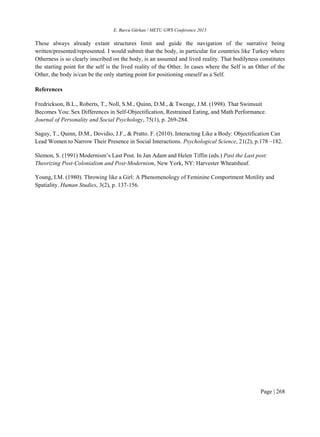

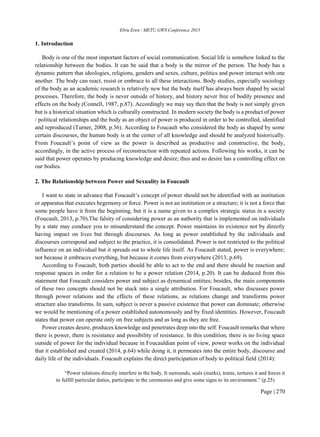
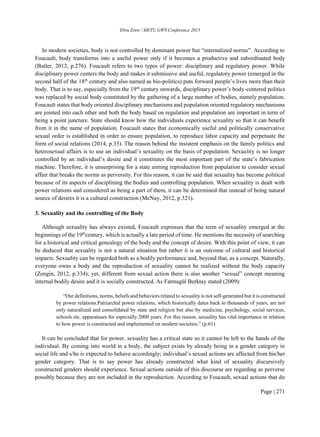
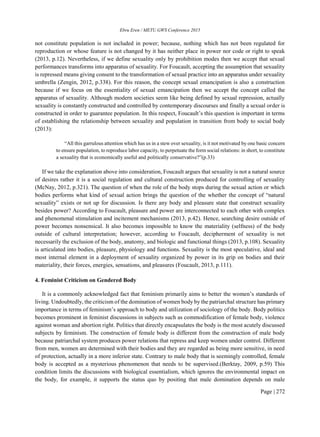
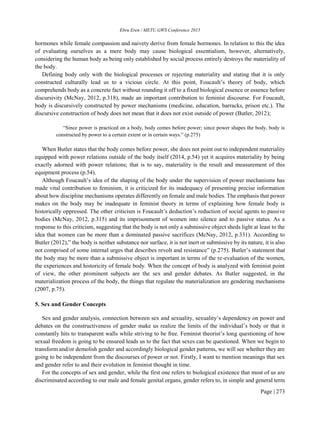


![Ebru Eren / METU GWS Conference 2015
Page | 276
Identity marks something about my position in my travels, but it is not my ground, my epistemology, or
indeed my final stand.” (interview)
Butler states that a person can organize for an identity category; however, this identity will not be a
ground for the person but it indicates the person’s present situation and it shows that identities can be
changed as a result of discourses, gender can be turned upside down and sex is not a fixed category. The
thing that we assume as an “internal” feature and identities that we build upon it is the hallucinatory effect
of naturalized gestures (Butler, 2012, p.29). When it is realized that gender has also a gender identity and
produced by repetitive performances, we can open up to a world in which it is possible to form new social
modes by eluding from the current social bodies.
7. Conclusion
We have seen that the body, which is one of the most important elements of the social interaction, is not
independent from relationality, discourses, culture, history and power. By giving reference to Michel
Foucault’s and Judith Butler’s works, I have tried to express that the body is not an ascribed entity; on the
contrary, it is a historical reality that can be interpreted through culture. The body, which is a product of
social practices, political and cultural discourses, cannot be found outside of the system that formed through
language because language constructs the body discursively. According Foucauldian point of view, we can
say that since power is described as constructive and reproductive, the body is also in a perpetually
constructible dynamic process. Power produces knowledge and knowledge produces desire, and desire
establishes an authoritarian power over the body in order to control it. Creation of gendered body causes
the concept of “natural sex” to enter into the lives of the individuals; therefore, the construction of sexuality,
which is easy to control and discipline. What Foucault named as modern power reproduces power over the
control and surveillance of the body and the most obvious internalization form of the norms depend on the
bodily repetitions. This is what Butler refers to as performativity; that is to say, body becomes gendered by
meeting various cultural norms and wearing them. In this respect, it can be deduced that there are no fixed,
ascribed and inborn social gender and sex. Since from the very beginning, Butler has always said that sex
is also a gender. Accordingly, gaining a critical point of view over the relationship between sex, sexuality,
gender, sexual orientation and desires is very important in terms of eluding from the fixed categories that
power imposed upon us.
References
Berktay, F. (2009, Bahar). Feminist teorinin önemli bir alanı: cinsellik. Cogito, 2887, 58.
Butler, J. (2001). There is a person here. (Breen, M.S, Interviewer) [web site]. retrieved from
http://www.egs.edu/faculty/judith-butler/articles/there-is-a-person-here-an-interview-with-judith-butler/
Butler, J. (2007). Toplumsal cinsiyet ve bedenin maddeleşmesi. Cinsiyetli olmak (ss.75). İstanbul: Yapı
Kredi Yayınları
Butler, J. (2009, Bahar). Toplumsal Cinsiyet Düzenlemeleri. Cogito, 2887, 58.
Butler, J. (2012). Cinsiyet Belası. (Ertür. B, Trans.). İstanbul: Metis.](https://image.slidesharecdn.com/59efbcce-7adc-4ccf-9a99-524cc539d6df-160605031959/85/My-published-research-290-320.jpg)

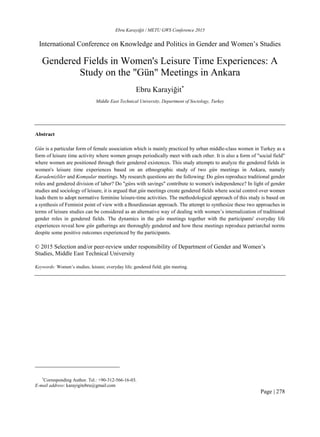
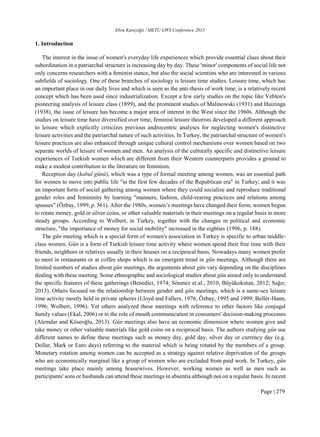
![Ebru Karayiğit / METU GWS Conference 2015
Page | 280
years, working women and men have started forming their own gün groups with their workmates where
they only rotate money.
The aim of this study is to explore the functions of gün meetings as a gendered field which is a specific
leisure time practice of Turkish women. My research questions are the following: Do güns reproduce
traditional gender roles and gendered division of labor? Do "güns with savings" contribute to women's
independence as a specific form of leisure activity among women? Older reception days were the fields of
women where they could gain a certain sense of "recognition" within their group. Today, along with the
"güns with savings", women’s freedom to use money is added to the function of recognition. The
information used in this study is based on an ethnographic study of two gün groups in Ankara:
Karadenizliler (from the Black Sea) and Komşular (Neighbors), respectively.
2. Conceptual Terrain
The concept of gender needs constant reworking and redefinition based on new empirical evidence since
gender relations undergo continuous flux and reinvention. In this sense, gün meeting is a fruitful area for
further research where different characteristics of gender such as difference, inequality and oppression are
experienced by women. Since mixed-sex socializing is incompatible with the norms of patriarchal control
such as gender segregation, gün meetings become an acceptable or appropriate way of socializing for
women. In this context, I define gün as a gendered leisure time activity of Turkish women. As argued by
Skeggs, we become gendered through being lived, just as we become classed, raced and sexed (1997, p 9).
Women and men become gendered through the social processes that produce gender. Beginning from earlier
ages, individuals take on gendered qualities and characteristics through learning masculinity or femininity
(Wharton, 2005, p. 31). I will analyze the gendered relations in gün meetings using the conceptual
framework of Pierre Bourdieu who studied social processes through the concepts of habitus, field, and forms
of capital when formulating his general theory of practice.
In Bourdieu's theory of practice, everyday life is the area where power relations both arise and are
continuously reproduced in different fields. He analyzes the processes in which actors consciously or
unconsciously internalize power relations with his concepts like habitus, field and symbolic violence.
Although Bourdieu has not much emphasis on gender, there are parallels between Bourdieu's theory and
Feminism since both of them stresses the experiences of actors and the role of power relations in social life.
For this reason, the methodological approach of this study is based on a synthesis of feminist point of view
with a Bourdieusian approach. Bourdieu's methodology shares the same principle with Feminism which
attributes a vital role to subjective experiences in knowledge production although it does not fundamentally
specify women's experiences.
2.1. The Concept of "Gendered Field"
I conceptualize my research topic, namely women’s gün meetings, as ‘gendered fields’. Hence I attend
to expand my research on gün meetings by drawing on Bourdieu's conceptual framework to understand
gendered relations better. Bourdieu's approach is one of the important attempts to build a link between
subjective and objective relations in social science. As Ritzer claims, this is the distinguishable
characteristics of Bourdieu's theory where he offered "a distinctive theory of the relationship between
agency and structure" (2011, p. 536). Bourdieu's famous concept habitus refers to "the mental structures
through which they [actors] apprehend the social world ... the product of the internalization of the structures
of that world" (Bourdieu, 1989, p. 18). Relationality is the critical aspect of Bourdieu's theory. As concepts,](https://image.slidesharecdn.com/59efbcce-7adc-4ccf-9a99-524cc539d6df-160605031959/85/My-published-research-294-320.jpg)

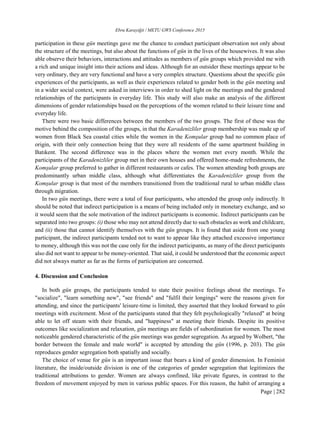

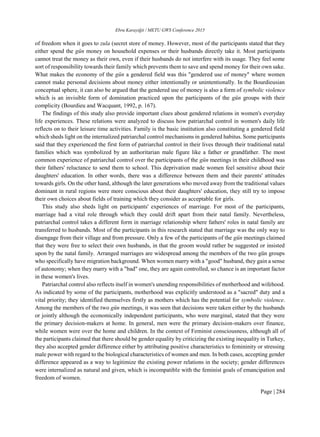
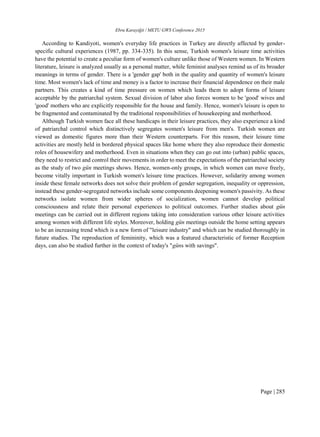
![Ebru Karayiğit / METU GWS Conference 2015
Page | 286
References
Alemdar, M. and Köseoğlu, Ö. (2013). Ağızdan Ağıza İletişim ve Satın Alma Karar Sürecindeki Rolü
Açısından Kabul Günlerine Yönelik Bir Tutum Çalışması, Akademik Araştırmalar Dergisi, Vol. 58, pp.
45-76.
Bellér-Hann, I. (1996). Informal Associations among Women in North-East Turkey, in Rasuly-Paleczek,
G. (ed.) Turkish Families in Transition, Frankfurt am Main; New York: Peter Lang, pp. 114-138.
Benedict, P. (1974). The Kabul Günü: Structured Visiting in an Anatolian Provincial Town,
Anthropological Quarterly, Vol. 47, No. 1, Visiting Patterns and Social Dynamics in Eastern
Mediterranean Communities (Jan., 1974), pp. 28-47.
Bourdieu, P. (1984). Distinction: A Social Critique of the Judgement of Taste, Cambridge, Massachusetts:
Harvard University Press.
Bourdieu, P. (1989). Social Space and Symbolic Power, Sociological Theory, Vol. 7, No. 1 (Spring,
1989), pp. 14-25.
Bourdieu, P. (2001). Masculine Domination, Cambridge, UK: Polity Press.
Bourdieu, P. and Wacquant, L. (1992). An Invitation to Reflexive Sociology, Chicago: University of
Chicago Press.
Büyükokutan, A. (2012). Geleneksel Altın Günlerine Halkbilimsel Bir Yaklaşım: "Muğla Örneği",
Karadeniz Sosyal Bilimler Dergisi, Vol.4 (14), pp. 117-133.
Delaney, C. (1991). The Seed and The Soil: Gender and Cosmology in Turkish Village Society,
University of California Press, Berkeley.
Ekal, B. (2006). How a Kaynana Should Behave? Discussions on the Role of Mothers-in-Law in Two
Gün Groups, European Journal of Turkish Studies, Thematic Issue, No.4, The Social Practices of
Kinship: A Comparative Perspective, pp. 1-17.
Huizinga, J. (1950 [1938]). Homo Ludens: A Study of the Play-Element in Culture, Boston: Beacon Press.
Huppatz, K. (2009). Reworking Bourdieu's 'Capital': Feminine and Female Capitals in the Field of Paid
Caring Work, Sociology, Vol. 43(1), pp. 45-66.
Kandiyoti, D. (1987). Emancipated but Unliberated? Reflections on the Turkish Case, Feminist Studies,
Vol. 13, No. 2 (Summer, 1987), pp. 317-338.
Krais, B. (1993). Gender and Symbolic Violence: Female Oppression in the Light of Pierre Bourdieu's
Theory of Social Practice, in Calhoun, C., LiPuma, E. and Postone, M. (ed.) Bourdieu: Critical
Perspectives, Chicago: University of Chicago Press, pp. 156-177.
Llyod, A. and Fallers, M. (1976). Sex Roles in Edremit, in Peristiany, J. (ed.) Mediterranean Family
Structures, Cambridge: Cambridge University Press, pp.243-260.](https://image.slidesharecdn.com/59efbcce-7adc-4ccf-9a99-524cc539d6df-160605031959/85/My-published-research-300-320.jpg)
![Ebru Karayiğit / METU GWS Conference 2015
Page | 287
Malinowski, B. (1931) Culture, in Seligman, E. R. A. (ed.) Encyclopedia of the Social Sciences,
Vol. 2, New York, Macmillan, pp. 621–46.
McLeod, J. (2005). Feminists Re-reading Bourdieu: Old Debates and New Questions about Gender
Habitus and Gender Change, Theory and Research in Education, Vol. 3(1), pp. 11-30.
Moi, T. (1991). Appropriating Bourdieu: Feminist Theory and Pierre Bourdieu's Sociology of Culture,
New Literary History, Vol. 22, No. 4, Papers from the Commonwealth Center for Literary and Cultural
Change (Autumn, 1991), pp. 1017-1049.
Özbay, F. (1995). Changes in Women's Activities both Inside and Outside the Home, in Tekeli, Ş. (ed.)
Women in Modern Turkish Society, London; Atlantic Heights, N.J.: Zed Books, pp. 89-110.
Özbay, F. (1999). Gendered Space: A New Look at Turkish Modernisation, Gender&History, Vol. 11,
No. 3 (Nov., 1999), pp. 555-568.
Ritzer, G. (ed.) (2011). Agency-Structure Integration, in Sociological Theory, New York: Mc-Graw Hill,
pp. 520-544.
Sağır, A. (2013). Gün Algısı ve Sosyalleşme: Safranbolu Örneğinde "Gün" Sosyolojisi Denemesi,
International Journal of Social Science, Vol. 6, Issue 5, pp. 477-496.
Skeggs, B. (1997). Introduction: Processes, Frameworks and Motivations, in Formations of Class and
Gender, London: Sage Publications, pp. 1-16.
Sönmez, G. et al. (2010). A Different Leisure Activity for Turkish Women: Invitation Day, World Leisure
Journal, No. 2, pp. 94-103.
Veblen, T. (2005 [1899]). The Theory of Leisure Class: An Economic Study of Institutions, New York:
New American Library.
Wharton, A. (2005). The Sociology of Gender: An Introduction to Theory and Research, Chichester, West
Sussex; Malden, MA: Wiley-Blackwell.
Wolbert, B (1996). The Reception Day- A Key to Migrant’s Reintegration, in Rasuly-Paleczek, G. (ed.)
Turkish Families in Transition, Frankfurt am Main; New York: Peter Lang.](https://image.slidesharecdn.com/59efbcce-7adc-4ccf-9a99-524cc539d6df-160605031959/85/My-published-research-301-320.jpg)
